

Is Oaxaca Safe to Travel to Right Now? [2024 Update]
Wondering, Is Oaxaca Mexico Safe right now?
That’s great! As someone who’s traveled solo all over Mexico, I know that keeping your personal safety a top priority is the best way to stay safe while traveling to Oaxaca, Mexico — or anywhere.
Now, let’s examine the Is Oaxaca safe for travelers? question.
For the past few years, Oaxaca has become one of the most popular Mexico destinations.
It is located in Southern Mexico, and sits right on the Pacific Ocean. The beaches of Oaxaca are some of the best beaches in Mexico, with soft golden sand, warm water and tropical vibes.
While Mexico is portrayed as a totally unsafe country in the mainstream U.S. media, know that millions visit Oaxaca each year — with most coming from the U.S., Canada and Europe.
If Mexico were as unsafe as it’s portrayed, people would just stop coming, right!? Well, they aren’t, so that might tell you something.
According to Mexico Secretary of Tourism statistics , an astounding 35 million international travelers visited Mexico from just January to August 2021. Even with all the sinister news reports, millions still flock to Mexico.
As a large country, looking at Mexico travel safety and Oaxaca travel safety are two different things, so let’s bring our focus down to Oaxaca itself.
In this article you’re going to discover everything you need to know about Oaxaca travel safety, so let’s get right to it.
Is Oaxaca Safe for travelers
Is oaxaca safe right now.
For the most part, Oaxaca is safe for the majority of visitors — and has been for some time.
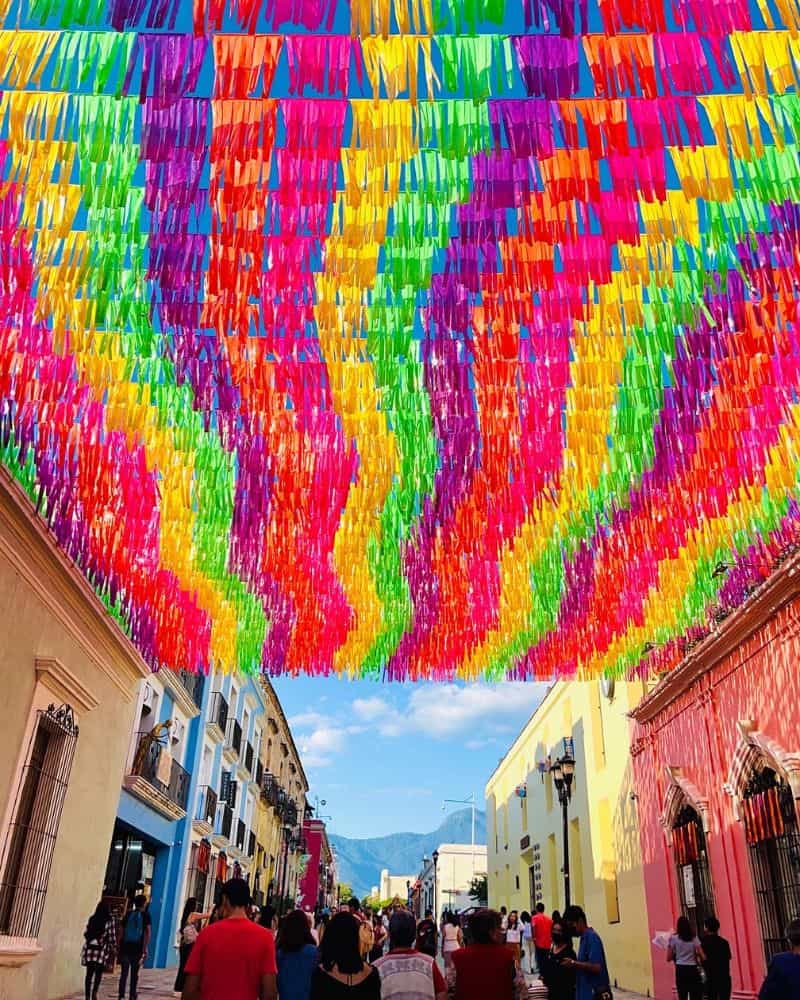
The biggest threats in Oaxaca are usually hangovers from drinking too much mezcal , and sunburns , hurricanes and mosquitoes on the beaches of Oaxaca .
However, no place on Earth is 100% safe, so it’s untrue to paint Oaxaca Mexico as a travel utopia.
As one of the poorest states in Mexico , petty crime in the tourist areas, including Centro Historico (Historic Downtown Oaxaca City) can absolutely happen.
In Oaxaca, you’ll need to always pay attention to your valuables, and never leave anything unattended.
If you’re visiting all the best mezcalerias (mezcal bars), watch your alcohol intake, never take a drink from a stranger and never leave your drink unattended with strangers.
Crime in Oaxaca Mexico
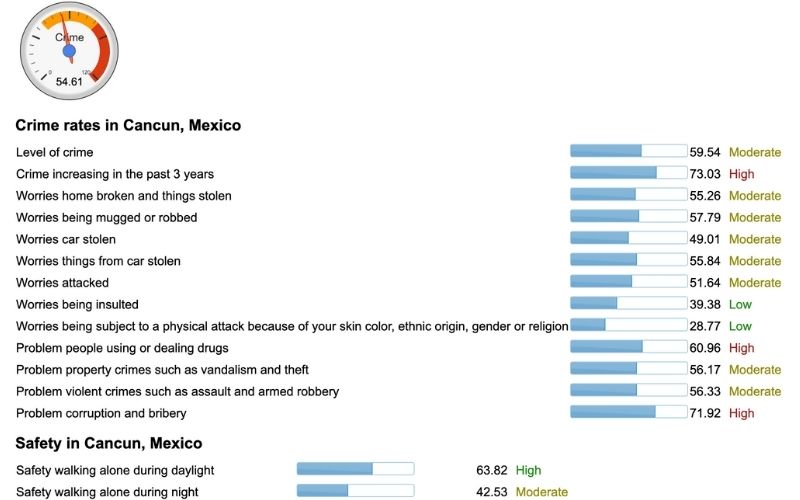
As with most tourist towns, petty theft and crimes of opportunity aren’t uncommon in Oaxaca.
This isn’t a huge problem, and if you don’t leave your valuables unattended and stay aware of your surroundings, you likely won’t be a victim of petty crimes in Oaxaca.
Shootings in Oaxaca Mexico
In recent years, there have been a few reports of shootings in Oaxaca Mexico.
As with most violence in Mexico, these shootings usually have direct ties to the cartels. However, violent acts will jar anyone’s sense of safety, especially innocent bystanders.
In late-2021, there was a shooting in a bar in Oaxaca City, and a young woman named Jazmín lost her life when hit by a stray bullet.
While I can’t say definitely this won’t happen again, I can say it’s a rare occurrence — and largely related to the cartels, which you can easily avoid.
Drugs & Cartels in Oaxaca
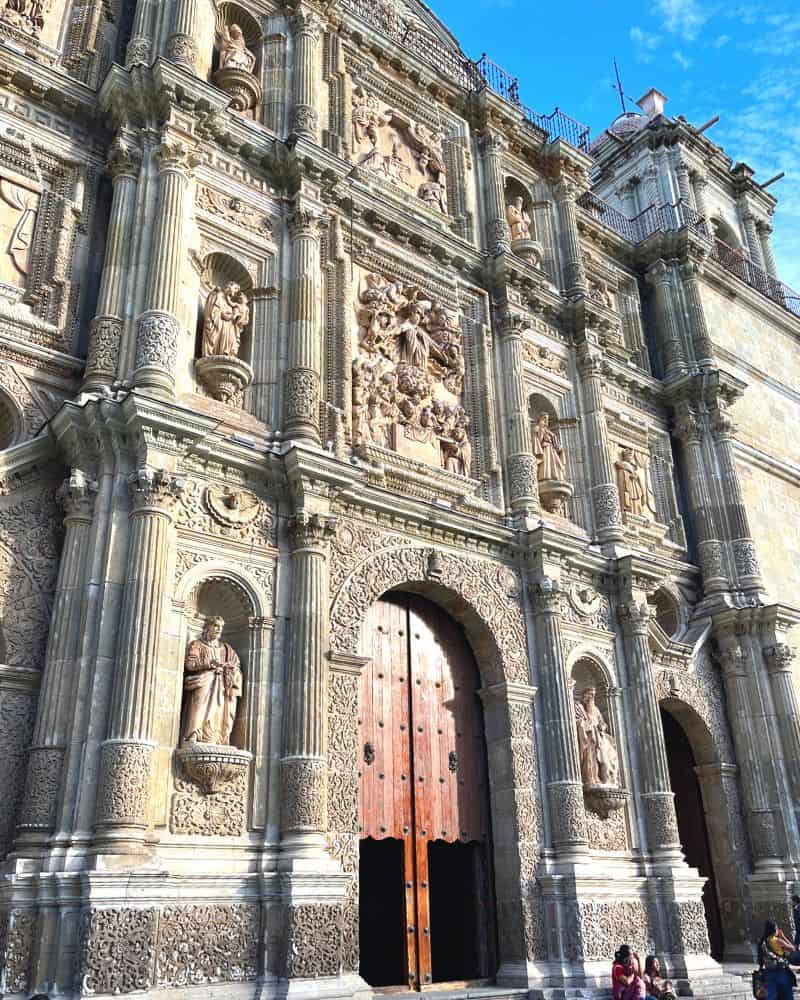
The Mexican drug cartels cast such a dark shadow on an otherwise amazing country. As I live in Mexico, I know first-hand what a meta topic this is, and I try to navigate it carefully.
What I do know is not buying drugs in Oaxaca is the best way to avoid the cartels, and not support them.
I’ve lived in a few places in Mexico, including Tulum and Playa del Carmen , both located just south of Cancun . There is definitely a cartel presence in these areas, as three of the biggest Mexico party towns.
By comparison, you rarely get offered to buy drugs in Oaxaca City. However, it can happen on the beaches of Oaxaca, particularly Puerto Escondido , which has a big party scene.
If you are approached, a simple no gracias , and they will leave you alone. If you’re out somewhere and get approached by multiple people in a row, it might be a good idea to find another place to hang out.
This is the best advice I can offer for Oaxaca safety: Avoid anything related to the cartels, don’t buy drugs off them, and stay as far away from them as physically possible — and you’re well on your way to safe travels in Oaxaca Mexico.
Oaxaca Travel Advisories for Mexico
For any official travel advisories for Oaxaca, check the U.S. State Department website here . Keep in mind they evaluate state by state, not city by city, so it’s not always easy to get an accurate picture of the situation in Oaxaca City itself.
🇲🇽 Wondering what state is Oaxaca in? Oaxaca de Juarez (AKA Oaxaca City) is the capital of Oaxaca state.
As someone who lives in Mexico, I know there are safe places in Mexico , and unsafe places. Top Mexico travel destinations, like Oaxaca, are mostly safe.
Oaxaca tourism and tourism in general is a huge part of Mexico’s economy, so the government makes sure it stays safe so visitors keep coming back.
This is not to say that bad things don’t happen in Oaxaca; they do. However, isolated incidents happen everywhere — even your hometown.
The way to stay safe in Oaxaca is to use common sense, listen to your intuition, stay aware of yourself and surroundings and don’t buy drugs.
Best Travel Insurance for Mexico
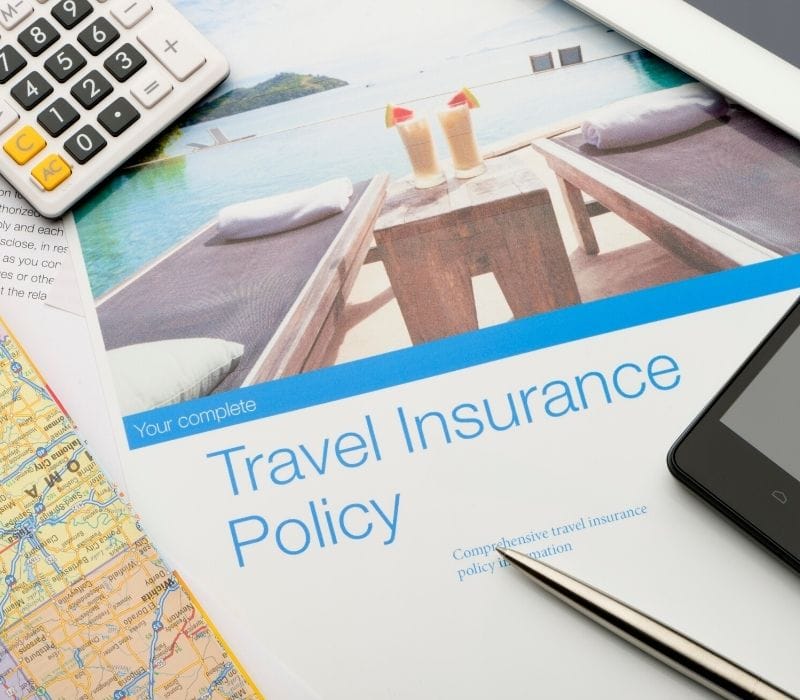
In an article focused around safety, I’d be remiss not to discuss travel insurance for Oaxaca. Just as you insure your car, home and body, you can also insure your luggage, belongings and health while traveling.
For me, Mexico travel insurance is a must — as it can mean the difference between a $2,000 hospital bill and a $2 hospital bill if you get sick in Oaxaca.
If Oaxaca travel safety is on your mind, get your FREE quote below from World Nomads and Safety Wing, two of the biggest names in travel insurance.
⭐️ World Nomads travel insurance
They have the Standard Plan with general travel coverage, and the Explorer Plan , for those who want to do adventurous activities while traveling in Oaxaca, like climbing the Monte Alban Ruins or surfing in Puerto Escondido .
Plans average about $7 USD per day .
⭐️ Safety Wing Digital Nomad insurance
Safety Wing is the best Mexico travel insurance for digital nomads and long-term travelers who plan to stay a while.
Plans start at only about $42 USD per month — so this is a no brainer — as you get both medical travel insurance and general travel insurance.
Is Oaxaca safe for solo travelers?
For the most part, Oaxaca is safe for the majority of solo travelers — and this does include solo female travelers in Mexico .
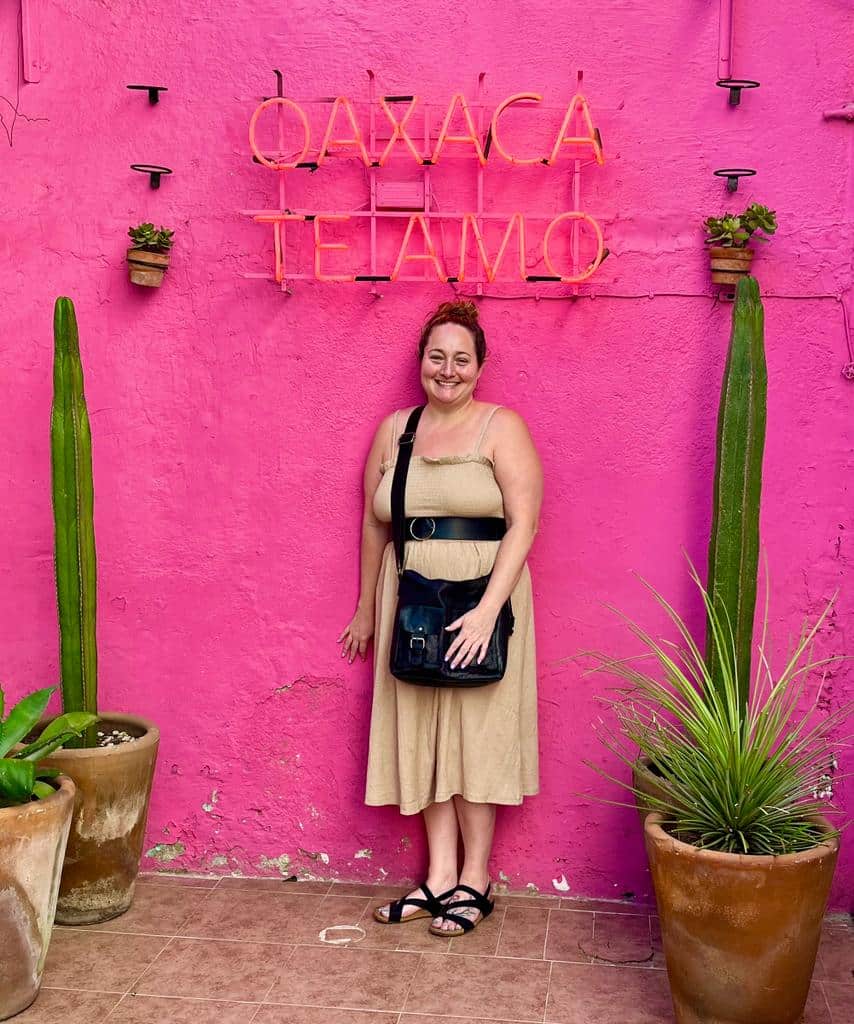
Mexico gets a bad wrap in the mainstream media, and perhaps you’ve been warned not to do any Mexico solo travel , but make sure you consider the source.
As you probably know, the news has a habit of reporting the doom and gloom side of life because that’s what sells.
If you know any solo female travelers, especially those who have done solo travel in Mexico , consider asking them.
The best information on solo female travel comes from women who have actually done it — and those who have will likely encourage you to go.
Oaxaca attracts all kinds of travelers, from honeymooners and families, to luxury and solo travelers.
It is considered safe for solo travel in Mexico because there are many solo travelers so it’s easy to meet others, especially if you’re staying in one of the best Oaxaca hostels .
IS OAXACA SAFE TO TRAVEL ALONE?
As someone who’s traveled solo all over Mexico, I consider Oaxaca safe for solo travel in Mexico.
I know I am just one voice in this conversation, so check out this first-hand account from Poonam, a Canadian woman who has also done solo travel in Oaxaca.
Group Tours in Oaxaca
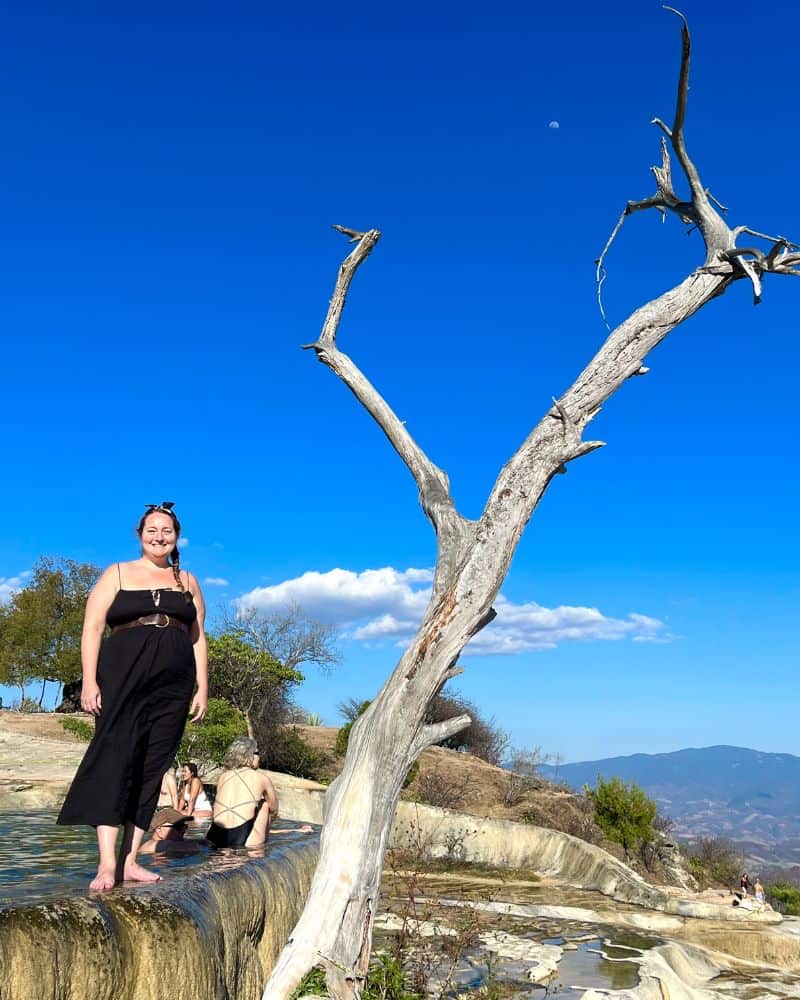
Just because you’re doing solo travel in Oaxaca Mexico, doesn’t mean you have to be solo all the time.
Solo travel just means you’re the sole person who gets to decide what you do with your precious travel time while on your Oaxaca trip.
If there’s somewhere you’re not comfortable going alone, or you just don’t feel like dealing with how to coordinate transportation there, book a group tour.
They are a great way to meet other travelers (often other solo travelers), and offer a safe way to see the Oaxaca sites.
🇲🇽 Two great places to book Oaxaca tours are Viator and Airbnb Experiences .
Is Oaxaca safe for families?
In general, Mexico is a pretty kid-friendly country — they even celebrate the Día del Niño (Children’s Day holiday) on April 30th each year.
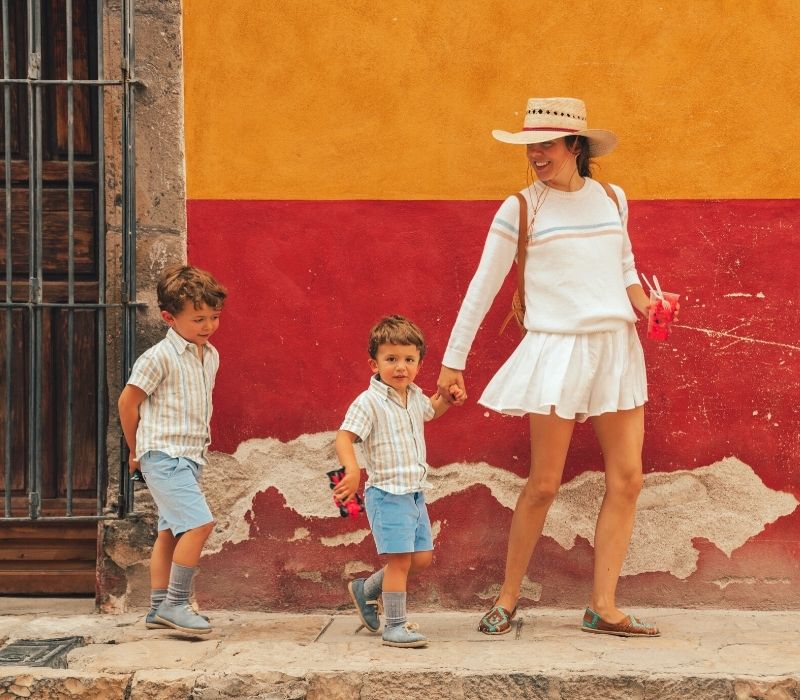
There’s no reason to think that kids and families are any less safe in Oaxaca than solo travelers, couples and group travelers. The same standard Oaxaca safety tips apply across the board, from families to all travelers.
These include not walking home at night, staying aware of your belongings, and going with group tours when you’re venturing off the beaten path.
There are so many things to do in Oaxaca City , but for kids who love being out in nature, there’s plenty to see just outside of the city.
For outdoor activities, don’t miss Hierve el Agua , Zapotec villages in the Pueblos Mancomunados and the Apola Waterfalls .
Is Oaxaca safe at night?

The population of Oaxaca City is about 300,000, so Oaxaca is a pretty small town. Because of this, walking alone at night isn’t considered too dangerous.
However, always listen to your intuition, meaning that if it feels safer to take a taxi ride instead of walking, do that. While there’s no Uber in Oaxaca , taxis operate all day and night.
⚠️ Oaxaca Safety Tips: Watch your mezcal intake
While I won’t tell anyone to go to Oaxaca and stay sober if that’s not what you want — I will say to go easy on the mezcal and stay extra alert when visiting the Oaxaca mezcal bars .

🥂 Planning to party hardy? Liquid IV hydration multiplier is a game changer in the fight against hangovers! With more than 86,000 Amazon reviews, you know it works.
Safety always goes way down when there’s a lot of booze involved, but again, I’m not here to lecture you.
Also, never take drinks from strangers in Oaxaca (or anywhere) — even cute strangers — and don’t leave your drink unattended with a stranger. If you’re headed to the restroom, take your drink with you for safety’s sake.
Tourist Scams in Oaxaca
There aren’t a ton of things you need to be aware of while traveling to Oaxaca Mexico , but there are some common tourist scams in Oaxaca to be aware of.
These things aren’t exactly the norm, but you’ll want to know about them for the sake of staying safe in Oaxaca.
🏧 Oaxaca ATM Scams

Many places in Oaxaca are cash only, so you’ll need to use ATMs in Oaxaca.
They’re located all over town, but the safest ATMs in Oaxaca are inside banks, and not just on the street. If there’s a problem, you’re already at the bank so staff can assist you, which isn’t the case at street ATMs.
Besides street ATMs, I’d also avoid ATMs inside convenience stores.
These are often privately owned, and if something happens, like it takes your card or never dispenses your cash, it’s often impossible to find the owner and get a refund, or get your card back.
🚔 Police Corruption in Oaxaca
In Facebook groups for expats and digital nomads in Oaxaca, like Expats Oaxaca , you can read past posts about corruption by police officers in Oaxaca.
It’s not that all cops in Oaxaca and Mexico are corrupt, but the bad ones certainly ruin it for the good ones.
For the most part, police will only approach you if you’re breaking any laws. One of the best ways to attract police attention is by being drunk and acting rowdy in public, so you don’t want to do that.
If you’re renting a car in Oaxaca , be sure to obey all Mexico driving laws. Driving in Oaxaca is pretty straightforward, but you still need to remain mindful of laws and rules at all times.
🚙 Oaxaca Car Rental Scams
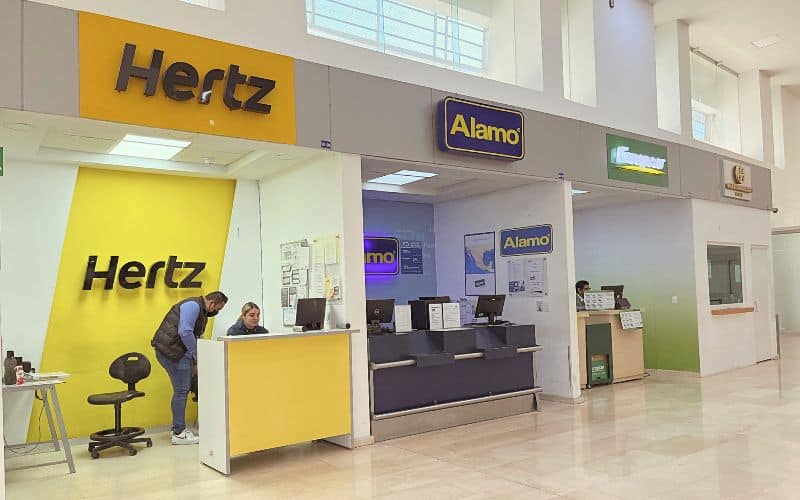
If you’re getting a Oaxaca car rental , make sure to take photos of the entire car, including the interior, in case there are any disputes when you return it.
Head here for more information on common Mexico car rental scams.
🚨 Robberies in Oaxaca
While not incredibly common, robberies and theft in Oaxaca can happen.
When packing for Mexico , you’ll want to leave all valuables at home. Also, only carry a small amount of cash on you — $1,000-1,500 pesos (about $50-75 USD) should be more than enough for the day.
👗 Wondering what to wear in Oaxaca Mexico?
Oaxaca has a desert climate, so is quite hot during the day, and cool to cold at night. For outfits, think flowy sundresses by day, and layers by night.
Need more info? ▶︎ Head here for a Mexico outfits guide
Safest and Best Oaxaca Neighborhoods
As with most places on Earth, safety can come down to what parts of town you plan to stay in and hang out in. Like all cities, Oaxaca has safe areas and areas you might want to avoid (especially at night).
So, let’s examine where to stay in Oaxaca so you’re in a safe area.
Centro Historico: Downtown Oaxaca

Downtown Oaxaca City isn’t very big — think 45 square blocks. For first time visitors, you’ll find staying in Centro (Downtown Oaxaca) , as close to the Zocalo as possible, very convenient.
This area is very walkable, and you’re near all the best restaurants , shops, mezcal bars , museums, markets , pharmacies, ATMs, etc.
There’s no Uber in Oaxaca , though you can always hail a cab. The city has public buses, though Oaxaca public transportation isn’t great overall.
▶︎ Need a rental car in Oaxaca City? I recommend and personally use Discover Cars for all my Mexico car rentals. Head to this linked article for more info on renting a car in Oaxaca .
Jalatlaco: Best Neighborhood in Oaxaca
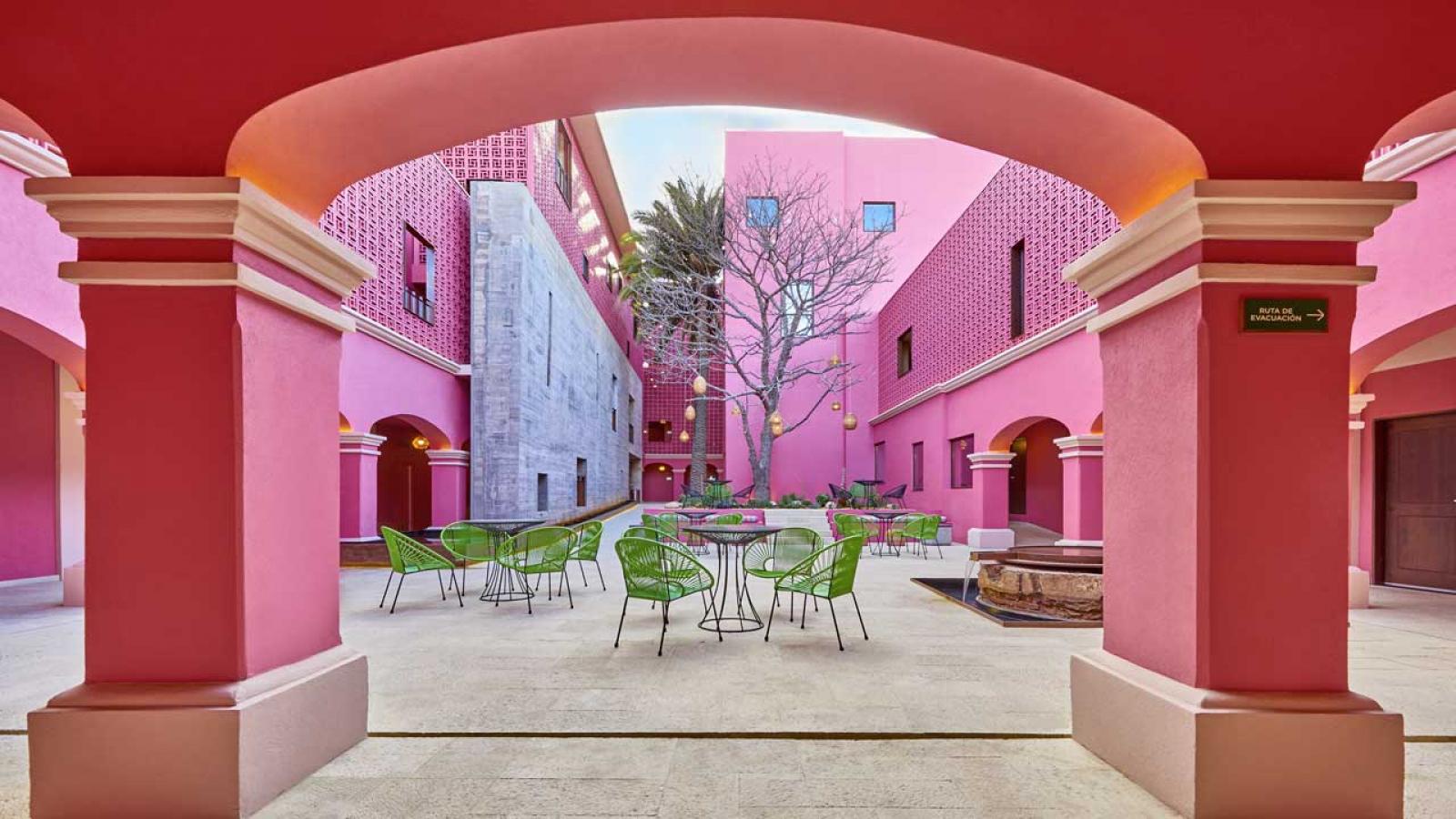
Love street art , colorful buildings and cute cafes
Then head to the hippest of all Oaxaca neighborhoods — Jalatlaco (pronounced ha-lat-lack-oh). It is located just outside of Centro Historico and the Zocalo, and makes for a fun, leisurely place to just stroll around.
🤔 Not sure where to stay in Oaxaca City?
There are some great places here, and it’s less touristy than Centro Historico so you get a more authentic locals’ vibe.
Of the best hotels in Jalatlaco, you’ll fall in love with City Centro Hotel , the famous pink hotel in Oaxaca City.
Xochimilco Oaxaca City

This is Oaxaca City’s oldest and most historic neighborhood, Xochimilco (pronounced so-chee-mill-co) is located just north of Centro.
You will still get the old school colonial city feel and look in this neighborhood, but you’ll be further away from the crowds. (Don’t miss the 18th century aqueduct that runs along Callejon Rufino Tamayo street.)
Being slightly on the outskirts of Centro Historico in this hisoric barrio (neighborhood) means you get great value at Oaxaca boutique hotels — like Casa de Arte and El Callejón Hotel .
How do you get around Oaxaca City?
Oaxaca City is walkable, so if you’re just staying in the city itself, you can walk and use taxis and public transportation as needed.
If you’re doing Oaxaca day trips , a rental car or group tour is your best bet, and I recommend booking Oaxaca tours via Viator and Airbnb Experiences .
Is there Uber in Oaxaca?
No — There is no Oaxaca Uber service, and no Lyft in Oaxaca either.
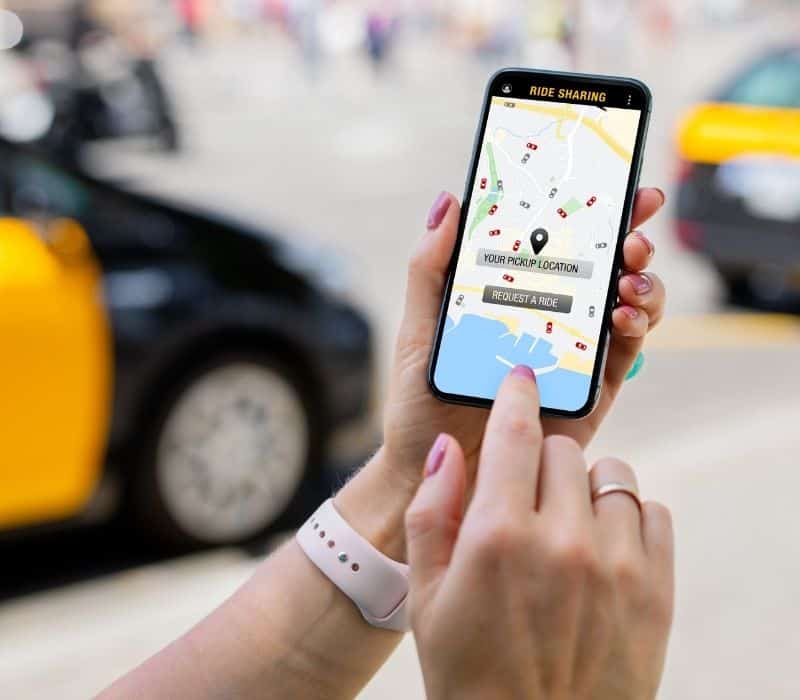
They do have DiDi Taxi through the DiDi Rider app, which lets you call a Oaxaca taxi via the app. It’s basically like using Uber or Lyft, but you will get a regular cab.
- Download DiDi Rider for iPhone
- Download DiDi Rider for Android
- Note: If you want to use the DiDi Rider app, make sure you have a Mexico SIM card with data so you can call one when you need it.
Are taxis safe in Oaxaca?
For the majority of travelers, yes , taxis are perfectly safe to use in Oaxaca City.
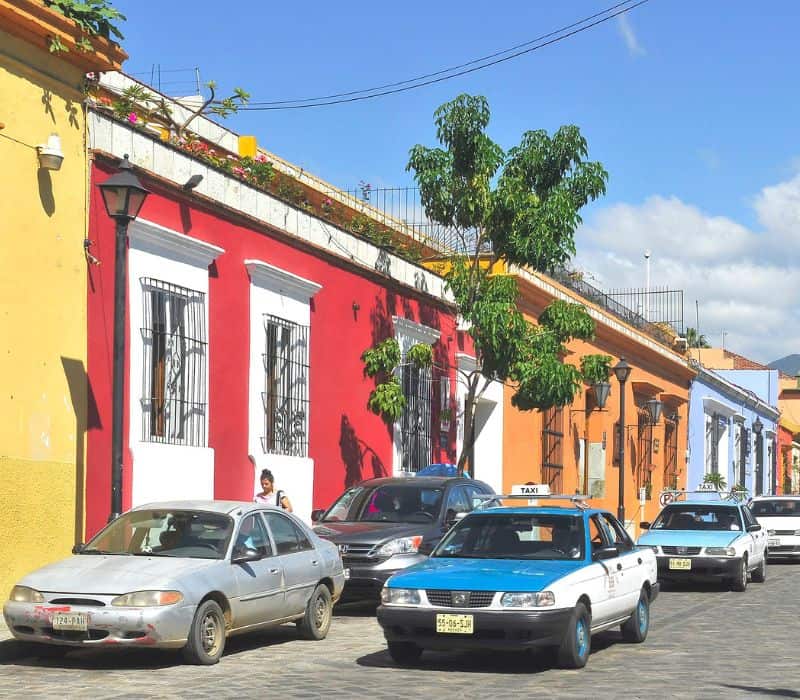
I personally prefer to call taxis via the DiDi Rider app, so I have a record of my trip, I can share the trip status with someone else, the price is already set for me, and I don’t have to pay in cash.
Renting a Car in Oaxaca Mexico

Renting a car in Oaxaca City gives you the freedom to venture off the beaten path on day trips from Oaxaca , and the freedom to explore at your own pace.
With tours, you only get a limited amount of time in each place, but with your own rental car, you set the schedule.
SHOULD I RENT A CAR IN OAXACA CITY?
If you are only planning to stay in Oaxaca City itself, you probably won’t want a rental car.
The public transportation in Oaxaca isn’t great, but you can always use DiDi Taxi and regular Oaxaca taxis. You can also take these best Oaxaca tours in lieu of driving a rental car.
Is it safe to drive in Oaxaca?
For the majority of visitors, it’s perfectly safe to drive in Oaxaca City and the surrounding areas.
You’ll want to exercise more caution than usual, as Oaxaca roads aren’t always well-maintained. Also, avoid driving at night because many roads aren’t well lit, or lit at all.
Since you’ll be driving in another country, where you’re unfamiliar with local driving laws, make sure to check out these 10 Oaxaca Mexico driving tips .
They will help you get comfortable with how to drive in Oaxaca state, and how to drive anywhere in Mexico.
🚙💨 Driving from Oaxaca City to the beaches of Oaxaca

Wondering, Does Oaxaca have beaches? , or if there are beaches near Oaxaca City. From Oaxaca City to the nearest beach, it is about 160 miles (260 km) and usually takes about 6-8 hours of driving.
Check out these guides on how to safely get from Oaxaca to the beaches — Oaxaca to Puerto Escondido and Oaxaca to Huatulco . For safety info, check out the links below for Puerto Escondido, Mazunte and Huatulco safety:
- Is Huatulco Safe?
- Is Puerto Escondido Safe?
- Is Mazunte Safe?
Bloqueos: Oaxaca Road Protests
Though not common, road protests in Oaxaca do happen from time to time, and can add hours to the trip.
These bloqueos, or blockades, happen when locals are protesting and essentially shut down the road that passes through their part of town.
Unfortunately, there is no way to predict these, and really no way to tell how long they will last when they do happen.
As an absolute worst case scenario, I have heard of people having to stay the night in the town the bloqueo is happening in — though this is extremely rare.
Is public transportation safe in Oaxaca?
For the most part, public transportation in Oaxaca is quite safe.
Of course, you’ll want to be mindful of your belongings at all times because crimes of opportunity can happen in even the safest of places. Here’s a rundown of your Oaxaca public transportation options:
ADO: Best Buses in Oaxaca

Bus transport in Mexico is safe, inexpensive and convenient. It is used by both locals and visitors alike.
ADO is the largest Mexico bus company, with a fleet of luxury buses. There are also second class buses, but for only a few dollars more, the luxury ADO bus is absolutely worth it.
Note: The ADO website is not user-friendly and doesn’t take United States credit cards, so you’ll want to book your Oaxaca bus tickets via GuateGo.
🚌💨 Mexico City to Oaxaca Bus
In this class, you’ll enjoy the large, comfy, recliner seats and outlets at each seat for your gadgets. These only cost a few dollars more than the budget class buses, but you get a much more comfy ride.
Oaxaca Colectivos (Shared Vans)

A colectivo (AKA camioneta) is a shared passenger van that seats between 10-12. These are the cheapest way to get around in Oaxaca, popular with budget travelers and locals.
Prices vary, but you’ll usually never spend more than $50 MXN pesos ($2.50 USD) per ride.
Most companies in Oaxaca use Nissan Urvans, Toyota Hiace or Dodge Sprinter vans. The vans themselves are comfortable enough, and well-maintained, but don’t expect any extras like AC.
The one caveat I give is that if you don’t speak Spanish, it’s not always easy to use the colectivos in Oaxaca. There aren’t online schedules for colectivos, so your best bet is to ask a local to direct you to the one you need.
You’ll have to at least know the direction you’re headed, then head to a main road, and look for a line of people — they are usually waiting for the bus or colectivo.
Is street food in Oaxaca safe?
Yes — Millions of people eat Oaxaca street food every single day, and in fact, it’s some of the best Oaxaca food you’ll eat while you’re there.
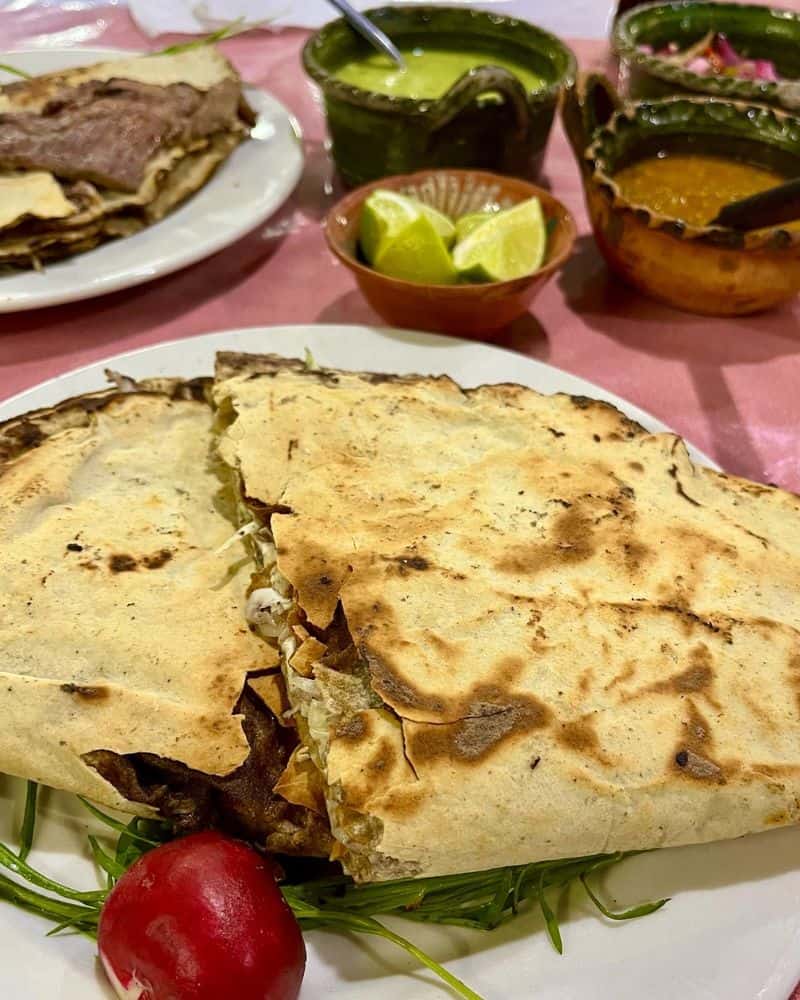
That’s not to say people don’t also get sick while traveling to Oaxaca; they do.
The truth it this: Getting food poisoning in Mexico is a bit of the luck (or unluck ) of the draw.
Don’t assume just because food is cooked on the street and not in a building, that it’s automatically bad or unsafe to eat because that is just untrue.
Since moving to Mexico in 2018, I’ve seen people who only eat in high end restaurants get a bad case of Montezuma’s Revenge (AKA Traveler’s Diarrhea, or TD).
I’ve also seen people who exclusively eat street food, but don’t get sick, and have the trip of their lives.
The reality is leaving your home country to visit another is risky on your stomach, as you’re not acclimated to what’s in that country’s food and water.
To some extent, all food and water have bacteria, but your body knows how to handle the ones you come in contact with often.
How to pick the best Oaxaca street food
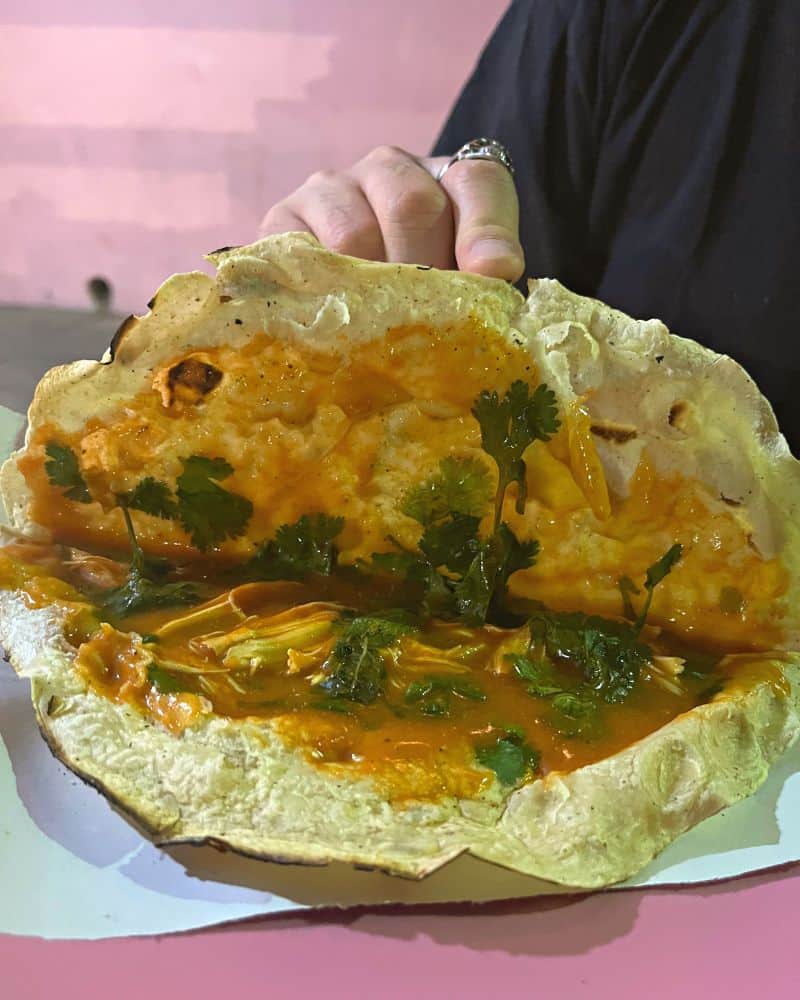
Wondering where to NOT eat in Oaxaca? Sadly, there are no hard and fast rules.
The tips you’ll find below aren’t an exact science, but they’re a good line of defense to help ensure you’re one of the people who doesn’t get sick in Oaxaca from the food.
1. Look for long lines: Long lines mean a good reputation for both their food, and their hygiene.
2. Look for taxi cabs: Cab drivers drive around all day, so they can eat anywhere they want — because of this, they also know where all the delicious, inexpensive, hygienic places are.
3. Look for two employees: Make sure there are at least two people working, and that the one cooking the food is not the one handling the money.
4. Look for hand sanitizer: If you don’t see a bottle of hand sanitizer, skip that stand for one that has some.
5. Look at yourself: Remember that your own hands are one of the dirtiest parts of your body, and you’re about to use those to eat! When possible, wash your hands before eating, and use hand sanitizer liberally.
Can you drink the water in Oaxaca?
No — Oaxaca Mexico tap water isn’t safe for human consumption.
Know that this does mean “all humans,” including Oaxaca locals, Oaxaca visitors, and even Oaxaca Mexico expats like me . I have lived in Mexico since 2018, and still don’t drink unfiltered Mexico water.
WHAT’S IN THE WATER IN MEXICO THAT MAKES YOU SICK?
Just like in the United States, tap water in Mexico has tiny microscopic organisms invisible to the naked eye.
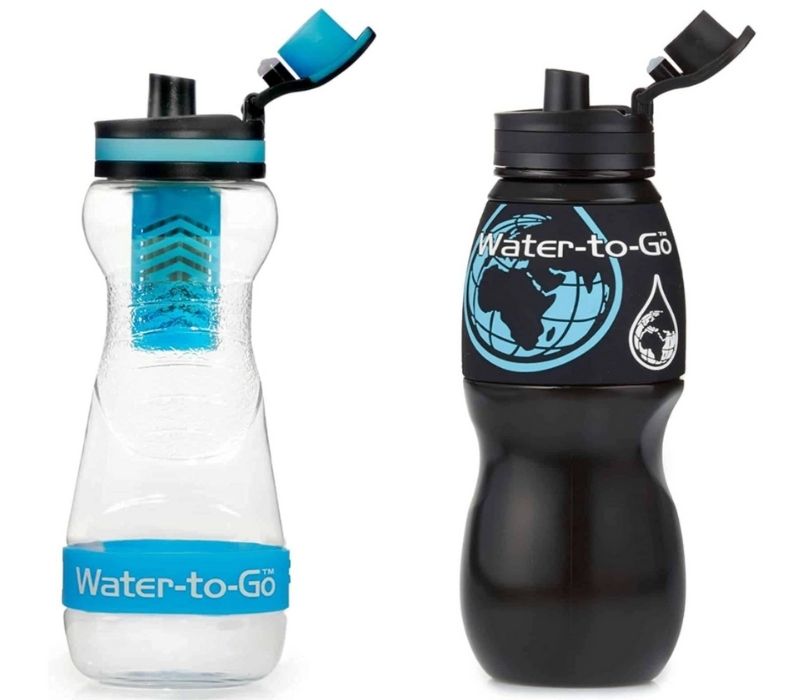
Single use plastics from bottled water are horrible for the planet. Do your part and travel with a reusable bottle from Water-To-Go. Use code SOLO15 for 15% OFF your entire purchase .
The important thing here is these are often different microorganisms than you’re used to in the U.S. — but that doesn’t mean they are any better or any worse; just different.
In recent years, Mexico water filter standards have improved, but still aren’t safe enough. For this reason, I recommend Oaxaca travelers get a Water-To-Go Bottle .
According to their website , the 3-in-1 filter membrane removes 99.9999% of all water-borne contaminants.
Top 15 Oaxaca Safety Tips for Mexico Travelers

Millions of visitors travel to Oaxaca each year to soak up the rays on the best Oaxaca beaches , eat a whole lot of tacos and Oaxaca food , stroll historic Downtown Oaxaca City, climb the ancient ruins at Monte Alban, swim in the thermal pools at Hierve el Agua … and more!
Before I go too far and make Oaxaca sound like some kind of travel utopia, I’ll stop here and say there are definitely some things to remain aware of.
While in Oaxaca, you’ll want to keep safety as your top priority by following the 15 tips below in this Oaxaca safety guide.
1. Stay Hydrated
Most people don’t associate hydration with safety, but the better hydrated you are, the more clear you are mentally.
If you’re hydrated, you’re making great decisions and able to stay alert and aware of yourself, your valuables and your surroundings at all times.
Can y ou drink the water in Oaxaca?
Unfiltered tap water in Oaxaca is not safe to drink, but you will need to drink plenty of water. Reusable Water-To-Go Bottles have a three-stage water filter so you don’t get sick in Mexico.
2. Brush up on your Spanish
It’s always a good idea to brush up on your Spanish before traveling to Mexico, just in case.
Download the free Duolingo App and get in a little practice before your Oaxaca vacation, so you’re comfortable with everyday basics and casual niceties.
👩💻 Looking for a more structured language learning program? Rocket Spanish will have you confident and conversational in just a few modules.
3. Ask Locals for Advice
No one knows their town like a local, and getting the advice of a local can be a travel game changer.
Mexicans are some of the friendliest people on Earth, so don’t be afraid to chat up your neighbor in a cafe, your server or bartender, a shop owner, etc.
4. Check In with Family and Friends
Set a regular time to check in with your family and friends back home. For some travelers, you’ll want to check in with a daily phone call, but for others, a text every other day will suffice.
You can even set up a group chat via text so you check in with everyone at once.
5. Get a Mexico SIM Card

The easiest way to check in with family members and friends back home? With a Mexico SIM card !
If you want to be able to use your phone in Oaxaca (who doesn’t?!) , you’ll need a Mexico phone plan, as there’s not generally free public WiFi in Oaxaca.
Telcel is the largest cell provider in Mexico, so you’ll want one of their SIM cards so you get the best service in the most places.
For most travelers, a 3GB card will be more than enough for a week in Oaxaca, but if you think you’ll need more, there are 4GB cards and 8GB cards .
6. Carry Cash at all times
Not all businesses in Oaxaca take credit cards, especially mom and pop shops, so make sure you always have pesos on you. If you’ll be taking a lot of taxis and buying street tacos, you’ll need to pay for those in cash.
7. but don’t carry too much cash
For most travelers, $1,000-1,500 pesos a day ($50-75 USD) will suffice.
One of my best Oaxaca tips is to use your credit card whenever possible, but in places you can’t, then pay with cash. Always try to reserve your cash, so you don’t have to keep going to the ATM in Oaxaca.
8. Don’t keep your cash in one place

You’ll want to divide your cash, so it’s not all in your wallet. In the unlikely event you get robbed or lose your wallet, you’ll want to have a reserve of cash on you to get safely back to your hotel or accommodation.
There are great items available nowadays to keep your money protected while traveling.
These money belts have been around for a while now as an inconspicuous place to hide money. In recent years, these hidden bra wallets have also become a travel safety must have.
9. Dress to Blend in
Mexicans tend to dress on the more modest side, so to blend in, you’ll want to do the same.
For the record, this isn’t about telling anyone how to dress — rather, it’s about reminding you that in order to not look like a tourist, you’ll need to look like a local.
👗 Wondering what to wear in Oaxaca City? Oaxaca has a desert climate, so it’s hot during the day, and cool to cold at night. For outfits, think flowy sundresses by day, and layers by night.
10. Never accept drinks from strangers
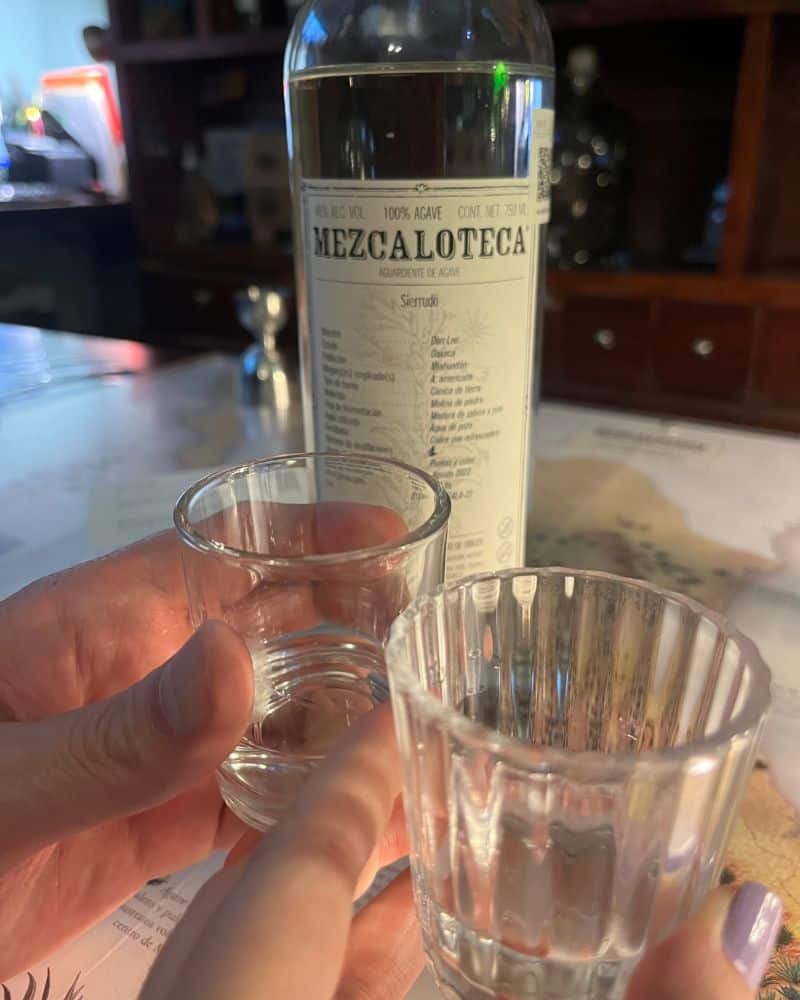
Never take drinks from strangers in Oaxaca (or anywhere), and yes, this even applies to cute strangers.
Also, don’t leave your drink unattended with a stranger, so if you’re headed to the restroom, you’ll want to take your drink with you for safety’s sake.
11. Go easy on the drinks
While I won’t tell anyone traveling to Oaxaca to stay sober and not imbibe, I will say to go easy on the mezcal as it’s very strong.
Safety always goes way down when there’s a lot of booze involved, which I’m sure you already know, but consider this your friendly reminder.
12. Stay in the best neighborhoods in Oaxaca
For first time visitors, you’ll find staying in Oaxaca Centro (Downtown) near the Zocalo very convenient, as it’s super walkable.
There’s also the colorful and artsy Jalatlaco neighborhood, and Xochimilco , the most historic neighborhood in Oaxaca — all three are great options.
13. Be extra careful at night
As with many places in the world, most crimes in Oaxaca occur at night. Besides being extra careful at the bars in Oaxaca , you’ll also want to be extra careful when walking alone at night.
Personally, I always take a taxi home at night, and recommend you do the same.
⚠️ In the event of an emergency while traveling to Oaxaca, call 9-1-1.
14. Leave valuables at home
Leave all of your designer clothes, purses, sunglasses and electronics at home. Oaxaca is one of the poorest states in Mexico, so you don’t want to flaunt your wealth — or make yourself a convenient target.
15. Don’t buy drugs in Oaxaca
I can’t stress enough that you must avoid the Mexico cartels at all costs.
Besides not supporting the cartels directly, buying drugs in Oaxaca can obviously land you in jail in a foreign country — and do you want to spend part of your vacation in Oaxaca in jail? Of course not.
Is Oaxaca safe to live?
For the most part, Oaxaca City is pretty safe for visitors, expats and locals.
That’s not to say bad things don’t happen in Oaxaca City; they do. However, isolated incidents happen everywhere — even your hometown.
🗣 To get a better idea of life in Oaxaca City, you can start a conversation with people who are actually living in Oaxaca via Facebook groups like Expats Oaxaca .
However, no place on Earth is 100% safe, so to make a blanket statement that “Yes, Oaxaca is safe to live,” wouldn’t be accurate.
As one of the poorest states in Mexico , you will have to be mindful, but overall, the Oaxaca crime rate is pretty low.
If you’re considering moving to Oaxaca, you’ll want to learn Spanish. While there’s a large Oaxaca expat population, most Oaxacans don’t speak English.
You can use Duolingo for free, but the structured program Rocket Spanish provides is much more effective.
Earthquakes in Oaxaca
Besides personal safety, you should be aware that there are Oaxaca earthquakes.
The majority of earthquakes to hit the state of Oaxaca won’t be felt in Oaxaca City directly, but this is absolutely possible as the majority of Mexico is within the Ring of Fire .
Oaxaca Healthcare

The private Mexico healthcare system is excellent. In fact, some Americans travel to Mexico as medical tourists to get procedures done at a fraction of what they cost in the U.S.
Prescription drugs are also much cheaper in Mexico and South America than the U.S.
DOES MEXICO HAVE FREE HEALTHCARE?
Yes — All Mexican citizens are entitled to free universal healthcare at public hospitals. However, you must be a full citizen to use it.
Most Oaxaca expats will buy pricate insurance through a provider like SafetyWing — which has plans that start at just $42 USD per month.
On a personal note, I have been a happy customer of SafetyWing Insurance since 2022.
Best Hospitals in Oaxaca
There are both state-run hospitals and private hospitals in Mexico and Oaxaca. As you might imagine, the private hospitals are much nicer.
In these, you usually get English-speaking medical personnel as well, so if you’re sick in Oaxaca, head to these hospitals:
- Clinica Hospital Carmen in Downtown
- Hospital Reforma in Downtown
- Hospital del Valle in the Reforma neighborhood near Downtown
Oaxaca Mexico Travel: Frequently Asked Questions
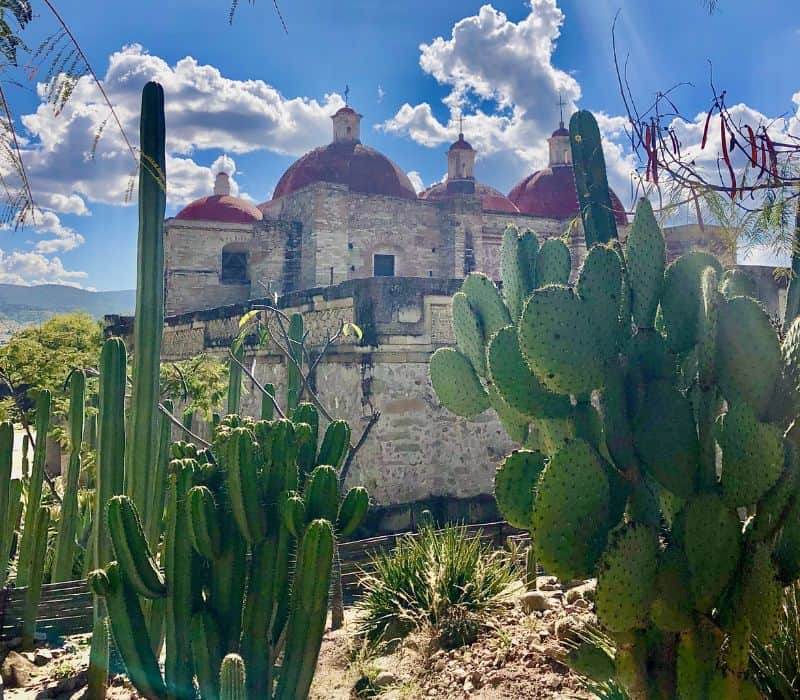
How do you pronounce Oaxaca?
Wondering about the Oaxaca pronunciation? It’s a common question, so if you are, you’re not alone! The word Oaxaca is pronounced waa-haa-kah.
Where is Oaxaca located?
Oaxaca is a state in southern Mexico, surrounded by other Mexican states like Chiapas and Puebla.
Oaxaca Map 🗺️
The southern edge of the state sits on the Pacific Ocean. Oaxaca City is the state’s capital city, and located about six hours south of Mexico City , you can book direct flights.
What’s the closest Oaxaca Airport?
Wondering, Is there an airport in Oaxaca City? Yes, there’s Oaxaca International Airport (code: OAX), located about 20-30 minutes from downtown.
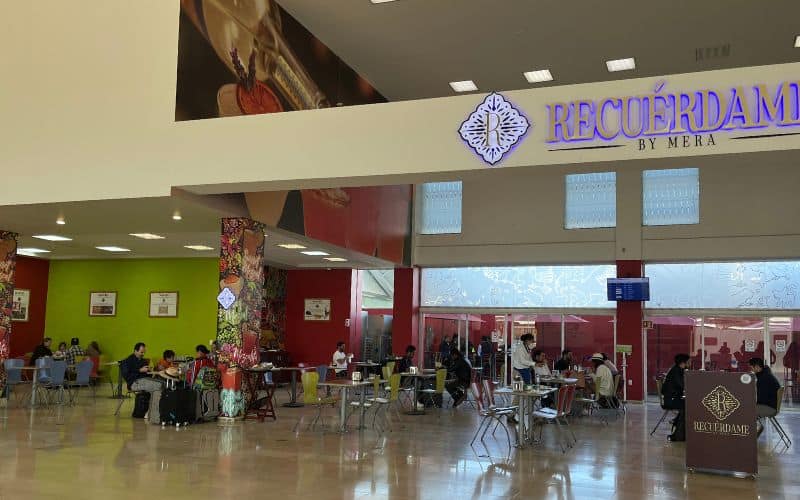
You might see this airport called Xoxocotlán International Airport, but it’s still OAX. This makes getting to Oaxaca Mexico very easy, and you can book your Oaxaca flights now!
🚐 Best Oaxaca Airport transportation
What is the best time to visit oaxaca mexico.
The best time to travel to Oaxaca is during the dry season, October to May .
However, the temperate weather in Oaxaca City means it can be a year-round destination.
🌡️ Oaxaca weather

While it will rain during the Oaxaca rainy season, you’ll also get lower prices — as this is the slow season.
Need info on the Oaxaca climate to expect when you travel, and a Oaxaca weather by month guide? Check out this Best Month to Visit to Oaxaca article.
Are there mosquitoes in Oaxaca?
Yes — The Oaxaca mosquitoes can be vicious year-round (especialy on the coast of Oaxaca). The best time to go to Oaxaca for avoid the mosquitoes is in winter.
No matter than you visit, pack some eco-friendly bug spray and these anti-mosquito bracelets if you want to avoid aerosols.
There’s also this great reef-safe sunscreen from Bullfrog that has SPF 50 and also repels mosquitoes.

How many days do you need in Oaxaca City?
Within Oaxaca City itself, you can see the highlights in 2-3 full days. However, there are so many things to do in Oaxaca , so you could spend a week there and still not see it all.

For those who want to explore the villages outside town, like Hierve el Agua in San Lorenzo Albarradas, San Agustín Etla, Teotitlán Del Valle and San Pablo Villa de Mitla, you’ll want at least 5-6 full days.
What is Oaxaca known for?
Wondering, Why is Oaxaca so popular? There are five things Oaxaca is known for — art, culture, the Oaxaca Day of the Dead celebration, mezcal and food .
In fact, Oaxaca is known as the Foodie Capital of Mexico, so try both the street food in Oaxaca and the restaurants . For more info to answer the Why is Oaxaca famous? question, check out the linked article.
Is Oaxaca City worth visiting?
Yes — Oaxaca is magical; it’s the Mexico people imagine Mexico to be.
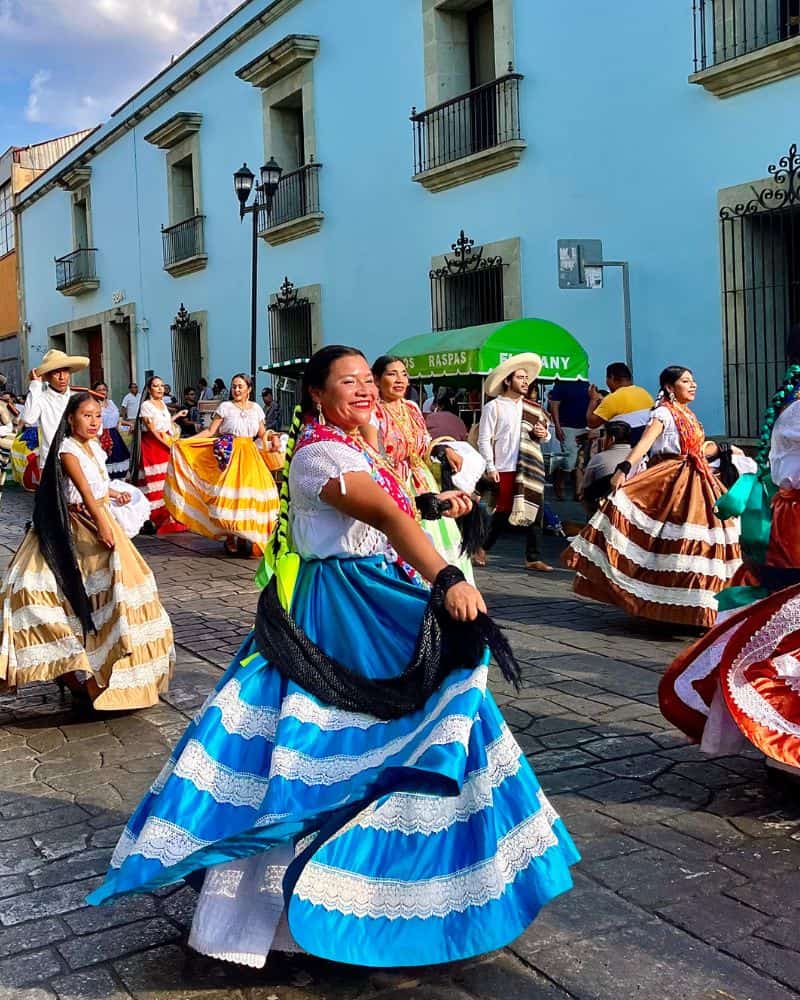
There’s everything from history, colorful festivals , UNESCO World Heritage Sites, locally-made Oaxacan mezcal , beautiful nature, colonial architecture, indigenous artisan communities, and of course, the Oaxacan food .
As you’ll usually need to take at least two flights to Oaxaca, Mexico, or even a flight and a bus, you might still be wondering if traveling to Oaxaca is worth it.
I hope this guide to Oaxaca made it clear that FU+K YES IT IS!
Covid-19 Safety in Oaxaca Mexico

The world will never be the same post-Coronavirus, but hopefully the worst has passed.
For official information on Oaxaca travel during Covid-19, check the CDC website and U.S. State Department website for any Mexico travel warnings and advisories.
There’s also the Semáforo Epidemiológico, or Mexico traffic light map , to inform the public about the Covid numbers in each Mexican state .
It’s updated every two weeks, with a green light for a low number of cases, and red for a high number.
Final Thoughts: Is Oaxaca Safe Right Now?

You may have noticed there was never a definitive yes or no answer to the Is Oaxaca safe to travel to? question.
The reality is that there is crime in Oaxaca City, some petty and some serious, but most visitors travel to Oaxaca Mexico and have a great trip.
The minority of visitors have a negative experience in Oaxaca, but those are the voices you hear over the people who loved visiting Oaxaca.
As someone who’s been to Oaxaca, and lives in Oaxaca part-time, I think it’s as safe as much of Mexico — but with Oaxaca’s rise in popularity has come a rise in crime.
Still, it’s safe for the most part, and you should not be deterred from visiting Oaxaca because there is some crime.
If you only went to the places where there’s no crime at all, you’d never be able to leave your house because by that metric, even your hometown isn’t safe.
In short, Is it safe to travel to Oaxaca Mexico? , How dangerous is Oaxaca Mexico? and How safe is Ooaxaca City? have no definitive answer. It’s safe for the majority of visitors, but not all visitors.
In Oaxaca, exercise caution, use common sense, follow the same general travel precautions you would anywhere else, and know the odds are in your favor.
Oaxaca Travel Planning Guide
Should i buy mexico travel insurance for oaxaca.
100% YES! — With basic coverage averaging just $5-10 USD per day, enjoy peace of mind with a plan from Travel Insurance Master , one of the biggest names in travel insurance. ( Read more )
No — You’ll want to buy this Water-To-Go Bottle , which filters your drinking water so you don’t get sick from drinking water in Mexico, and helps keep you hydrated while traveling to Oaxaca. ( Read more )
Is it safe to rent a car in Oaxaca?
Yes — Renting a car in Oaxaca is one of the best ways to see the state. I always rent with Discover Cars , which checks international companies and local Oaxaca companies, so you get the best rates. ( Read more )
Will my phone work in Oaxaca?
Maybe — It depends on your company, so check with your provider. If you don’t have free Mexico service, buy a Telcel SIM Card . As Mexico’s largest carrier, Telcel has the best coverage of all Mexico SIM Cards. ( Read more )
What’s the best way to book places to stay in Oaxaca?
For Oaxaca hotels, Booking.com is the best site . If you’re considering a Oaxaca Airbnb, also check VRBO , which is often cheaper than Airbnb. For the best Oaxaca hostels, use HostelWorld .
What do I pack for Oaxaca?
Head to the Ultimate Mexico Packing List + FREE Checklist Download to get all the info you need on packing for Mexico.
What’s the best site to buy Oaxaca flights?
For finding cheap Oaxaca flights, I recommend booking through Skyscanner .
Do I need a visa for Oaxaca?
Likely Not — U.S., Canadian and most European Passport holders don’t need a visa for Mexico; but you can check here to see if you need a Mexico travel visa.
The vast majority of travelers will receive a a passport stamp, or 180-Day FMM Tourist Visa upon arrival.
- Meet the Team
- Work with Us
- Czech Republic
- Netherlands
- Switzerland
- Scandinavia
- Philippines
- South Korea
- New Zealand
- South Africa
- Budget Travel
- Work & Travel
- The Broke Backpacker Manifesto
- Travel Resources
- How to Travel on $10/day
Home » North America » Oaxaca
Is Oaxaca Safe for Travel? (Safety Advice for 2024)
Oaxaca may look like a mouthful (pronunced wa-ha-ka ) but now we’ve got that cleared up, you’re about to receive core life memories. The sheer depth of culture in Oaxaca rivals that of anywhere else in the world. It’s complete with a vibrant art scene, soulful food, and landscapes to make your heart fall out your arse.
The central valleys teem with archaeological sites. Hop over to the coast for sandy beaches and easy-living. Nature-lovers take note: Oaxaca is also one of the most biologically diverse states in Mexico.
A surfer’s paradise as much as foodie heaven, Oaxaca looks great on paper. And actually, it’s even better in real life. It’s no wonder this is one of the top destinations to visit in Mexico.
Though, there we have it: the buzz word. We are in Mexico . So how safe is Oaxaca really?
There are certain things – and certain areas – that aren’t as safe as you’d want them to be. A lot of the time, nature plays a role in posing a danger.
If you’re wondering whether or not Oaxaca is safe, read on. Here are some tips, important info, and details you’ll need for your journey around this magical Mexican state.
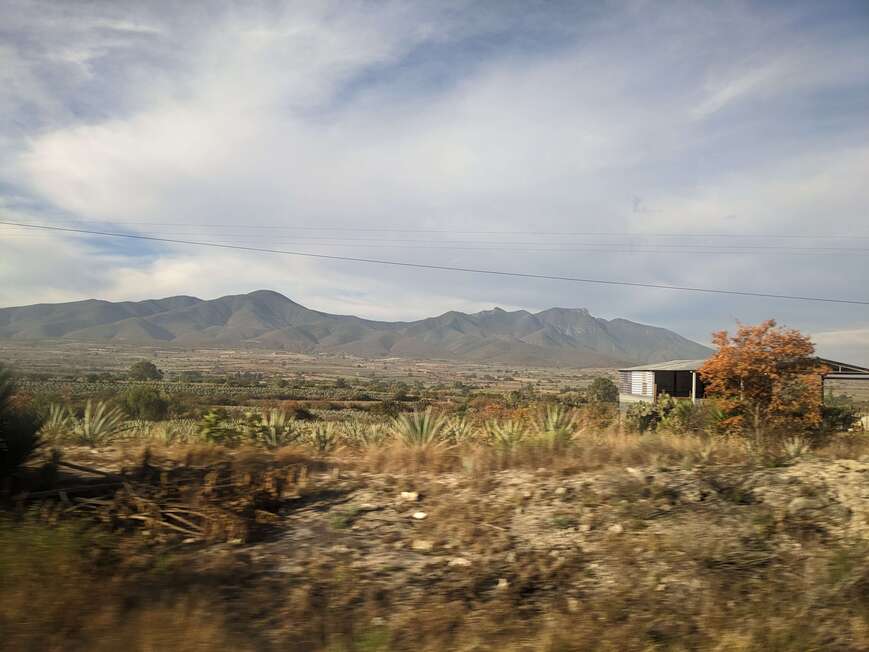
Unlock Our GREATEST Travel Secrets!
Sign up for our newsletter and get the best travel tips delivered right to your inbox.
There is no such thing as a perfect safety guide, as things change quickly. The question of “Is Oaxaca Safe?” will ALWAYS have a different answer depending on who you ask.
The information in this safety guide was accurate at the time of writing. If you use our guide, do your own research, and practice common sense, you will probably have a wonderful and safe trip to Oaxaca.
If you see any outdated information, we would really appreciate it if you could reach out in the comments below. Otherwise, stay safe friends!
Updated April 2024
Is Oaxaca Safe to Visit Right Now?
Safest places in oaxaca, 20 top safety tips for travelling to oaxaca, is oaxaca safe to travel alone, is oaxaca safe for solo female travellers, where to start your travels in oaxaca, is oaxaca safe for families, getting around oaxaca safely, crime in oaxaca, what to pack for your oaxaca trip, getting insured before visiting oaxaca, faqs on oaxaca’s safety, so, how safe is oaxaca.
Yes, Oaxaca is safe for tourists to visit! And actually, I recommend that you DO visit! In 2018, an analytical database reported 1,121,615 international visitors to Oaxaca . Majority having no troubles with their stay.
Mexico has been working hard to increase tourism in Oaxaca – and it’s working. The focus on the safety of visitors has made a noticeable difference, making it a great place to explore in Mexico .
While the USA Oaxaca travel advisories remain at “exercise increased caution” for most of the state, this is mainly due to petty crime such as pickpocketing.
Oaxaca is safe for tourists, yet large, and very diverse. The colourful capital, Oaxaca City, is one of the most visited destinations in Mexico and for the Day of the Dead festival.
The state has a large coast on the Pacific Ocean, and between them is a large mountainous region. If you want diversity, Oaxaca is your place.
Especially as far as Latin America goes, Oaxaca is a destination with few complications. That is not mean to say that there are NO safety concerns in Oaxaca. Having some safety tips under your belt is still invaluable.
While much of Mexico suffers from travel warnings , high crime rates and dangerous drug dealings, Oaxaca remains relatively safe. It’s a great alternative to Mexico City.
Drug-related violence, though still existing, is low and generally under control in Oaxaca. It’s extremely unlikely that any would affect tourists minding their own business.
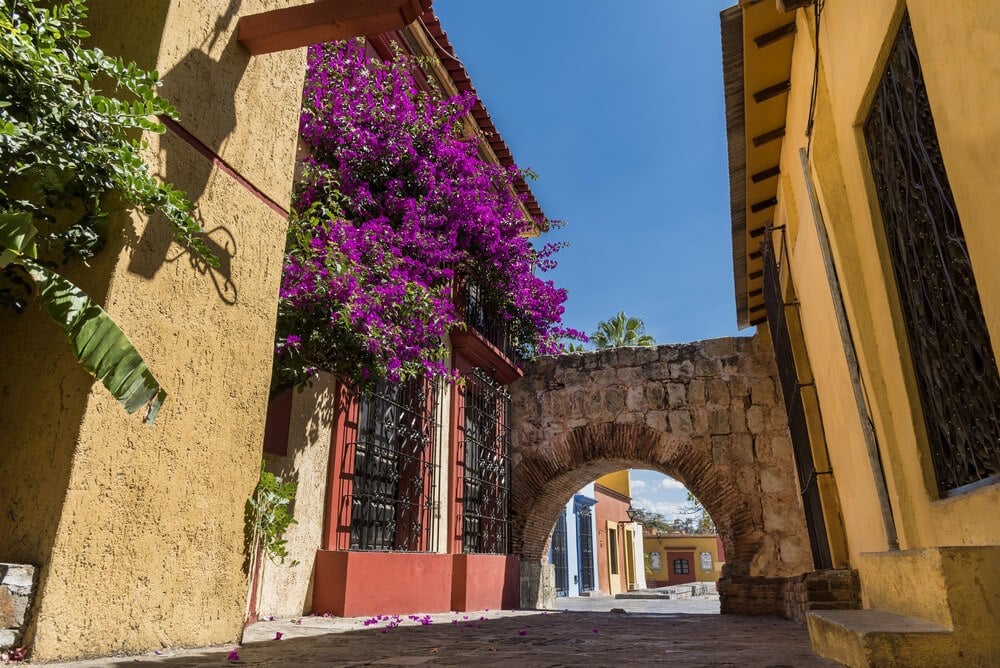
Natural disasters are a small risk in Oaxaca. Hurricane season affects Oaxaca from June to November. The size of these storms vary, but can cause widespread flooding, landslides, and disruption of local services.
Earthquakes can and do occur. Big tremors are uncommon but it’s good to be aware that they can occur.
Oaxaca’s coastline has powerful undercurrents and waves. Even strong swimmers get into trouble. On many beaches, you’ll find flags and warnings, which you should always heed.
So that’s the basics. But let’s go into a little more detail now.
Check out our detailed where to stay guide for Oaxaca so you can start your trip right!
The safest places to visit in Mexico are usually the places with the most tourism. For this reason, much of Oaxaca state is safe to visit. Although visitors are recommended to exercise increased caution. (Good advice for anywhere you’re travelling.)
These “safe destinations” have very few issues. However, you should still follow local laws and practice your usual safety protocol.
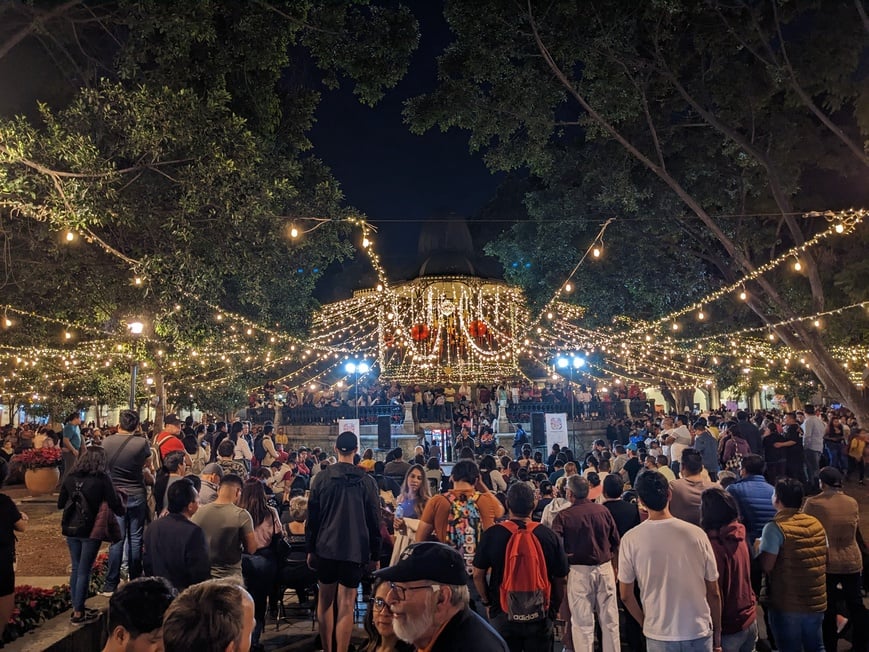
- Oaxaca City – Visiting Mexico is not complete without staying in Oaxaca City. It’s one of the more colourful and culturally rich places, with exciting art and endless places to eat. Go with an empty belly, leave with a full heart.
- Puerto Escondido – This popular backpacker spot attracts travellers from all over – and many find themselves not wanting to leave. On the Pacific Coast, people come for the surf, incredible food, and a relaxed vibe. Puerto Escondido’s hostels are something you should definitely experience.
- San Jose Del Pacifico – Once a hidden gem, now a pretty popular tourist town. This astonishing mountain spot is a place where time slows down. There’s nowhere else like this in Mexico (or even the world).
Unsafe Places in Oaxaca
While Oaxaca is mostly safe, there are certain areas of the state to avoid . Though there are very little to see in these places anyway, you really can skip across them and not miss a thing.
The USA government also recommends avoiding certain highways. This could be due to the safety of the road or illegal roadblocks. These rarely affect tourists – especially using reputable bus companies – though if you’re driving or hitchhiking in Mexico, it’s good to do thorough research.
- Towns bordering the state of Chiapas – including Juchitan de Zaragoza, Salina Cruz, and San Blas Atempa.
- Anywhere at Night – some select areas are okay such as downtown Oaxaca City, though it’s best to use a taxi or public transport if you’re going between areas or back to your accommodation.
- Sketchy Neighbourhoods – ask your accommodation staff if there are any barrios to avoid. Again, there will be nothing to see here anyway.
Keeping Your Money Safe in Oaxaca
One of the most common things to happen to you whilst travelling is losing your money. And let’s face it: the most annoying way for this to actually occur is when it’s stolen from you.
Petty crime is pretty much a problem all over the world.
The best solution? Get a money belt.

Stash your cash safely with this money belt. It will keep your valuables safely concealed, no matter where you go.
It looks exactly like a normal belt except for a SECRET interior pocket perfectly designed to hide a wad of cash, a passport photocopy or anything else you may wish to hide. Never get caught with your pants down again! (Unless you want to…)
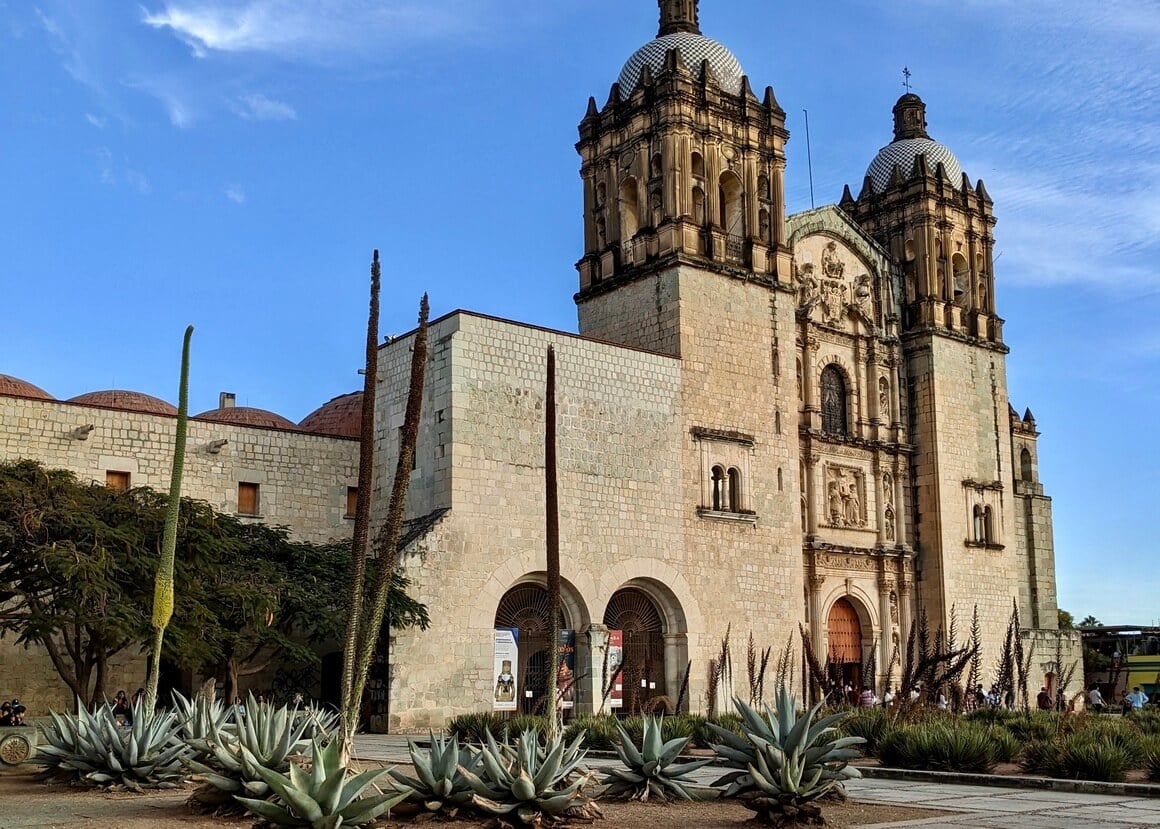
So the safety concerns for Oaxaca and the conclusion of “is Oaxaca Safe to visit?” comes down to knowing some crucial safety tips . This is not an exhaustive list, though they will help you experience safety in Oaxaca and enjoy this incredible adventure.
So here are some of our top safety tips for Oaxaca to keep you travelling smart.
- Don’t walk around looking rich – Leave designer clothes, flashy watches, and expensive jewellery at home.
- Try to dress down and blend in with what you are wearing – Erring on the side of casual is best. Try to reflect what other people may be wearing around you.
- Do your research – Oaxaca is a big place so plan accordingly. Different areas have different safety standards and cultures, too. Puerto Escondido is very different from Oaxaca City, for example.
- Learn Spanish – You don’t need to be fluent, but you’ll be surprised how much this helps – including getting yourself out of some sticky situations.
- DO NOT WALK AROUND ALONE AT NIGHT – Even in groups, it’s still very risky. I cannot stress this enough. Very certain areas are okay but it’s always better to ask locals before you do.
- Limit the amount of money you carry around with you – The more you have, the more you potentially lose. Store cash in different places of your person and luggage. Travel money belts are great for this.
- Be careful when using ATMs – Use them during daylight hours and preferably inside a mall, shop, or bank. Put it away discreetly before you leave the machine.
- Keep an eye on your belongings – Even on your suitcase when checking in at a hotel or bus station.
- Always keep an emergency stash of cash – Never keep all your cards/ currency in one place. And hide it all from thieves with a hidden money belt .
- The emergency number is 911 – remember it.
- Be careful of people who claim to be police officers – Not everyone is who they appear to be. If you aren’t sure, ask for details such as their name, badge number, patrol car number, etc.
- Watch out for scam artists – People approaching you asking for personal information or financial help. Treat unsolicited chats like these as suspicious.
- Watch for warning on beaches – Not all beaches are safe for swimming. If there are no flags or lifeguards, ask the locals. Even the calmest looking waters can have extremely strong undercurrents. The Pacific Ocean takes no prisoners.
- Take a good medical kit with you – you never know when you might need it!
- Research tour companies – If you’re heading out on a tour, make sure you are going with a reputable company that has good safety standards.
- Don’t leave food and drink unattended – Spiking does occur, so keep an eye on it and take care.
- Don’t get involved in drugs – I know it’s fun, but drugs are the source of many problems in Mexico. There are certain places that are okay in Oaxaca but unless you’re 1000% sure it’s really not worth the hassle.
- Keep an eye on earthquakes – Small tremors are common. Large tremors are uncommon. It’s good to have a general idea.
- Pay attention to the weather – Local reports will tell you about any tropical storms on the Pacific coast.
- Get a local sim card – This helps a lot.
- If somebody tries to rob you, hand over the goods – It is just not worth being a hero in these kinds of situations.
- Get trusty travel insurance – an absolute essential for any trip. Make sure your travel insurance covers the type of trip you’re having.
Oaxaca is safer than much of Mexico overall, but that doesn’t mean that you’ll be able to wander around freely without a care in the world. Keep these tips in mind and make sure to keep vigilant as you explore this amazing Mexican state.
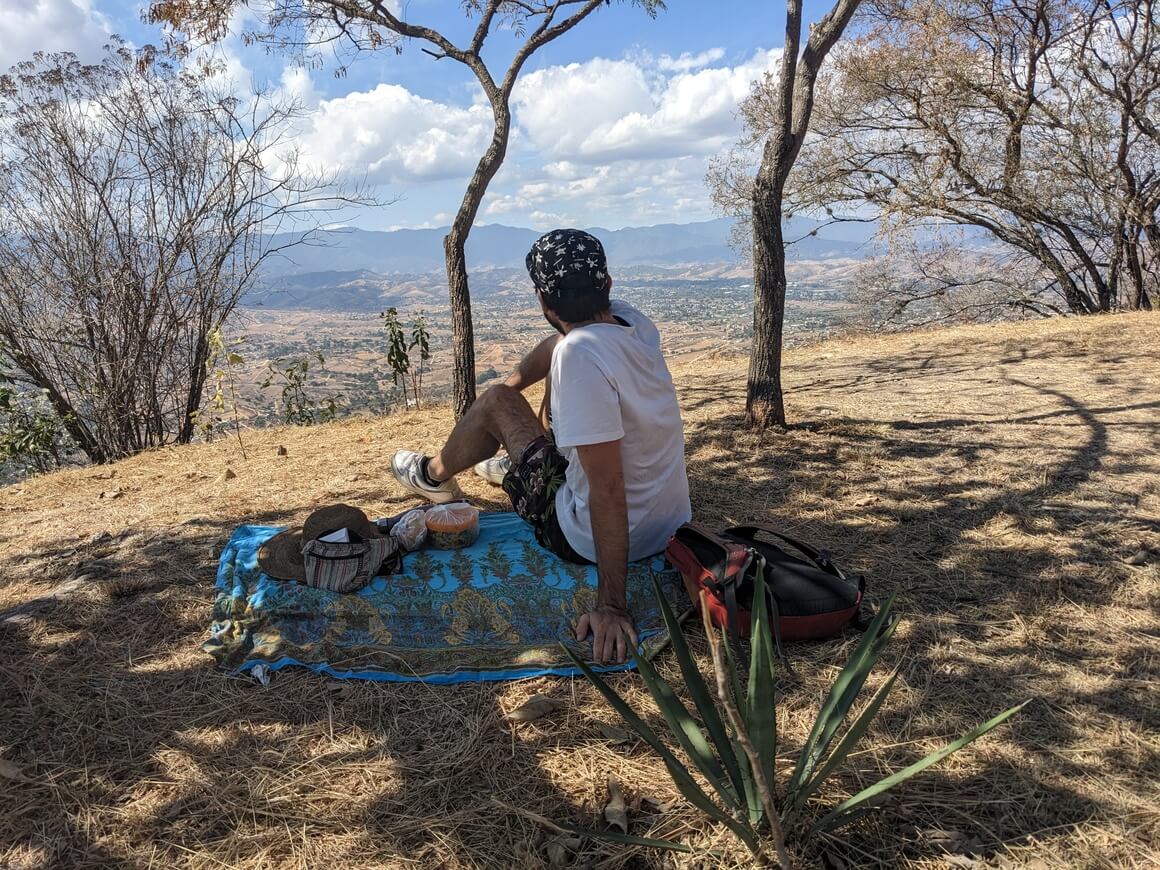
Yes! Oaxaca is an amazing place to travel – even alone.
It may not be a well-developed tourist destination, but it’s doable – and worth it. I’ve put together some tips for solo travellers in Mexico and Oaxaca to bear in mind when you travel around.
It’s a great place to go for history, with the colonial centre of the capital city to explore, as much as it is a foodie destination with a wealth of delicious treats to enjoy.
- Make friends ! – Always rule number 1 for solo travellers. There’s safety in numbers – plus it’s a lot more fun.
- Do your research – Have a rough idea of your itinerary, book accommodation ahead and read reviews, and ask other travellers for recommendations.
- DO NOT walk around at night alone – some very select places are okay. Generally, this is a big no no. Know how to get to your accommodation before you leave.
- Keep your phone charged – Your lifeline.
- Choose good hostels in Oaxaca – The state has no shortage of great choices. Read reviews, ask for recommendations, and stay somewhere that suits your personality.
- Stay alert. Don’t walk around with your iPhone in hand, not paying attention to your surroundings. I hope this is not the first time you’re hearing this.
- Download useful travel apps . Maps.me, Hostelworld, and even Tinder (to some extent) can be super useful for safety in Oaxaca.
- Take care when visiting beaches by yourself. Don’t leave belongings and valuables unattended on the beach.
- Ask locals for their insider knowledge – They will know interesting spots to visit, and places to eat, plus areas to avoid.
- Sun Protection! You don’t want to get sunstroke or increased risk of skin cancer.
- Let someone know where you are. Friends and family back home, or at the very least someone your accommodation staff.
- Don’t push yourself too much. Know when to stop and when to take a break.
- Travel light. Less baggage, less worries – literally.
- Keep track of your money and don’t keep it all in one place. You lose your wallet, you lose everything. Spread your bank and credit cards around.
Usually, Oaxaca feels like some remote wonderland of Mexico where everything’s fine. But the truth is, it’s not always. It’s somewhere in between, where you still need to watch out for your belongings and travel with some level of vigilance.
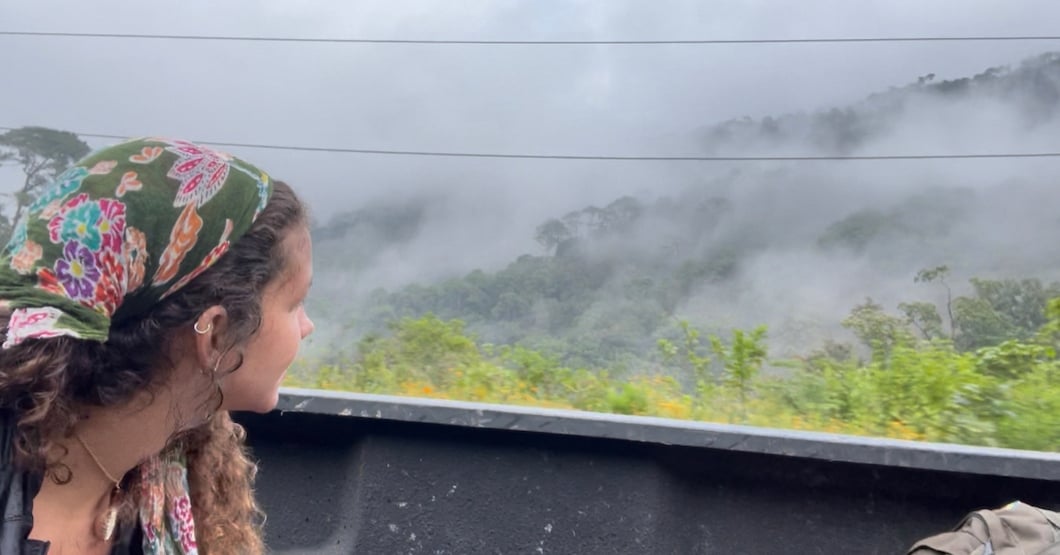
Yes! Oaxaca is one of the best places in Mexico for solo female travellers .
Though, like anywhere, travelling alone as a woman comes with some extra things to think about. Here are some tailored tips to keep you solo travellers super safe on your adventure.
- Listen to your spidey senses – female solo traveller tip 1: if your gut tells you something isn’t right, it probably isn’t. Get yourself out of there.
- Choose accommodation carefully – there are great hostels for women in Oaxaca.
- Chat with other female travellers – they understand the road you’re on better than anyone.
- Only use reputable bus companies – especially if you’re travelling at night, it’s worth paying the extra bit of cash for a safe journey.
- Read reviews before you book – that goes for hostels, hotels, tour companies, or anything else.
- Damn it, DO NOT WALK AROUND ALONE AT NIGHT – I’ve repeated this so many times already but it’s vital that everyone visiting Oaxaca understands this.
- Choose accommodation in a good location. In Oaxaca City, for example, stay close to attractions so it’s easy to get back at night.
- Dress modestly – Mexico is still quite conservative. Breaking boundaries is great but this is not the time or place. See what local women are wearing and try to match.
- Saying no is ALWAYS okay – you don’t need to please anyone, especially if it involves your safety.
- Make a fuss – It is unlikely that any hassle will turn ugly, but in a worst-case scenario, let everyone around know!
- Be careful of how much you drink – Keep your wits about you.
- Careful who you share information with – If someone’s asking too much personal information – red flag. Never share details of your accommodation or itinerary.
As a solo female traveller, one of the biggest dangers is falling in love with the place. It’s hard to drag yourself away when your time is up.
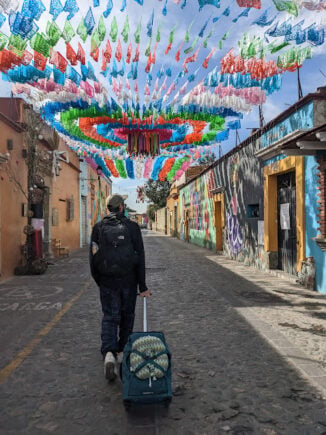
One of the coolest places to stay in Oaxaca. It is a hip and colourful neighbourhood best known for its quirky cafes and bars.
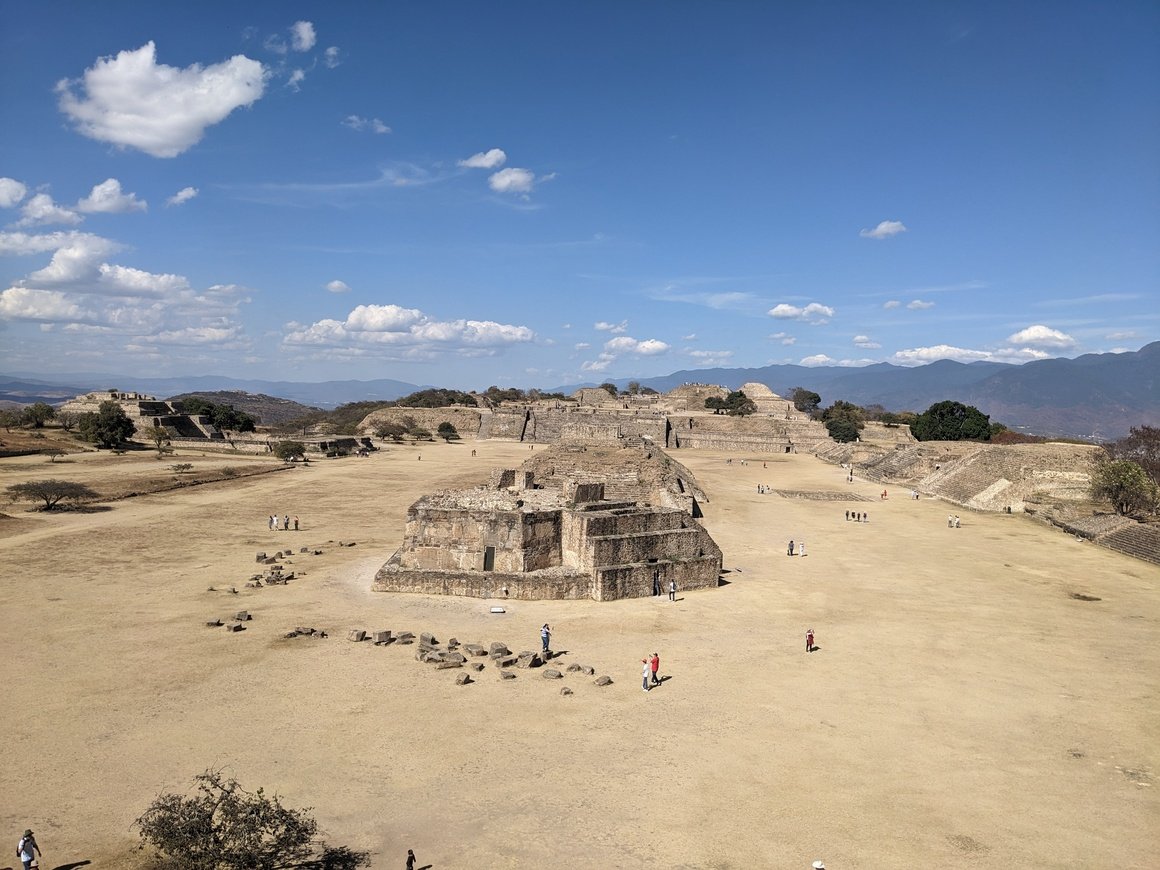
This is a question that comes us a lot. Is Oaxaca safe for families? YES!
Oaxaca is a kid-friendly place to travel to. From Oaxaca City itself to the beach, the coast, and the mountains, there’s a lot to keep everyone entertained.
Oaxaca city is very different from the likes of Mexico City. It’s walkable, colourful, and full of amazing character.
It is perfect for exploring with children with plenty to enlighten their senses. Lots of Mexican families travel to Oaxaca too, and you’ll see the main squares full of kids playing day and night.
The coastal area is also an ideal spot. Though the road from the city to the coast is long, don’t rush, plan accordingly, and you’ll arrive to enjoy all the best that you can expect from any coast anywhere.
Just pay attention to beach warnings. It is not always safe to swim everywhere. If there are no flags, ask at your accommodation whether or not it’s safe to swim.
Remember, like everywhere in Mexico, the places with the most visitors are the safest areas. So when you’re looking for a safe place to travel in Oaxaca with your family, bear that in mind. If you’re travelling between places, only use reputable companies like ADO Bus .
Also, much of the state of Oaxaca has high altitudes. So even sometimes when it doesn’t feel hot, the sun can be extremely strong. Make sure you have all the sun protection!
All in all, Oaxaca is a safe destination for families if you exercise increased caution (like you should everywhere).
Getting around Oaxaca safety isn’t overly complicated. You have the choice of buses, minivans, taxis, or driving yourself. They’re generally all pretty safe options – with a few important pointers.
Depending on where you go, the roads in Oaxaca can be complicated. From Oaxaca City to the coast it’s pretty rough.
Roads are narrow and winding, aren’t well maintained, and hazards aren’t well marked. Bear this in mind, whatever type of transport you choose.
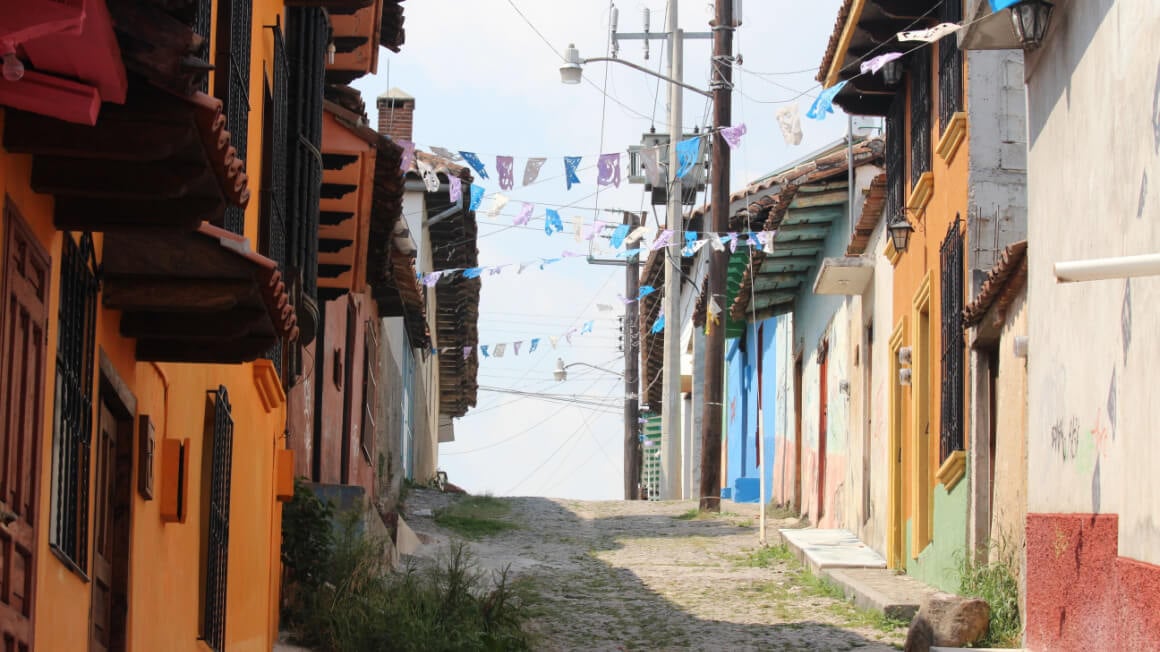
Driving in Oaxaca is safe enough, but may be challenging. Drivers in Oaxaca City are more aggressive, won’t stop for pedestrians, and don’t tend to follow traffic laws too much.
Local laws aren’t necessarily followed by police or drivers – so just be slightly aware of that. Go slowly, stop as you need to, and absolutely avoid driving at night at all costs.
Taxis in Oaxaca are generally safe. Though ensure that they are official taxis.
Use the sititos (taxi ranks) or ask your accommodation where to find them. If you are worried about the driver, take note of the driver’s name and license plate number.
Public transport varies throughout the state of Oaxaca, from luxurious buses to local pickup trucks. Reputable bus companies like ADO bus are your best bet. They do checks on the drivers and passengers, take toll roads, and drive sensibly.
Local buses, like the buses that drive around Oaxaca City, are regular and cheap. However make sure to HOLD ON TIGHT because they do not always drive the safest.
Minibuses are a great option for mid-distance travel. Lineas Unidas are super cushty, will give you an assigned seat, and generally drive safer than other minibus firms.
Depending on where you are going will depend on where you take them. Your best bet is to search on Google Maps, or ask locals for advice.
Oaxaca has a low crime rate compared to much of Mexico – though that doesn’t mean it doesn’t occur. Fortunately, most of this crime is petty theft which is pretty easily avoided. Violent crime is rare in Oaxaca.
Wherever you are, at the beach or in Oaxaca City, keep your valuables close.
Not watching your back and letting your guard slip when you’re on the beach at night, for example, or walking around looking like you’re wealthy, could result in being a victim of crime.
Protests in Oaxaca City are common, for example, and are usually held by union workers. Not often turning violent, these gatherings do throw up roadblocks and prevent travel in and around the capital city or further afield.
I do suggest that you avoid drugs in Oaxaca. I love a joint as much as the next person but, for various reasons, Mexico is not really the place to do it. There are some very select places where you can get away with it but there’s absolutely no way I’d list them here for fear of someone running with that idea.
Police are corrupt, you don’t need to give them any more reasons to hassle you, and drug cartels are the source of many of Mexico’s issues. It’s really best for everyone’s sake to just not get involved.
Apart from that, Oaxaca is one of the safest places in Mexico to take your travels.
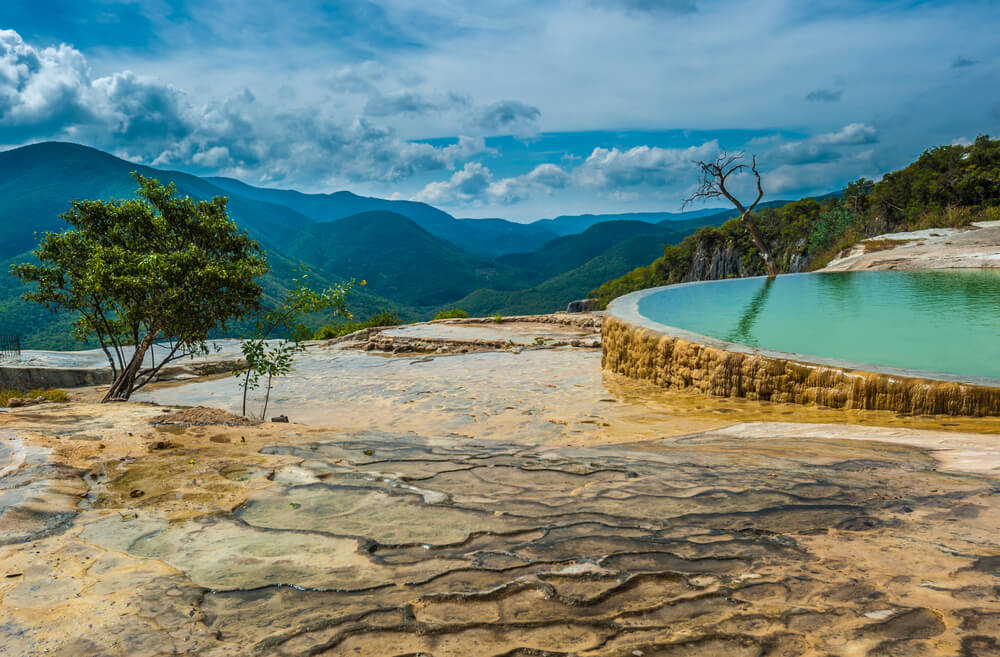
Everyone’s packing list is going to look a little different, but here are a few things I would never want to travel to Oaxaca without…

Hanging Laundry Bag
Trust us, this is an absolute game changer. Super compact, a hanging mesh laundry bag stops your dirty clothes from stinking, you don’t know how much you need one of these… so just get it, thank us later.

A decent head torch could save your life. If you want to explore caves, unlit temples, or simply find your way to the bathroom during a blackout, a headtorch is a must.

Yesim stands as a premier eSIM service provider, catering specifically to the mobile internet needs of travellers.

Monopoly Deal
Forget about Poker! Monopoly Deal is the single best travel card game that we have ever played. Works with 2-5 players and guarantees happy days.

This is a regular looking belt with a concealed pocket on the inside – you can hide up to twenty notes inside and wear it through airport scanners without it setting them off.
Before you go anywhere, having top-notch travel insurance for Mexico is vital. If something goes awray, and that does happen, this is your guardian angel.
ALWAYS sort out your backpacker insurance before your trip. There’s plenty to choose from in that department, but a good place to start is Safety Wing .
They offer month-to-month payments, no lock-in contracts, and require absolutely no itineraries: that’s the exact kind of insurance long-term travellers and digital nomads need.

SafetyWing is cheap, easy, and admin-free: just sign up lickety-split so you can get back to it!
Click the button below to learn more about SafetyWing’s setup or read our insider review for the full tasty scoop.
Here are some quick answers to common questions about safety in Oaxaca.
What should you avoid in Oaxaca?
Avoid these things in Oaxaca in order to have a safe trip: – Don’t walk around looking rich – Avoid being careless when getting money out of the ATM – Don’t walk around at night (especially if you are alone) – Don’t get involved in drugs of any kind
Is Oaxaca safe for tourists?
Yes, Oaxaca is pretty safe for tourists, especially those who stick to our travel tips and use their common sense. Being prepared and cautious during your trip will almost always keep you out of trouble.
What are the main safety issues in Oaxaca?
Tourists often experience small crimes like petty theft or pickpocketing. It’s rare (but not impossible) for tourists to face serious or violent crimes.
Is Oaxaca safe for female solo travellers?
Yes, we’d even go as far as saying that Oaxaca is the safest place in Mexico for female solo travellers. As long as you use basic common sense and stay aware of your surroundings, you should have a trouble-free trip in Oaxaca.
Is Oaxaca City safer than Mexico City?
Generally, yes. Oaxaca has a much lower crime rate than Mexico city. Though I always recommend that you should practice the same safety precautions in both cities, regardless.
At this point, I hope you’ve come to realise that the question of whether Oaxaca is safe to visit or not isn’t necessarily straightforward. Yes, you absolutely can visit Oaxaca and have a safe trip. Safety concerns are low and you’ll create memories to enlighten your life.
I’ve been in and out of Oaxaca for a few years now and never had any worries. So yes, it can be done. Without a doubt, I’ll be back to visit Oaxaca again one day.
Families, solo female travellers, and even LGBT travellers are all safe in Oaxaca. BUT you must practice some caution. This is Mexico after all and you are a guest here.
If you’re going to walk around with your Rolex, looking at maps on your iPhone 22, hailing illegal cabs in the night, and smoking a fat joint in the central squares, you can probably guess it’s definitely not going to be safe. Though, that would apply to most places really.
Be aware of your surrounding, but don’t get consumed by worry. Keep your sensible head on, exercise increased caution, prepare yourself with good travel insurance, and you’ll be rewarded ten folds by this impossibly beautiful state; one that leaves a big, fat, taco-shaped stamp on your heart.
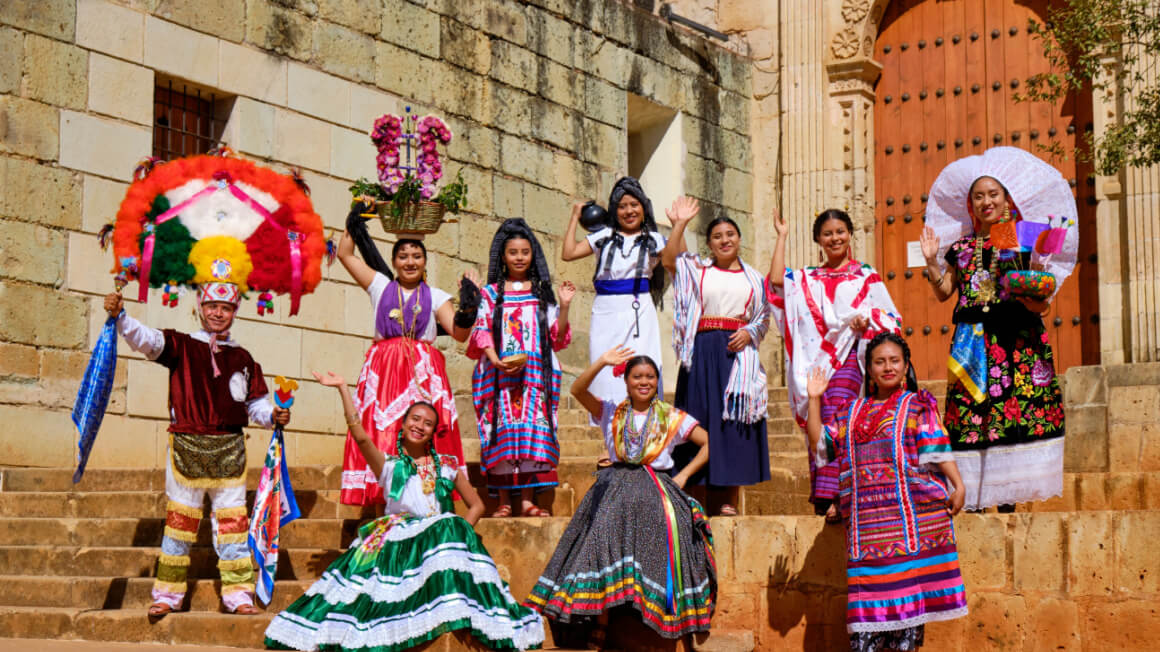
Looking for more info on traveling to Oaxaca?
- Let me help you choose where to stay in Oaxaca
- Swing by one of these fabulous festivals
- Don’t forget to add an epic national park to your itinerary
- Check out my favorite Airbnbs in the centre of all the action
- Plan the rest of your trip with our fantastic backpacking Mexico travel guide!
Disclaimer: Safety conditions change all over the world on a daily basis. We do our best to advise but this info may already be out of date. Do your own research. Enjoy your travels!

And for transparency’s sake, please know that some of the links in our content are affiliate links . That means that if you book your accommodation, buy your gear, or sort your insurance through our link, we earn a small commission (at no extra cost to you). That said, we only link to the gear we trust and never recommend services we don’t believe are up to scratch. Again, thank you!

Share or save this post

i am an american retired in puerto escondido. i often drive to the capital. i have had very little problems with safety. yes, it’s best to be careful but that’s true everywhere. the food is indeed delicious and cheap, and asking for recomendations is always smart. when in doubt look for the crowds. taco stands, street food is similarly safe.
Leave a Reply Cancel reply
Your email address will not be published. Required fields are marked *
Save my name, email, and website in this browser for the next time I comment.
Notify me of followup comments via e-mail.
- Skip to primary navigation
- Skip to main content
- Skip to primary sidebar
- Skip to footer
TravelAwaits
Our mission is to serve the 50+ traveler who's ready to cross a few items off their bucket list.
U.S. State Department Renews Warning About Travel To Mexico — Where It Says Visitors Can Travel This Spring

- News and Tips
- Travel News
Mexico is one of the most popular international destinations for American travelers. Cancun, Tulum, and Playa del Carmen particularly draw high numbers of tourists from the U.S.
However, as the spring break and Easter travel season approaches, anyone planning a trip to Mexico this spring must reckon with the sobering news of four Americans who were recently attacked by gunmen while traveling in Mexico.
The four individuals had traveled to Mexico so one could have a medical procedure. Then, in the city of Matamoros in Tamaulipas state, just south of Brownsville, Texas, the four were shot at and kidnapped. Two of them were killed in the gunfire. The other two, one of whom was also shot, have now been returned to the U.S., according to NBC News .
The U.S. Embassy & Consulates in Mexico issued a statement reminding U.S. citizens that it previously issued a travel advisory listing Tamaulipas state as a “Level 4: Do Not Travel” area in Mexico.
The natural inclination for anyone planning to travel to Mexico, as well as for family and friends of those prospective travelers, is now to question whether or not it’s safe to visit Mexico.
Zachary Rabinor, founder and CEO of the travel company Journey Mexico, says it’s important to remember that the Americans were killed and kidnapped a long distance from popular tourist destinations in Mexico.
“To put things in perspective, Matamoros is about 1,360 miles away from Cancun,” Rabinor said, according to CNN . “That’s about the equivalent distance from the Texas side of the border to Chicago, Illinois.”
Jaime Lopez-Aranda, a senior security manager at travel risk management firm International SOS, agrees that popular resort areas are still fairly safe.
“It is relatively safe for travelers to head to tourist destinations and major urban centers such as Mexico City, Guadalajara, and Monterrey,” Lopez-Aranda told CNN Travel.
Importantly, the U.S. State Department has issued a number of advisories for U.S. citizens traveling to various Mexican states in recent weeks. Now, as violent crime and kidnapping rates increase across Mexico, Americans considering travel to all but two of the states in Mexico should be aware of renewed and increased warnings, the State Department cautions.
“Violent crime — such as homicide, kidnapping, carjacking, and robbery — is widespread and common in Mexico,” the State Department explains .
“The U.S. government has limited ability to provide emergency services to U.S. citizens in many areas of Mexico, as travel by U.S. government employees to certain areas is prohibited or restricted,” the State Department continues. “In many states, local emergency services are limited outside the state capital or major cities.”
Here are the State Department’s travel advisories for each of Mexico’s states.
Do Not Travel To
The State Department advises U.S. citizens to not travel to five states in Mexico due to increasing levels of crime and kidnapping.
Those states are Colima (where Manzanillo is located), Michoacan, Sinaloa (where Mazatlán is located), Tamaulipas, and Zacatecas (home to Zacatecas City).
Guerrero — where Acapulco, Zihuatanejo, and Ixtapa are located — is also on the State Department’s “Do Not Travel” list because crime is widespread in those areas.
Reconsider Travel To
The State Department advises U.S. citizens to “reconsider travel” to five states in Mexico due to crime and kidnapping.
Those states are Baja California (where Tijuana is located), Chihuahua, Guanajuato (where Guanajuato City is located), Jalisco (home to Guadalajara and Puerto Vallarta), and Sonora.
The states of Durango and Morelos are also on the State Department’s “Reconsider Travel To” list due to high crime rates.
Exercise Increased Caution When Traveling To
The State Department advises U.S. citizens to “exercise increased caution when traveling to” 17 areas of Mexico, primarily due to crime rates but also due to the threat of kidnapping in some places.
Those states are Aguascalientes, Baja California Sur (where Cabo San Lucas , San Jose del Cabo, and La Paz are located), Chiapas, Coahuila, Hidalgo, Mexico State, Nayarit, Nuevo Leon, Oaxaca (home of Oaxaca City and Huatulco), Puebla, Queretaro, Quintana Roo (where Cancun , Cozumel, Tulum, and Riviera Maya are located), San Luis Potosi, Tabasco, Tlaxcala, and Veracruz.
Mexico City is also on the list due to high crime rates.
Exercise Normal Precautions When Traveling To
The State Department advises U.S. citizens to “exercise normal precautions when traveling to” Campeche and Yucatan, where Chichen Itza and Merida are located.
Know Before You Go
If you decide to travel to Mexico, the State Department offers some guidance.
“Exercise increased caution when visiting local bars, nightclubs, and casinos,” the State Department recommends. “Do not display signs of wealth, such as wearing expensive watches or jewelry. Be extra vigilant when visiting banks or ATMs.”
U.S. citizens with an emergency are also reminded that they can call the U.S. Embassy & Consulates in Mexico for help.
U.S. citizens on their way to Mexico are also advised to make a note of U.S. Embassy & Consulates emergency contacts in the area where they will be traveling.
Finally, the State Department recommends international travelers enroll in STEP, the Smart Traveler Enrollment Program .
Doing so enables U.S. citizens and nationals traveling and living abroad to enroll their trip with the nearest U.S. Embassy or consulate. That way travelers can receive important information from the Embassy about safety conditions in their destination country, make it easy for the U.S. Embassy to contact travelers in the event of an emergency, and also make it easier for family and friends to contact travelers in case of an emergency.
For more about changing travel conditions in countries around the world, be sure to read our Travel News content, including:
- New Cost To Travel To Europe Delayed Until 2024 — What Visitors Need To Know
- Traveling To Europe This Spring? 5 Countries Where Strikes Could Affect Your Trip
- TSA Is Asking Travelers With Pets To Stop Doing This One Thing — Here’s What It Is

Jim Fulcher has been a writer and editor his entire career. In addition to writing, he also enjoys traveling--particularly in an RV. Over the course of numerous trips, Jim has driven an RV through West Virginia, Virginia, Tennessee, Kentucky, Indiana, Illinois, Wisconsin, Iowa, Nebraska, South Dakota, and Wyoming. His favorite national park is Yellowstone, which he has visited three times.

- Visit Oyster on Facebook!
- Visit Oyster on Pinterest!
- Visit Oyster on Instagram!
- Visit Oyster on Twitter!
- Subscribe to stay up to date!
Yes, send me expert tips and deals!
By proceeding, you agree to our Privacy Policy and Terms of Use .
- Subtract one room 1 Rooms Add one room
- Subtract one adult 2 Adults Add one adult
- Travel Tips
11 Things Every Traveler Needs to Know Before Going to Oaxaca
See recent posts by Toby Orton
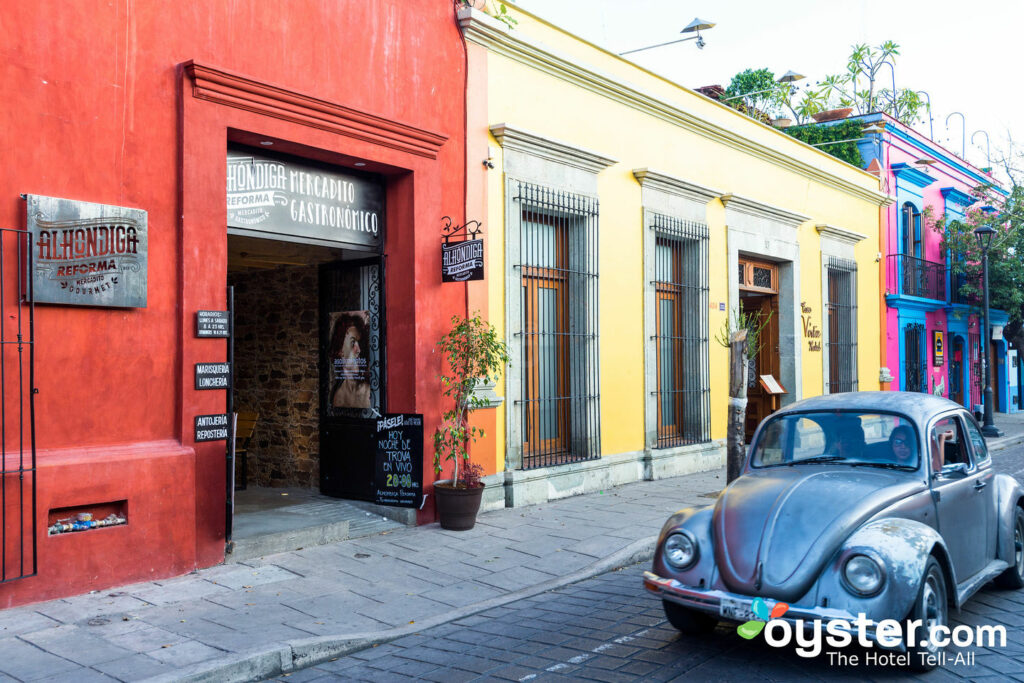
Colonial Streets in Oaxaca
While the sun, sea, and sand of Riviera Maya attract the majority of U.S. visitors, the food, colorful towns, culture, and Pacific coast of Oaxaca draw travelers looking for a more off-the-beaten-path adventure in Mexico. But how exactly does one prepare for a trip to the southern Mexican state? Starting with how to pronounce its name, here are 11 things every traveler needs to know before visiting Oaxaca.
1. It’s not pronounced ‘Oh-axe-ah-cah.’
The first thing every traveler to Oaxaca needs to know is how to pronounce its name. In Mexico, it’s said with an airy, flowing flourish, pronounced ‘Wah-hah-kah.’
2. The weather in Oaxaca is great all year round.
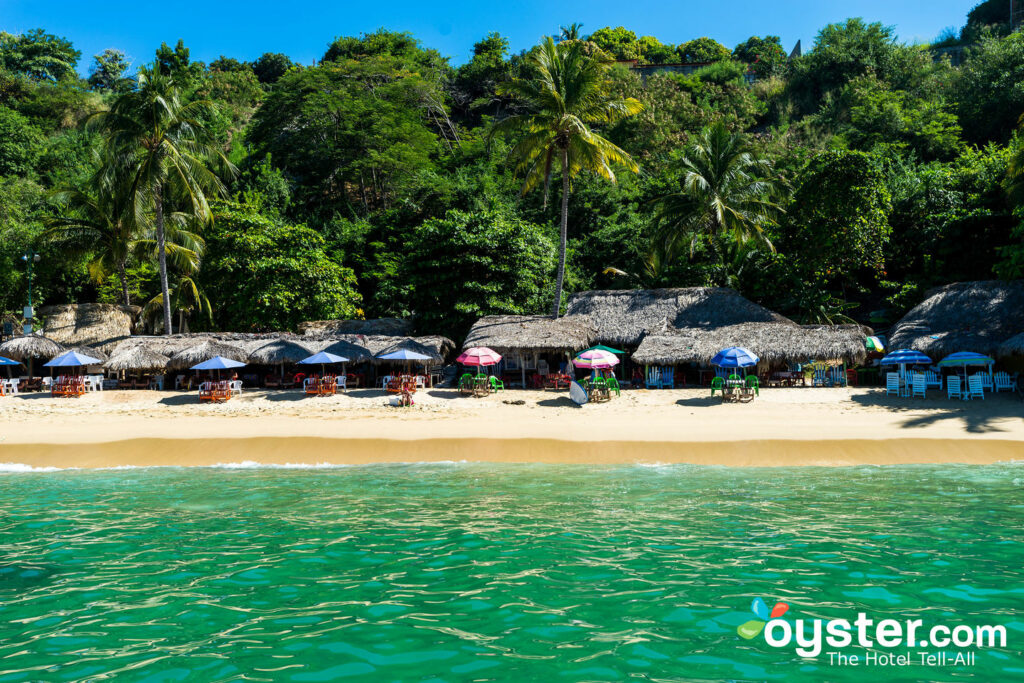
Beach in Oaxaca
As you would expect, summers are hot in Oaxaca, but it’s a pleasant, dry heat. Pack a large hat (or buy one at one of the many markets you’ll find on weekends in most towns) and plenty of sunscreen. While winter mornings and evenings can get chilly, the climate is warm all year round, so off-peak visits (January to March) don’t necessarily mean you’ll find worse weather and fewer tourists.
3. Annual protests do occur.
Tourists are generally unaffected by the various protests in Oaxaca, but it’s good to be aware of these potential actions on the streets. The annual summer strike by the teachers’ union (in demand of better working conditions) is the most famous protest, having returned every year for over a decade. This shouldn’t turn you away from visiting, but if you want to avoid the peaceful occupation, skip a summer trip.
4. It’s the birthplace of mezcal.
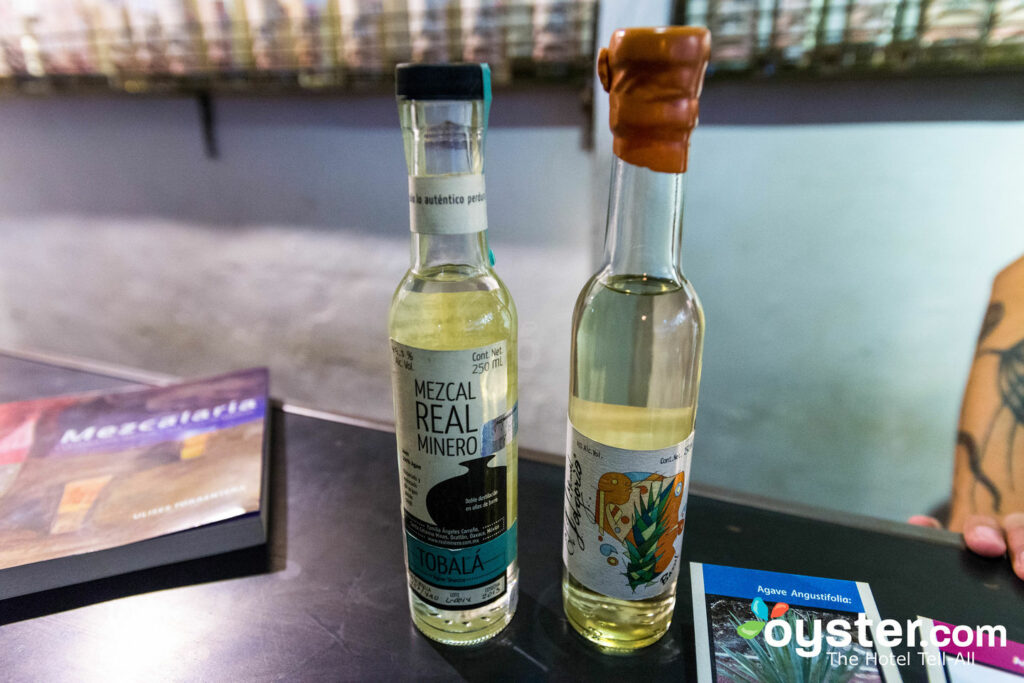
Mezcalarias in Oaxaca
Oaxaca is the birthplace of Mexico’s second-most famous drink, mezcal, and visitors go wild for the smoky, potent liquor. Both guided and self-guided tours are available throughout the state, with stops at various distilleries. Even if you’re not a huge mezcal fan, learning about the processes behind the small-batch production makes for a great day trip.
5. Direct flights from the U.S. to Oaxaca are limited.
Direct flights from the U.S. to Oaxaca are infrequent and don’t depart from many cities. If you can’t find a direct flight, the easiest way to reach Oaxaca is to fly to Mexico City and take a connecting flight. If you’re on a budget, an overnight bus ride to Oaxaca from Mexico City is a good way to save cash. The route follows safe, well-established toll roads.
6. Its ancient ruins are some of the best in the country.
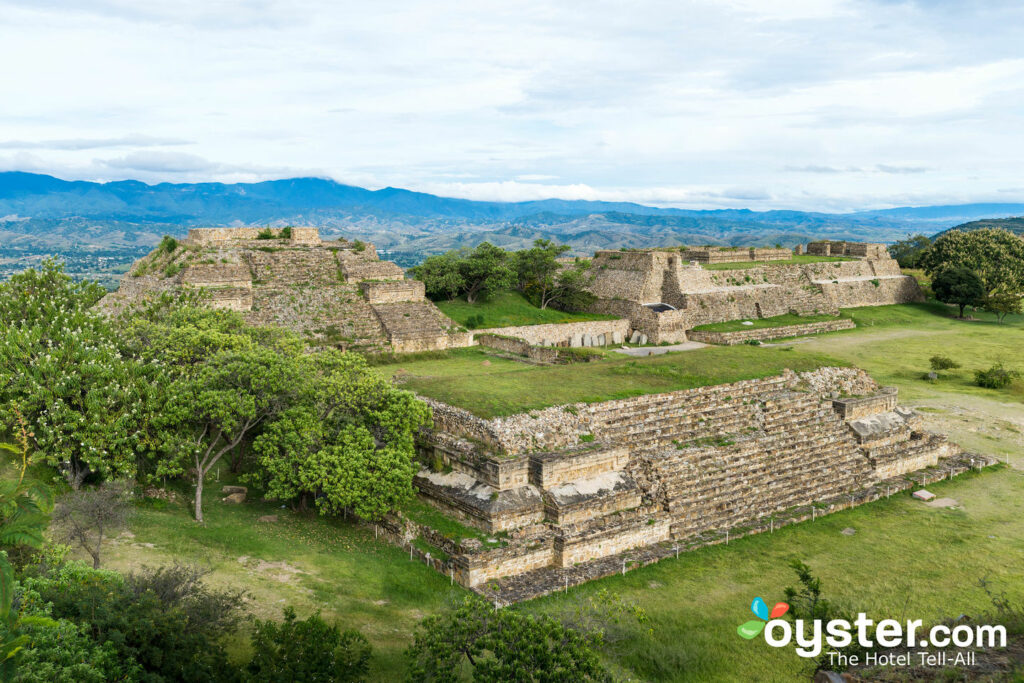
Monte Alban, Oaxaca
Oaxaca was the birthplace of the Zapotec civilization, and many remnants of their reign from the sixth century B.C. to the early 16th century still remain. The heart of the Zapotec empire was Monte Alban, a site that serves as a reminder of the people. A 20-minute drive from Oaxaca City, Monte Alban is a must-visit. A grand pyramid, built by the Zapotecs around 1,500 years ago, is the highlight of the ruins. Slightly further from Oaxaca City, the town of San Pablo Villa de Mitla is home to the ruins of Mitla, the second-most important archaeological site in Oaxaca. Along with the amazing ruins, the nearby town is worth exploring for its own architecture and artisan mezcal.
7. Oaxaca is one of the safest states in Mexico.
Oaxaca comes with a Level 2 warning from the U.S. Department of State, meaning travelers should ‘exercise increased caution.’ This puts it on a par with the Yucatan state. The number of visitors to Oaxaca has increased 15 percent since 2015 , with about 40 percent of foreign tourists coming from the United States. Meanwhile the states of Colima, Guerrero, Michoacán, Sinaloa, and Tamaulipas all have a Level 4 warning, indicating that traveler should not travel there.
8. Its Pacific coast is stunning.
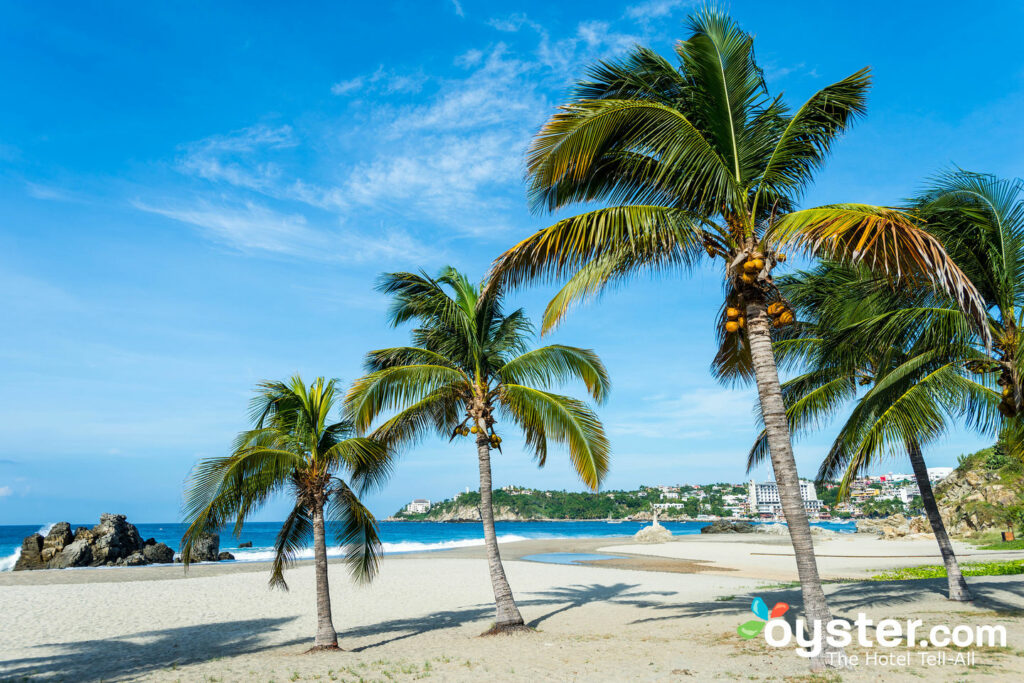
Beach in Puerto Escondido
Oaxaca has around 70 miles of beautiful Pacific coastline dotted with laid-back towns, stunning beaches, and secluded resorts. Huatulco and Puerto Escondido are the two main towns, but Zipolite, Mazunte, and Bahias de Huatulco provide a mix of great local food, rustic charm, and vibrant nightlife. The drive from Oaxaca City to Huatulco takes around five hours, so make the most of the distance with a meandering road trip, or take a short 45-minute flight.
9. Don’t drink the water in Oaxaca.
Like in the rest of Mexico, don’t drink the tap water here. Stick to bottled water — or mezcal.
10. The food scene in Oaxaca is world-famous.

Mole in Oaxaca
Anyone who has tried Oaxacan food in the U.S. has probably dreamt of visiting the “land of the seven moles.” Street food is huge throughout Oaxaca, and plenty of tourists come for the food found in the region. From fried grasshoppers (chapulines) to queso Oaxaqueno (some of the most delicious cheese in Mexico), the grub here is next-level delicious. Mole, a rich, complex sauce, is at the heart of many Oaxacan dishes. When looking for food in Oaxaca City, start in the Zocalo, the much-loved, fiercely protected main square in the heart of the city.
11. Indigenous culture is a huge part of life here.

Folkloric Parades in Oaxaca
The history and customs found throughout the state are carefully preserved generation after generation. Numerous indigenous communities contribute to Oaxaca’s way of life in the form of festivals, handicrafts, and other traditions. Day of the Dead is huge in Oaxaca, like much of Mexico, but many other festivals, like Night of the Radishes, Holy Week, and Guelaguetza, are also held throughout the year. While 15 percent of the Mexican population identifies as indigenous, the number soars to 56 percent in Oaxaca, which is one reason the state retains such an eclectic identity. In terms of shopping, Oaxaca is the kind of place where you can leave with a suitcase full of souvenirs, from handmade vases to beautiful textiles. You’ll find all kinds of folk art and artisanal crafts throughout the traditional tianguis across the state.
You’ll Also Like:
- 5 Under-the-Radar Things to Do in Oaxaca
- 6 of the Best Oaxaca Beach Resorts
- Is This the Coolest Under-the-Radar Beach Destination in Mexico?
All products are independently selected by our writers and editors. If you buy something through our links, Oyster may earn an affiliate commission.
Top Stories

Top 11 Las Vegas Hotels on the Strip for Every Type of Traveler
By Christina Vercelletto

- Captiva Island
The 10 Cutest Beach Towns in Florida
By Neil Gladstone

- Dominican Republic
Hotel Face-Off: Excellence Punta Cana vs. Excellence El Carmen
By Megan Wood

12 Things to Ask for When You Check Into Your Hotel Room
By Toby Orton

- Travel Safety
The 11 Safest Travel Destinations in the Caribbean Right Now
By Lilly LeClair

Is It Safe to Travel to Mexico?
If you have upcoming plans to travel south of the border, how concerned should you be about the latest violence security experts weigh in..
- Copy Link copied

Disputes between local taxi driver unions and Uber drivers earlier this year in Quintana Roo, the Mexican state that is home to Cancun, turned violent.
Photo by David Vives/Unsplash
The recent headlines from Mexico have been dramatic: A commercial airliner hit by gunfire during deadly rioting over the arrest of the son of Mexican drug kingpin “El Chapo” . Tourists forced out of their Ubers during protests held by taxi drivers in the resort town of Cancun. And four Americans kidnapped —two killed—after driving across the Texas border to Matamoros for a medical procedure.
While crime and drug-related violence in Mexico have been making headlines for years, the latest spate has prompted a series of security alerts from the U.S. Embassy & Consulates in Mexico and a warning by the Texas Department of Public Safety against spring break travel south of the border. And that, of course, has many travelers once again asking: Is it safe to travel there?
“Watch your own news,” one concierge at a Puerto Morales resort told me, with a hint of a scoff, when I posed the question during a February visit to the Quintana Roo seaside town that coincided with yet another mass shooting in the United States. “It’s much safer here. I won’t even go to a shopping mall in the United States.”
Indeed, the sheer number of tourists who regularly flock to the country’s beaches and tourist areas without incident would certainly seem to bolster her point. Last year, more than 13 million international travelers visited the country.
But the real answer, security experts say, is “it depends.”
It depends on where you go, how you get there, where you stay, and, perhaps most importantly, the decisions you make.
“In many ways the story stays the same—you avoid the very obvious areas where you shouldn’t go,” says Nick Phillips Jones, director of investigations and intelligence at the Mexico-based business intelligence firm Sargasso Group.
“For the vast majority of tourists who come to Mexico from the U.S. and elsewhere, they really are no more at personal risk than in their home countries if they stick to the ‘beaten track’ and major tourist areas,” he says. “Tourists are more at risk of getting short-changed or over-charged than anything else, much like anywhere. If they stay alert, most visitors will have no problems at all.”
Generally, beach resorts and popular tourist areas are considered among the safest areas as drug cartel–related violence generally isn’t aimed at tourists. That’s because the cartels don’t want to attract the attention of the U.S. government, according to Jones.
The fact that the Gulf cartel issued a public apology and handed over the men it said were responsible for the Matamoros kidnappings, “shows how keen they are to avoid and deflect the wrath of the U.S. law enforcement,” says Jones.
The biggest danger, experts agree, is being at the wrong place at the wrong time, which is what officials have said they believe was the case of the four Americans who were abducted in Matamoros earlier this month.
So how can travelers protect themselves? Here are some tips from travel security experts.
Do your research
It’s important to stay up to date so that you’re not caught off guard by any recent developments that could affect your trip and your safety.
For instance, the Mexican state of Quintana Roo, home to the popular beach destinations of Cancun, Riviera Maya, Cozumel, Playa del Carmen, and Tulum, used to be considered the safest tourist area in Mexico. But a few years ago it saw a rise in cartel activity “because of tourism, and tourists like to do drugs,” says Harding Bush, senior manager of security operations for the security and intelligence firm Global Rescue.
Security has been beefed up there since 2021, when two different shoot-outs between rival drug dealers spilled over onto hotel beaches, including one in Tulum that killed two tourists.
Earlier this year, the U.S. Embassy and consulates in Mexico issued a security alert in response to disputes between local taxi driver unions and Uber drivers in Quintana Roo that “occasionally turned violent, resulting in injuries to U.S. citizens in some instances.”
Citing crime and kidnapping, the U.S. State Department advises Americans not travel to 6 of Mexico’s 32 states: Guerrero, Colima, Michoacán, Sinaloa, Tamaulipas, and Zacatecas.
The northern state of Tamaulipas is home to Matamoros, which is just across the Rio Grande from Brownsville, Texas.
And Sinaloa is where the arrest of Ovidio Guzmán-López, son of Joaquin “El Chapo” Guzman, sparked a wave of violence that killed 29 people and closed airports in Culiacan and Mazatlan when gunfire filled the streets, with some shots hitting an Aeromexico flight preparing to depart Culiacan for Mexico City.
Additionally, the State Department advises tourists to “reconsider travel” to seven other states (also on the basis of crime): Baja California (the northern portion of the peninsula, not Baja California Sur, the southern state where most resorts are located), Chihuahua, Durango, Guanajuato, Jalisco, Morelos, and Sonora.
Most Mexican states have a Level 2 designation from the State Department, which means “exercise increased caution,” including Quintana Roo, Baja California Sur, Oaxaca, and Mexico City.
Look beyond travel advisories
Don’t just look at State Department warnings and advisories, Bush says. Mexico is one of the largest countries in the Americas, and the 13th largest in the world. Its states are large as well, so it’s important to understand the situation in the specific locality you are heading to.
“Look at the news, the U.S. news and the local news in Mexico,” he says. “Talk to people who have been there before,” including those who have visited very recently.
Another good resource, Bush says, is the U.K. government site , which he said gives more detail about what is driving its traveler recommendations.
Vet your accommodations and transportation
Stay at known hotels and resorts that have well-established security, Bush advises. Many well-known brands, including Marriott, Hilton, Hyatt, and Four Seasons, to name just a few, have extensive experience operating in Mexico. And across the country, it’s commonplace for beach resorts to have a security checkpoint at the entrance, as well as security personnel who closely monitor both the properties and adjacent beaches.
Find a hotel away from busy beaches flanked by vendors and criminals who might be disguised as vendors. For instance, in Quintana Roo, all beaches are public, but there are a number of hotels and resorts set in more remote areas away from the foot traffic.
For transportation to and from the airport, or for trips off property, use a service organized by your hotel or resort, particularly if you are going out at night.
If you drive instead of fly, avoid driving at night
Most tourists fly into the popular tourist areas. But many residents of border states like California, Arizona, and New Mexico, who largely abandoned drive-to destinations like the Baja Peninsula and Puerto Penasco and San Carlos on the eastern shores of the Sea of Cortez after the government launched an aggressive war on drug cartels in 2006, have returned, with little incident, in recent years.
Still, experts say travelers going overland should take serious precautions to ensure they don’t inadvertently end up in cartel areas. And both Jones and Bush warned never to drive at night.
“The northern border region is and has long been high risk,” says Jones. “If you have to travel there, you absolutely have to take precautions, keep a very low profile, and get local up-to-date advice before doing so.”
As with any travel, implement common precautions
As with any country or region where crime is present, there are certain activities that either require added caution or should be ruled out entirely if you want to avoid any danger.
Be careful withdrawing cash from ATMs—only use them during the day, and make sure there are people around. You might think twice about wandering the streets at night, particularly alone or in areas that you aren’t familiar with. And, of course, if you engage in illicit or illegal activities such as purchasing drugs, you are increasing your risks.
“There’s a lot of crime in Mexico,” says Bush. “It doesn’t necessarily target tourists, but it’s there and [if you’re not careful] you could definitely find yourself in the wrong place at the wrong time.”

U.S. eases travel warning on Mexico’s Oaxaca state
The U.S. government has eased its travel warning for Mexico's troubled southern state of Oaxaca, saying Americans should use caution in...
Share story
The U.S. government has eased its travel warning for Mexico’s troubled southern state of Oaxaca, saying Americans should use caution in the region instead of avoiding it altogether.
Oaxaca City, the state’s capital, was beset by six months of unrest last in which at least nine people died during protests seeking the ouster of state Gov. Ulises Ruiz. Before the conflict the city had been a popular destination for visitors interested in its historic, colonial buildings and artistic/cultural heritage.
The city has largely returned to normal since federal and state police took control in November but Ruiz has refused to resign and opposition groups still launch occasional protests.
The new U.S. stance on Oaxaca, detailed in a statement issued Wednesday by the U.S. Embassy in Mexico City, also urged Mexico to resolve the fatal shooting of independent journalist Bradley Roland Will, 36, of New York, who was killed in October while filming a clash between protesters and a group of armed men in Oaxaca City.
Most Read Life Stories
- In-N-Out proposes second WA location in east Vancouver
- The best of Seattle’s Vietnamese food scene
- Free-range kids are becoming a problem at the airport. What's the solution?
- How to make frozen shrimp even faster (and more delicious)
- Owners selling vacation rentals from under guests is a growing problem
Get details at http://mexico.usembassy.gov/mexico/ep070117Oaxaca.html
- Search Please fill out this field.
- Manage Your Subscription
- Give a Gift Subscription
- Sweepstakes
U.S. Issues Travel Warning for Mexico Ahead of Spring Break
The warning is asking travelers to “travel smart” and “be informed."
:max_bytes(150000):strip_icc():format(webp)/alison-fox-author-pic-15f25761041b477aaf424ceca6618580.jpg)
marako85/Getty Images
The United States is warning travelers heading to Mexico to be aware of their surroundings ahead of the spring break holiday season.
The warning , which was issued this week by the U.S. Embassy and Consulates in Mexico, reminds travelers to “travel smart” and “be informed” as “thousands of U.S. citizens visit Mexico during spring break” each year. The embassy continued that “while the vast majority travel safely,” visitors should be aware of issues with crime, drugs, unregulated alcohol, drownings, and more.
“Crime, including violent crime, can occur anywhere in Mexico, including in popular tourist destinations. Travelers should maintain a high level of situational awareness, avoid areas where illicit activities occur, and promptly depart from potentially dangerous situations,” the embassy warned. “U.S. citizens should exercise increased caution in the downtown areas of popular spring break locations including Cancun, Playa Del Carmen, and Tulum, especially after dark.”
The warning also reminded American travelers that drug possession and use is illegal in Mexico, including medical marijuana. It also advised that unregulated alcohol may be contaminated, that counterfeit medication is common, and that guns are illegal in Mexico.
When it comes to the country’s popular beaches, the embassy reminded travelers some beaches may have strong rip tides and “may lack lifeguards, warnings, or signs of unsafe conditions.”
The U.S. Embassy and Consulates in Mexico issued a similar spring break warning last year .
The U.S. Department of State classifies different states in Mexico under different warning levels. While travelers can “exercise normal precautions” when traveling to the Campeche and Yucatan states, the State Department warns them to “exercise increased caution” when heading to places like Baja California Sur (where Los Cabos is), Mexico City, and Quintana Roo (where Cancun is) due to crime.
The State Department also asks American travelers to “reconsider” going to the state of Jalisco, which is home to popular destination Puerto Vallarta , due to the danger of crime and kidnapping.
The State Department recommends Americans who do travel to Mexico keep people at home informed of their travel plans and enroll in the department’s Smart Traveler Enrollment Program (STEP) to both receive alerts and make it easier to locate them if an emergency occurs.
Travelers heading to international destinations can view all current travel advisories on the State Department's website at travel.state.gov .
- Share full article
Advertisement
Supported by
Is It Safe to Travel to Mexico? Here’s What You Need to Know.
A spate of incidents, including a kidnapping and the death of two Americans near the border, have prompted travel warnings from the U.S. government.

By Elisabeth Malkin and Isabella Kwai
Two Americans found dead after they were attacked and kidnapped near the border. Airports shuttered amid gang violence in Sinaloa. Turmoil among taxi drivers in Cancún.
A number of recent security incidents have raised concerns about the risks of traveling to Mexico, where more than 20 million tourists flew last year to visit the country’s beaches, cities and archaeological sites, or to obtain health care .
Ahead of the spring break holiday, a popular time for American tourists to visit the country, the U.S. Embassy issued a travel alert , urging visitors to exercise caution by avoiding dangerous situations and drinking responsibly, among other recommendations. “Crime, including violent crime, can occur anywhere in Mexico, including in popular tourist destinations,” the alert said. And the State Department has warned tourists to steer clear of six states, including the state of Tamaulipas, where the recent kidnapping occurred — and to exercise increased precautions in other popular destinations like Playa del Carmen, Cancún, Tulum and Mexico City.
An overwhelming majority of visitors enjoy a safe vacation in Mexico, and tourists are largely sheltered from the violence that grips local communities. But the attack and kidnapping of four Americans in the border city of Matamoros, two of whom were later found dead, along with recent disorder in Cancún and violence in early January that forced the closure of three airports in northwest Mexico, is prompting questions about whether the country’s broader unrest is spilling into other destinations.
What happened on the border?
On March 3, four Americans from South Carolina traveling in a white minivan crossed the border from Brownsville, Texas, into the city of Matamoros, in the Mexican state of Tamaulipas. One of the Americans was scheduled for cosmetic surgery.
Soon after the Americans crossed the border, gunmen fired on their vehicle and then abducted the group in a pickup truck. Officials later said that two of the group were found dead at a rural location alongside the other two, who had survived.
The Americans were attacked as a result of “confusion,” according to Irving Barrios, the state prosecutor in Tamaulipas. Matamoros has a long history of violence and highway shootouts, though that reputation has partially subsided in recent years. Then, in late February, one gang moved into the city to wrest control of drug sales from another, said Eduardo Guerrero, the director of Lantia Intelligence , a security consulting company in Mexico City.
“There are places in the country where the situation can change abruptly from one week to another,” he said. While the motives in the attack remain unclear, the Americans had “very bad luck,” Mr. Guerrero said, because they likely stumbled into a battle between the two gangs.
What happened earlier this year in Cancún?
Uber has been challenging the taxi unions for the right to operate in Cancún and won a court decision in its favor on Jan. 11. The ruling infuriated the powerful unions, which are believed to have links to local organized crime figures and former governors. Taxi drivers then began harassing and threatening Uber drivers.
The conflict generated widespread attention after a video of taxi drivers forcing a Russian-speaking family out of their rideshare car went viral, and after unions blocked the main road leading to Cancún’s hotel zone. That prompted the U.S. Embassy in Mexico to issue a security alert .
Mr. Guerrero said that the authorities will try to negotiate some kind of compromise, but there was a probability of more violence ahead.
Have authorities curbed violence that might affect tourists?
As a rule, criminals in Mexico are careful not to kill tourists, Mr. Guerrero explained, because doing so “can set in motion a persecution that can last years,” the consequences of which can be “very dissuasive,” he said.
But the rule doesn’t always hold. And in two popular destinations for foreign tourists — Los Cabos , at the tip of the Baja California peninsula, and the Caribbean coast — local and state officials have recently sought help from the United States to take on organized crime that threatened to drive off tourists.
A spasm of violence at the end of 2021 and early 2022 rattled the tourist industry along the Riviera Maya, the 80-mile strip of Caribbean resorts south of Cancún. Two visitors were killed in crossfire between local gangs in Tulum; a gunfight on a beach in Puerto Morelos sent tourists running for cover into a nearby hotel; a hit man gained entry to a luxury hotel in Playa del Carmen and killed two Canadian tourists believed to have links to organized crime.
The federal government sent National Guard units to patrol the beaches, and Quintana Roo state authorities asked U.S. law enforcement agencies, including the Federal Bureau of Investigation and the Drug Enforcement Administration, to provide intelligence, Mr. Guerrero said. Local authorities, flush with tourism revenues, invested in the police, which is typically the weakest link in Mexican law enforcement.
The joint approach led to a lull in gangland gun battles in Quintana Roo’s tourist areas, and experts say that drug sales to meet foreign demand no longer take place on the street, although they are continuing more discreetly.
The success in tamping down drug violence in Quintana Roo follows a similar improvement in Los Cabos a couple of years ago when U.S. authorities also collaborated with local officials in the state of Baja California Sur. The murder rate soared in Los Cabos in 2017 amid cartel wars, and although tourists were not targeted, that year police chased gunmen into the lobby of a luxury hotel in San José del Cabo, and a cooler containing two heads was left in a tourist area.
What about tourist areas in other states?
Even in states where crime is very high, tourist areas have generally been spared. San Miguel de Allende, a haven for U.S. retirees, is an island of relative peace in a state, Guanajuato, that has been riddled with cartel violence .
The Pacific Coast state of Jalisco, home to the resort of Puerto Vallarta, picturesque tequila country and the cultural and gastronomic attractions of the state capital, Guadalajara , is also the center of operations of the extremely violent Jalisco New Generation Cartel . The cartel’s focus of violence is in the countryside; Puerto Vallarta and the beaches to its north, including the exclusive peninsula of Punta Mita and the surfers’ hangout of Sayulita, are all booming — and, despite drug sales, the cartel’s control seems to limit open conflict.
Mexico City has become a magnet for digital nomads and shorter term visitors , and concerns about violence there have receded. The city’s police force has been successful in reducing violent crime, particularly homicides, and the number of killings has been cut almost in half over the past three years.
Are there any other safety concerns?
Street crime is still a problem almost everywhere, especially in bigger cities and crowded spaces. Kidnapping and carjacking are a risk in certain regions and many businesses that cater to tourists operate under extortion threats. While tourists may not be aware of underlying criminal forces, their power sometimes spills out into the open in spectacular shows of violence.
The attack in Matamoros is only the most recent example. Mexican border cities, which have long endured waves of violence, are not typically tourist destinations, although Americans often cross the border to visit family, seek out cheaper health care or dine at restaurants.
Three airports in the state of Sinaloa, including the beach destination Mazatlán, were closed on Jan. 5 amid gang violence after Mexican security forces arrested Ovidio Guzmán López, a son of Joaquín Guzmán Loera, the crime lord known as El Chapo, who is serving a life sentence in the United States. A stray bullet fired by cartel gunmen shooting at a Mexican military plane as it landed at the airport in the state capital, Culiacán, clipped an Aeromexico plane preparing to take off for Mexico City. Nobody was hurt and the plane returned to the terminal.
In August, gunmen positioned burning cars and buses to block roads around Guadalajara in response to a military raid on a meeting of criminal bosses. In October, a local politician was shot and killed in an upscale steakhouse in suburban Guadalajara as terrified diners crawled to safety.
Pierre de Hail, the president of Janus Group Mexico, a risk management company in Monterrey, is skeptical that security has improved. “There is too much random risk,” he said. “It’s all about being in the wrong place at the wrong time.”
What precautions should tourists take?
Mr. de Hail recommends researching the resort and news from the area you’re visiting. The U.S. State Department provides state-by-state information about travel risks in Mexico. As of early March, the department had issued its strongest possible warning — Level 4: Do Not Travel — for six states, including Tamaulipas and Sinaloa. Quintana Roo and Baja California Sur are at Level 2, indicating that visitors should exercise increased caution. (By comparison, the same Level 2 advisory is applied to France and Spain.)
The Matamoros incident shows how violence can flare up in places that have been quiet recently. Mr. Guerrero suggests searching on the internet before traveling for news of recent outbreaks.
Mr. de Hail also suggests buying travel insurance in case of a medical emergency or theft, and recommends that tourists keep a low profile to avoid attracting attention, he said, warning that it is easy to misread situations.
As anywhere, common sense should prevail, Mr. de Hail said: Don’t wear expensive watches or jewelry, and avoid dark and deserted places. He recommends making a copy of your passport, remaining alert while walking home at night and not leaving your drinks unattended. “I have had numerous cases of people asking for help because they were extorted coming back from bars,” he said.
He added: “If you’re staying in a place that has a report of strikes or demonstrations, don’t go there. You’re a fish out of water.”
Follow New York Times Travel on Instagram , Twitter and Facebook . And sign up for our weekly Travel Dispatch newsletter to receive expert tips on traveling smarter and inspiration for your next vacation. Dreaming up a future getaway or just armchair traveling? Check out our 52 Places to Go in 2023 .
Isabella Kwai is a breaking news reporter in the London bureau. She joined The Times in 2017 as part of the Australia bureau. More about Isabella Kwai
Open Up Your World
Considering a trip, or just some armchair traveling here are some ideas..
52 Places: Why do we travel? For food, culture, adventure, natural beauty? Our 2024 list has all those elements, and more .
Mumbai: Spend 36 hours in this fast-changing Indian city by exploring ancient caves, catching a concert in a former textile mill and feasting on mangoes.
Kyoto: The Japanese city’s dry gardens offer spots for quiet contemplation in an increasingly overtouristed destination.
Iceland: The country markets itself as a destination to see the northern lights. But they can be elusive, as one writer recently found .
Texas: Canoeing the Rio Grande near Big Bend National Park can be magical. But as the river dries, it’s getting harder to find where a boat will actually float .
Update April 12, 2024
Information for u.s. citizens in the middle east.
- Travel Advisories |
- Contact Us |
- MyTravelGov |
Find U.S. Embassies & Consulates
Travel.state.gov, congressional liaison, special issuance agency, u.s. passports, international travel, intercountry adoption, international parental child abduction, records and authentications, popular links, travel advisories, mytravelgov, stay connected, legal resources, legal information, info for u.s. law enforcement, replace or certify documents.
Share this page:

Learn about your destination
Take 90 seconds for safer travel.
Travel Advisory Levels
Enroll in step.

Subscribe to get up-to-date safety and security information and help us reach you in an emergency abroad.
Recommended Web Browsers: Microsoft Edge or Google Chrome.
External Link
You are about to leave travel.state.gov for an external website that is not maintained by the U.S. Department of State.
Links to external websites are provided as a convenience and should not be construed as an endorsement by the U.S. Department of State of the views or products contained therein. If you wish to remain on travel.state.gov, click the "cancel" message.
You are about to visit:
You are using an outdated browser. Upgrade your browser today or install Google Chrome Frame to better experience this site.
Mexico Traveler View
Travel health notices, vaccines and medicines, non-vaccine-preventable diseases, stay healthy and safe.
- Packing List
After Your Trip

Be aware of current health issues in Mexico. Learn how to protect yourself.
Level 1 Practice Usual Precautions
- Dengue in the Americas April 18, 2024 Dengue is a risk in many parts of Central and South America, Mexico, and the Caribbean. Some countries are reporting increased numbers of cases of the disease. Travelers to the Americas can protect themselves by preventing mosquito bites. Destination List: Argentina, Brazil, Colombia, Costa Rica, Ecuador, including the Galápagos Islands, French Guiana (France), Guadeloupe, Guatemala, Martinique (France), Mexico, Nicaragua, Panama, Paraguay, Peru, Turks and Caicos Islands (U.K.), Uruguay
- Rocky Mountain Spotted Fever in Mexico March 12, 2024 There have been reports of Rocky Mountain spotted fever (RMSF) in people traveling to the United States from Tecate, in the state of Baja California, Mexico.
- Salmonella Newport in Mexico March 29, 2023 Some travelers who have spent time in Mexico have been infected with multidrug-resistant (MDR) Salmonella Newport.
⇧ Top
Check the vaccines and medicines list and visit your doctor at least a month before your trip to get vaccines or medicines you may need. If you or your doctor need help finding a location that provides certain vaccines or medicines, visit the Find a Clinic page.
Routine vaccines
Recommendations.
Make sure you are up-to-date on all routine vaccines before every trip. Some of these vaccines include
- Chickenpox (Varicella)
- Diphtheria-Tetanus-Pertussis
- Flu (influenza)
- Measles-Mumps-Rubella (MMR)
Immunization schedules
All eligible travelers should be up to date with their COVID-19 vaccines. Please see Your COVID-19 Vaccination for more information.
COVID-19 vaccine
Hepatitis A
Recommended for unvaccinated travelers one year old or older going to Mexico.
Infants 6 to 11 months old should also be vaccinated against Hepatitis A. The dose does not count toward the routine 2-dose series.
Travelers allergic to a vaccine component or who are younger than 6 months should receive a single dose of immune globulin, which provides effective protection for up to 2 months depending on dosage given.
Unvaccinated travelers who are over 40 years old, immunocompromised, or have chronic medical conditions planning to depart to a risk area in less than 2 weeks should get the initial dose of vaccine and at the same appointment receive immune globulin.
Hepatitis A - CDC Yellow Book
Dosing info - Hep A
Hepatitis B
Recommended for unvaccinated travelers younger than 60 years old traveling to Mexico. Unvaccinated travelers 60 years and older may get vaccinated before traveling to Mexico.
Hepatitis B - CDC Yellow Book
Dosing info - Hep B
CDC recommends that travelers going to certain areas of Mexico take prescription medicine to prevent malaria. Depending on the medicine you take, you will need to start taking this medicine multiple days before your trip, as well as during and after your trip. Talk to your doctor about which malaria medication you should take.
Find country-specific information about malaria.
Malaria - CDC Yellow Book
Considerations when choosing a drug for malaria prophylaxis (CDC Yellow Book)
Malaria information for Mexico.
Cases of measles are on the rise worldwide. Travelers are at risk of measles if they have not been fully vaccinated at least two weeks prior to departure, or have not had measles in the past, and travel internationally to areas where measles is spreading.
All international travelers should be fully vaccinated against measles with the measles-mumps-rubella (MMR) vaccine, including an early dose for infants 6–11 months, according to CDC’s measles vaccination recommendations for international travel .
Measles (Rubeola) - CDC Yellow Book
Rabid dogs are commonly found in Mexico. However, if you are bitten or scratched by a dog or other mammal while in Mexico, rabies treatment is often available.
Consider rabies vaccination before your trip if your activities mean you will be around dogs or wildlife.
Travelers more likely to encounter rabid animals include
- Campers, adventure travelers, or cave explorers (spelunkers)
- Veterinarians, animal handlers, field biologists, or laboratory workers handling animal specimens
- Visitors to rural areas
Since children are more likely to be bitten or scratched by a dog or other animals, consider rabies vaccination for children traveling to Mexico.
Rabies - CDC Yellow Book
Recommended for most travelers, especially those staying with friends or relatives or visiting smaller cities or rural areas.
Typhoid - CDC Yellow Book
Dosing info - Typhoid
Avoid contaminated water
Leptospirosis
How most people get sick (most common modes of transmission)
- Touching urine or other body fluids from an animal infected with leptospirosis
- Swimming or wading in urine-contaminated fresh water, or contact with urine-contaminated mud
- Drinking water or eating food contaminated with animal urine
- Avoid contaminated water and soil
Clinical Guidance
Avoid bug bites, chagas disease (american trypanosomiasis).
- Accidentally rub feces (poop) of the triatomine bug into the bug bite, other breaks in the skin, your eyes, or mouth
- From pregnant woman to her baby, contaminated blood products (transfusions), or contaminated food or drink.
- Avoid Bug Bites
Chagas disease
- Mosquito bite
Leishmaniasis
- Sand fly bite
- An infected pregnant woman can spread it to her unborn baby
Airborne & droplet
Avian/bird flu.
- Being around, touching, or working with infected poultry, such as visiting poultry farms or live-animal markets
- Avoid domestic and wild poultry
- Breathing in air or accidentally eating food contaminated with the urine, droppings, or saliva of infected rodents
- Bite from an infected rodent
- Less commonly, being around someone sick with hantavirus (only occurs with Andes virus)
- Avoid rodents and areas where they live
- Avoid sick people
Tuberculosis (TB)
- Breathe in TB bacteria that is in the air from an infected and contagious person coughing, speaking, or singing.
Learn actions you can take to stay healthy and safe on your trip. Vaccines cannot protect you from many diseases in Mexico, so your behaviors are important.
Eat and drink safely
Food and water standards around the world vary based on the destination. Standards may also differ within a country and risk may change depending on activity type (e.g., hiking versus business trip). You can learn more about safe food and drink choices when traveling by accessing the resources below.
- Choose Safe Food and Drinks When Traveling
- Water Treatment Options When Hiking, Camping or Traveling
- Global Water, Sanitation and Hygiene | Healthy Water
- Avoid Contaminated Water During Travel
You can also visit the Department of State Country Information Pages for additional information about food and water safety.
Prevent bug bites
Bugs (like mosquitoes, ticks, and fleas) can spread a number of diseases in Mexico. Many of these diseases cannot be prevented with a vaccine or medicine. You can reduce your risk by taking steps to prevent bug bites.
What can I do to prevent bug bites?
- Cover exposed skin by wearing long-sleeved shirts, long pants, and hats.
- Use an appropriate insect repellent (see below).
- Use permethrin-treated clothing and gear (such as boots, pants, socks, and tents). Do not use permethrin directly on skin.
- Stay and sleep in air-conditioned or screened rooms.
- Use a bed net if the area where you are sleeping is exposed to the outdoors.
What type of insect repellent should I use?
- FOR PROTECTION AGAINST TICKS AND MOSQUITOES: Use a repellent that contains 20% or more DEET for protection that lasts up to several hours.
- Picaridin (also known as KBR 3023, Bayrepel, and icaridin)
- Oil of lemon eucalyptus (OLE) or para-menthane-diol (PMD)
- 2-undecanone
- Always use insect repellent as directed.
What should I do if I am bitten by bugs?
- Avoid scratching bug bites, and apply hydrocortisone cream or calamine lotion to reduce the itching.
- Check your entire body for ticks after outdoor activity. Be sure to remove ticks properly.
What can I do to avoid bed bugs?
Although bed bugs do not carry disease, they are an annoyance. See our information page about avoiding bug bites for some easy tips to avoid them. For more information on bed bugs, see Bed Bugs .
For more detailed information on avoiding bug bites, see Avoid Bug Bites .
Some diseases in Mexico—such as dengue, Zika, leishmaniasis, and Chagas disease—are spread by bugs and cannot be prevented with a vaccine. Follow the insect avoidance measures described above to prevent these and other illnesses.
Stay safe outdoors
If your travel plans in Mexico include outdoor activities, take these steps to stay safe and healthy during your trip.
- Stay alert to changing weather conditions and adjust your plans if conditions become unsafe.
- Prepare for activities by wearing the right clothes and packing protective items, such as bug spray, sunscreen, and a basic first aid kit.
- Consider learning basic first aid and CPR before travel. Bring a travel health kit with items appropriate for your activities.
- If you are outside for many hours in heat, eat salty snacks and drink water to stay hydrated and replace salt lost through sweating.
- Protect yourself from UV radiation : use sunscreen with an SPF of at least 15, wear protective clothing, and seek shade during the hottest time of day (10 a.m.–4 p.m.).
- Be especially careful during summer months and at high elevation. Because sunlight reflects off snow, sand, and water, sun exposure may be increased during activities like skiing, swimming, and sailing.
- Very cold temperatures can be dangerous. Dress in layers and cover heads, hands, and feet properly if you are visiting a cold location.
Stay safe around water
- Swim only in designated swimming areas. Obey lifeguards and warning flags on beaches.
- Practice safe boating—follow all boating safety laws, do not drink alcohol if driving a boat, and always wear a life jacket.
- Do not dive into shallow water.
- Do not swim in freshwater in developing areas or where sanitation is poor.
- Avoid swallowing water when swimming. Untreated water can carry germs that make you sick.
- To prevent infections, wear shoes on beaches where there may be animal waste.
Leptospirosis, a bacterial infection that can be spread in fresh water, is found in Mexico. Avoid swimming in fresh, unchlorinated water, such as lakes, ponds, or rivers.
Keep away from animals
Most animals avoid people, but they may attack if they feel threatened, are protecting their young or territory, or if they are injured or ill. Animal bites and scratches can lead to serious diseases such as rabies.
Follow these tips to protect yourself:
- Do not touch or feed any animals you do not know.
- Do not allow animals to lick open wounds, and do not get animal saliva in your eyes or mouth.
- Avoid rodents and their urine and feces.
- Traveling pets should be supervised closely and not allowed to come in contact with local animals.
- If you wake in a room with a bat, seek medical care immediately. Bat bites may be hard to see.
All animals can pose a threat, but be extra careful around dogs, bats, monkeys, sea animals such as jellyfish, and snakes. If you are bitten or scratched by an animal, immediately:
- Wash the wound with soap and clean water.
- Go to a doctor right away.
- Tell your doctor about your injury when you get back to the United States.
Consider buying medical evacuation insurance. Rabies is a deadly disease that must be treated quickly, and treatment may not be available in some countries.
Reduce your exposure to germs
Follow these tips to avoid getting sick or spreading illness to others while traveling:
- Wash your hands often, especially before eating.
- If soap and water aren’t available, clean hands with hand sanitizer (containing at least 60% alcohol).
- Don’t touch your eyes, nose, or mouth. If you need to touch your face, make sure your hands are clean.
- Cover your mouth and nose with a tissue or your sleeve (not your hands) when coughing or sneezing.
- Try to avoid contact with people who are sick.
- If you are sick, stay home or in your hotel room, unless you need medical care.
Avoid sharing body fluids
Diseases can be spread through body fluids, such as saliva, blood, vomit, and semen.
Protect yourself:
- Use latex condoms correctly.
- Do not inject drugs.
- Limit alcohol consumption. People take more risks when intoxicated.
- Do not share needles or any devices that can break the skin. That includes needles for tattoos, piercings, and acupuncture.
- If you receive medical or dental care, make sure the equipment is disinfected or sanitized.
Know how to get medical care while traveling
Plan for how you will get health care during your trip, should the need arise:
- Carry a list of local doctors and hospitals at your destination.
- Review your health insurance plan to determine what medical services it would cover during your trip. Consider purchasing travel health and medical evacuation insurance.
- Carry a card that identifies, in the local language, your blood type, chronic conditions or serious allergies, and the generic names of any medications you take.
- Some prescription drugs may be illegal in other countries. Call Mexico’s embassy to verify that all of your prescription(s) are legal to bring with you.
- Bring all the medicines (including over-the-counter medicines) you think you might need during your trip, including extra in case of travel delays. Ask your doctor to help you get prescriptions filled early if you need to.
Many foreign hospitals and clinics are accredited by the Joint Commission International. A list of accredited facilities is available at their website ( www.jointcommissioninternational.org ).
In some countries, medicine (prescription and over-the-counter) may be substandard or counterfeit. Bring the medicines you will need from the United States to avoid having to buy them at your destination.
Malaria is a risk in some parts of Mexico. If you are going to a risk area, fill your malaria prescription before you leave, and take enough with you for the entire length of your trip. Follow your doctor’s instructions for taking the pills; some need to be started before you leave.
Select safe transportation
Motor vehicle crashes are the #1 killer of healthy US citizens in foreign countries.
In many places cars, buses, large trucks, rickshaws, bikes, people on foot, and even animals share the same lanes of traffic, increasing the risk for crashes.
Be smart when you are traveling on foot.
- Use sidewalks and marked crosswalks.
- Pay attention to the traffic around you, especially in crowded areas.
- Remember, people on foot do not always have the right of way in other countries.
Riding/Driving
Choose a safe vehicle.
- Choose official taxis or public transportation, such as trains and buses.
- Ride only in cars that have seatbelts.
- Avoid overcrowded, overloaded, top-heavy buses and minivans.
- Avoid riding on motorcycles or motorbikes, especially motorbike taxis. (Many crashes are caused by inexperienced motorbike drivers.)
- Choose newer vehicles—they may have more safety features, such as airbags, and be more reliable.
- Choose larger vehicles, which may provide more protection in crashes.
Think about the driver.
- Do not drive after drinking alcohol or ride with someone who has been drinking.
- Consider hiring a licensed, trained driver familiar with the area.
- Arrange payment before departing.
Follow basic safety tips.
- Wear a seatbelt at all times.
- Sit in the back seat of cars and taxis.
- When on motorbikes or bicycles, always wear a helmet. (Bring a helmet from home, if needed.)
- Avoid driving at night; street lighting in certain parts of Mexico may be poor.
- Do not use a cell phone or text while driving (illegal in many countries).
- Travel during daylight hours only, especially in rural areas.
- If you choose to drive a vehicle in Mexico, learn the local traffic laws and have the proper paperwork.
- Get any driving permits and insurance you may need. Get an International Driving Permit (IDP). Carry the IDP and a US-issued driver's license at all times.
- Check with your auto insurance policy's international coverage, and get more coverage if needed. Make sure you have liability insurance.
- Avoid using local, unscheduled aircraft.
- If possible, fly on larger planes (more than 30 seats); larger airplanes are more likely to have regular safety inspections.
- Try to schedule flights during daylight hours and in good weather.
Medical Evacuation Insurance
If you are seriously injured, emergency care may not be available or may not meet US standards. Trauma care centers are uncommon outside urban areas. Having medical evacuation insurance can be helpful for these reasons.
Helpful Resources
Road Safety Overseas (Information from the US Department of State): Includes tips on driving in other countries, International Driving Permits, auto insurance, and other resources.
The Association for International Road Travel has country-specific Road Travel Reports available for most countries for a minimal fee.
For information traffic safety and road conditions in Mexico, see Travel and Transportation on US Department of State's country-specific information for Mexico .
Maintain personal security
Use the same common sense traveling overseas that you would at home, and always stay alert and aware of your surroundings.
Before you leave
- Research your destination(s), including local laws, customs, and culture.
- Monitor travel advisories and alerts and read travel tips from the US Department of State.
- Enroll in the Smart Traveler Enrollment Program (STEP) .
- Leave a copy of your itinerary, contact information, credit cards, and passport with someone at home.
- Pack as light as possible, and leave at home any item you could not replace.
While at your destination(s)
- Carry contact information for the nearest US embassy or consulate .
- Carry a photocopy of your passport and entry stamp; leave the actual passport securely in your hotel.
- Follow all local laws and social customs.
- Do not wear expensive clothing or jewelry.
- Always keep hotel doors locked, and store valuables in secure areas.
- If possible, choose hotel rooms between the 2nd and 6th floors.
To call for emergency services while in Mexico, dial 066, 060, or 080. Write these numbers down to carry with you during your trip.
Learn as much as you can about Mexico before you travel there. A good place to start is the country-specific information on Mexico from the US Department of State.
Americans in Mexico have been arrested for purchasing souvenirs that were, or looked like, antiques and that local customs authorities believed were national treasures. Familiarize yourself with any local regulations for antiques and follow these tips:
- When you are considering purchasing an authentic antique or a reproduction, ask if you are allowed to export these items before you purchase them.
- If you buy a reproduction, document on the customs form that it is a reproduction.
- If you buy an authentic antique, obtain the necessary export permit (often from the national museum).
Healthy Travel Packing List
Use the Healthy Travel Packing List for Mexico for a list of health-related items to consider packing for your trip. Talk to your doctor about which items are most important for you.
Why does CDC recommend packing these health-related items?
It’s best to be prepared to prevent and treat common illnesses and injuries. Some supplies and medicines may be difficult to find at your destination, may have different names, or may have different ingredients than what you normally use.
If you are not feeling well after your trip, you may need to see a doctor. If you need help finding a travel medicine specialist, see Find a Clinic . Be sure to tell your doctor about your travel, including where you went and what you did on your trip. Also tell your doctor if you were bitten or scratched by an animal while traveling.
If your doctor prescribed antimalarial medicine for your trip, keep taking the rest of your pills after you return home. If you stop taking your medicine too soon, you could still get sick.
Malaria is always a serious disease and may be a deadly illness. If you become ill with a fever either while traveling in a malaria-risk area or after you return home (for up to 1 year), you should seek immediate medical attention and should tell the doctor about your travel history.
For more information on what to do if you are sick after your trip, see Getting Sick after Travel .
Map Disclaimer - The boundaries and names shown and the designations used on maps do not imply the expression of any opinion whatsoever on the part of the Centers for Disease Control and Prevention concerning the legal status of any country, territory, city or area or of its authorities, or concerning the delimitation of its frontiers or boundaries. Approximate border lines for which there may not yet be full agreement are generally marked.
Other Destinations
If you need help finding travel information:
Message & data rates may apply. CDC Privacy Policy
File Formats Help:
- Adobe PDF file
- Microsoft PowerPoint file
- Microsoft Word file
- Microsoft Excel file
- Audio/Video file
- Apple Quicktime file
- RealPlayer file
- Zip Archive file
Exit Notification / Disclaimer Policy
- The Centers for Disease Control and Prevention (CDC) cannot attest to the accuracy of a non-federal website.
- Linking to a non-federal website does not constitute an endorsement by CDC or any of its employees of the sponsors or the information and products presented on the website.
- You will be subject to the destination website's privacy policy when you follow the link.
- CDC is not responsible for Section 508 compliance (accessibility) on other federal or private website.
- English (EN)
- Español (ES)
- Português (BR)
Is Oaxaca Safe? Crime Rates & Safety Report
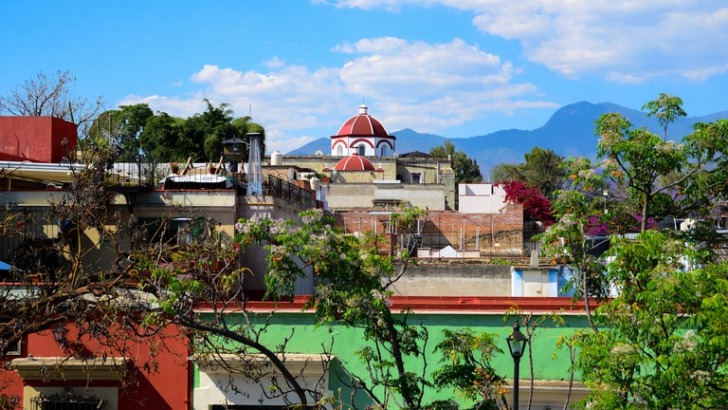
Mexico : Safety by City
- Aguascalientes
- Cabo San Lucas
- Chichen Itza
- Guadalajara
- Isla Holbox
- Isla Mujeres
- Mexico City
- Nuevo Laredo
- Piedras Negras
- Playa del Carmen
- Puerto Morelos
- Puerto Vallarta
- Queretaro City
- San Luis Potosi
- San Miguel de Allende
- Zihuatanejo
If you want to come to Oaxaca but you do not know what can be done and seen there, we will tell you that one of the top things to do in Oaxaca is exploring the central part of the city.
This part of the city is a great place to do some serious sightseeing, but you should not miss visiting the Templo de Santo Domingo, which is the 16th-century Baroque Catholic church.
You can expect pretty much from Oaxaca, being that the city is known for its delicious food, colorful streets, and beautiful ruins.
- Warnings & Dangers in Oaxaca
OVERALL RISK: MEDIUM
We cannot say that Oaxaca is either dangerous or not, as it mostly depends on the person who is visiting it. The majority of tourists leave it without any problems, but there are still those who had a bad experience there.
TRANSPORT & TAXIS RISK: HIGH
If you have decided to drive while in Mexico you should know that road conditions are not ideal. Be prepared to stop unexpectedly and beware of drivers who do not respect traffic signs.
PICKPOCKETS RISK: HIGH
It is important to take special care when withdrawing money from ATMs or exchanging money, as pickpockets tend to observe and follow those people and attack them when they are most vulnerable.
NATURAL DISASTERS RISK: MEDIUM
The greatest part of Mexico is subject to earthquakes. Tremors occur regularly so tourists need to be ready for possible dangers and listen to the news so as to get the current information.
MUGGING RISK: MEDIUM
Tourists should take precautions as there has been a rise in drug-related crime, and should not get involved with any kind of drug-related activities. If you are attacked with a gun, do not resist.
TERRORISM RISK: LOW
Mexico is not a country where terrorist attacks happen so the risk of the attacks is low. Tourists can feel free when this kind of danger is in question.
SCAMS RISK: HIGH
One of the possible scams is people presenting themselves as police officers. Their aim would be to rob you by trying to fine or arrest you without any reasons. Ask for identification and if they do not give it, try to find help.
WOMEN TRAVELERS RISK: MEDIUM
Mexico is a country where crime is on the rise, and females should be very careful when coming there. They should always be in groups or with a male by themselves so as to feel safer.
- So... How Safe Is Oaxaca Really?
Foreign visitors are frequently targeted by scammers who might approach you asking for financial help and you are suggested not to speak to them.
If strangers offer you a drink on the street, do not accept it as those might be scammers who would like to drug you with the intention to assault you or take your money.
If you have decided to drive in Mexico you should know that changing lane without indicating and going through red lights is frequent among Mexican drivers, so you have to be extra careful when driving.
There have been incidents of short-term kidnapping and victims were forced to withdraw funds from credit or debit cards.
If this happens to you, you should accept to give them what they request and not attempt to resist such attacks, as they might lead to more serious consequences.
Considering the fact that political demonstrations are common and can occur across the country, tourists are advised to stay away from these gatherings.
We suggest that it is safer to use ATMs during the day and to find those inside shops or malls being that there is a high risk of being attacked, assaulted and robbed if thieves notice that you have taken cash.
- How Does Oaxaca Compare?
- Useful Information
The entry requirements for tourists include the passport validity which should cover the period you are staying in Mexico and an immigration form that can be obtained either when you arrive or online in advance.
Due to the fact that there are numerous counterfeit notes, travelers are suggested to exchange money in banks and exchange offices. The official currency in Mexico is the Mexican Peso.
The climate here is a local steppe climate, meaning that there is very little rainfall during the year. May is the warmest month while January is the coldest month. Still, temperatures are high above freezing.
If you want to come to Oaxaca by plane, you should use Xoxocotlán International Airport which is located at Oaxaca. The airport operates both domestic and international air traffic.
Travel Insurance
We are advising travelers to take travel insurance prior to coming to Mexico in order to avoid possible unpleasant consequences later.
Oaxaca Weather Averages (Temperatures)
- Average High/Low Temperature
Mexico - Safety by City
- Where to Next?
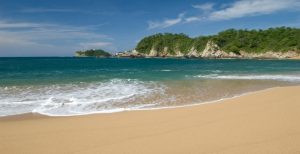
3 Reviews on Oaxaca
I felt safe in Centro. Took a guided tour into the food market Central de Abastos and was told before getting close to take my watch off and keep my camera in my bag. They told me to ask whenever I wanted photos as they would take them or tell me where it was safe to take phone out of my bag.
Me Quiero Oaxaca
Have had no problems — if anything there are too many police milling around but people are gentle and kind. Several times people pointed out that I’d dropped or almost dropped money (I’m too likely to stuff bills in a pocket or forget to zip my backpack).
Nothing but love for the people of Oaxaca.
A beautiful city
Overall I felt reasonably safe in Oaxaca. Yes, I took common sense precautions, but I do that anywhere. The city is very charming, most people are kind, and the food is nothing short of amazing. Highly recommend for those who wish to experience authentic Mexican culture.
Share Your Experience Cancel reply
Your Review
Title of your review
Article Contents
- Oaxaca : Safety by City
- Overall Risk
- Transport & Taxis Risk
- Pickpockets Risk
- Natural Disasters Risk
- Mugging Risk
- Terrorism Risk
- Women Travelers Risk
- Weather Averages (Temperatures)
- User Reviews
- Share Your Experience
Popular Destinations

Safety Index
Recent reviews & comments.
- Silvian on 17 Pros and Cons of Living in Canada
- Shan on Brisbane
- dummy above me on Saudi Arabia
- amora on 15 Pros and Cons of Living in Jamaica
- M.... on Amman
Popular US States
- Pennsylvania
clock This article was published more than 1 year ago
U.S. Embassy issues Mexico travel warnings to spring breakers
The state department is also warning against visiting six states.

U.S. authorities are sending an array of warnings to Mexico-bound spring break travelers: Be alert against criminal activity, watch out for counterfeit medication, avoid unregulated alcohol, don’t possess or use drugs.
But for the most part, officials are not telling people to stay away from the country, noting that “thousands” of Americans spend spring break in Mexico every year and that “the vast majority travel safely.”
The information comes from a spring break travel alert issued this week by the U.S. Embassy & Consulates in Mexico — and it follows several high-profile eruptions of disorder or violence around the country this year. Most recently, four Americans who crossed from Brownsville, Tex., to Matamoros were kidnapped earlier this month; two were killed and a third was injured.
Is it safe to travel to Mexico? Here's what to know.
“Crime, including violent crime, can occur anywhere in Mexico, including in popular tourist destinations,” the recent travel alert says, echoing a similar one put out last year. “Travelers should maintain a high level of situational awareness, avoid areas where illicit activities occur, and promptly depart from potentially dangerous situations.”
The embassy’s alert directs travelers to the U.S. State Department’s travel advisory for Mexico, which is broken down by state and was last updated in October. Tamaulipas , where the Americans were kidnapped, is one of six states that carry a “Do Not Travel” warning.
6 Mexico vacations that check every travel style
Most Mexican states — including those with tourist hot spots such as Cancún, Cozumel, Cabo San Lucas and Oaxaca — fall under the lower Level 2 category, where travelers are urged to “exercise increased caution.” But the alert warns visitors not to let their guard down, even in those less-risky areas.
“U.S. citizens should exercise increased caution in the downtown areas of popular spring break locations including Cancun, Playa Del Carmen, and Tulum, especially after dark,” it says.
In addition to crime, the travel alert warns of the risks of unknown substances or drinks, cautioning that unregulated alcohol could be tainted, counterfeit medication could contain dangerous ingredients and drug use could result in arrest, illness or worse.
“U.S. citizens have become seriously ill or died in Mexico after using synthetic drugs or adulterated prescription pills,” the warning says.
Travelers should limit the amount of cash they carry, be careful when withdrawing money, stick to regulated taxi services or app-based ride-shares, and stay with a group in clubs and bars or when getting around at night, the embassy says. The alert recommends participating in the Smart Traveler Enrollment Program, which provides information on safety conditions and contact information to the U.S. government.
Understanding the State Department's travel advisories
Another U.S. jurisdiction put out a much stronger warning last week, when the Texas Department of Public Safety urged Texans to avoid trips to Mexico altogether during spring break and after.
“Drug cartel violence and other criminal activity represent a significant safety threat to anyone who crosses into Mexico right now,” the department’s director, Steven McCraw, said in a statement. “We have a duty to inform the public about safety, travel risks and threats. Based on the volatile nature of cartel activity and the violence we are seeing there, we are urging individuals to avoid travel to Mexico at this time.”
The department wrote that “many people do travel to Mexico without incident” but said that “the serious risks cannot be ignored.”
Dale Buckner, CEO of security services firm Global Guardian , told The Washington Post last month that resort destinations are typically in “somewhat of a bubble” where the government has placed extra security and violence is not usually directed at visitors.
“If you’re at one of these hubs and you’re at a high-end resort, you’re going to see security and guys with guns on the beach,” he said. “They’re intentionally creating a safer environment; for the most part, it works.”
He urged travelers to take the kind of preparation they should make before they go anywhere in the world: planning for illness or injury and the need to return home in an emergency; knowing how to get out of a natural disaster; and anticipating what to do if they were hacked or kidnapped. And he said tourists also need to plan their activities with safety in mind, avoiding unnecessary risks.
“We highly encourage people to go to Mexico and enjoy it,” he said last month. “You just need to do a little bit of homework.”
Those who work in the travel industry in Mexico say the country is vast and cannot be painted with a single brush. Zachary Rabinor, founder and CEO of travel planning company Journey Mexico , said in an email last month that his staff monitors safety situations and operates where there are no travel restrictions.
“We are confident that with proper preparation and information, travel to and within Mexico continues to be a great option,” he said last month. “While there is no 100% guarantee of complete safety when traveling anywhere, even within the U.S. and Europe, working with a trusted and professional destination specialist minimizes risk and keeps travelers in the right places at the right time.”
More travel news
How we travel now: More people are taking booze-free trips — and airlines and hotels are taking note. Some couples are ditching the traditional honeymoon for a “buddymoon” with their pals. Interested? Here are the best tools for making a group trip work.
Bad behavior: Entitled tourists are running amok, defacing the Colosseum , getting rowdy in Bali and messing with wild animals in national parks. Some destinations are fighting back with public awareness campaigns — or just by telling out-of-control visitors to stay away .
Safety concerns: A door blew off an Alaska Airlines Boeing 737 Max 9 jet, leaving passengers traumatized — but without serious injuries. The ordeal led to widespread flight cancellations after the jet was grounded, and some travelers have taken steps to avoid the plane in the future. The incident has also sparked a fresh discussion about whether it’s safe to fly with a baby on your lap .

Is Mexico travel safe? What to know about visiting Cabo, Cancun, Playa del Carmen and more

With its warm climate, beautiful beaches and proximity to the U.S., Mexico is a popular tourist destination for many Americans. But recent incidents may have some people wondering if they should reconsider their travel plans.
Over the past few months, taxi drivers have been harassing Ubers in Cancun and there was the death of three Americans in Mexico City in October. Now an updated Travel Advisory warns of crime and kidnapping.
"We get this one a lot, especially by folks who haven't traveled as much, haven't left the country before, or have read stories about 'Mexico being dangerous' but maybe don't recognize it's a large, diverse country, much like ours," Jack Benoff, president of Vacationeeze , which specializes in destination weddings in Mexico, told USA TODAY. Many of Benoff's clients plan trips to Cancun and Riviera Maya, known for their turquoise beaches and myriad resorts.
Stay safe while traveling: Here are 17 CIA tips, advice to think like a spy on vacation
Staying safe: US tourists warned about popular Mexico spots plagued by drug cartel intimidation, violence
Learn more: Best travel insurance
The State Department updated the Travel Advisory for Mexico on Oct. 5, which is done regularly. Several tourist destinations, like Mexico City, Sayulita and Cancun, now have warnings related to cartel-related crime.
"The safety and security of U.S. citizens overseas is one of the department’s highest priorities, and we provide U.S. citizens with relevant information so they can make well-informed decisions before they travel," a State Department spokesperson said.
Read below to learn more about the Travel Advisory for Mexico's most popular tourist destinations and safety tips for visiting those areas.
Taxis vs. Uber: US issues Mexico security alert as Cancun taxi drivers block road, harass Uber cars
What is the updated Travel Advisory for Mexico?
Rather than providing one overall assessment for the entire country, each state is assessed individually, because some areas have an increased risk of crime and kidnapping.
► The agency issued a "do not travel to" warning for the Colima, Guerrero, Michoacan, Sinaloa, Tamaulipas and Zacatecas state because of violent crime.
► A "reconsider travel to" warning has been issued for Baja California and Jalisco, where Puerto Vallarta is.
► Mexico City, Nayarit, Baja California Sur, Quintana Roo and Oaxaca are issued an "exercised increased caution when traveling to" warning. Baja California Sur is home to Cabo San Lucas, San Jose del Cabo and La Paz. In Nayarit, many tourists visit the surf town Sayulita. Quintana Roo is home to Cancun, Tulum, Riviera Maya, Cozumel and Playa del Carmen. Surfers also like to visit Puerto Escondido in Oaxaca.
Travelers can "exercise normal precautions" when traveling to Yucatan, which includes the popular attraction Chichén Itzá. Yucatan state is right above Quintana Roo, where people should be more cautious because of crime and kidnapping, according to the State Department.
Protecting the sharks: Mexico indefinitely bans great white shark cage-diving at this tourist hotspot
'A terrible tragedy': 3 American tourists die of gas inhalation in Mexico City Airbnb
What are some safety travel tips for visiting Mexico?
The State Department has several resources to help keep travelers safe. The agency encourages U.S. travelers to read the entire Mexico Travel Advisory and its Traveler's Checklist , which details more information about traveling abroad.
There is also the Smart Traveler Enrollment Program , a free service for U.S. travelers to receive safety alerts about their destination from the U.S. Embassy in real time.
"Generally speaking, if you're in a resort town and at a reputable location, you're at a much lower risk," travel agent Benoff said.
Most resorts have security guards and gates, so staying on the property is pretty safe. "If you're leaving the resort property, ensure you have the correct address to where you're going and let the front desk know you're leaving and when you plan to return," he said.
"Use the same safety precautions you would when traveling anywhere."
A few of his top tips include:
- Don't flaunt cash.
- Use an ATM inside a bank or resort.
- Use the safe in your room.
- Bring two printed copies of your passport and other important documents, like medication or driver's licenses.
- Consider t ravel insurance to help protect stolen or lost personal property.
Kathleen Wong is a travel reporter based in Hawaii. You can reach her at [email protected]
We’re sorry, this site is currently experiencing technical difficulties. Please try again in a few moments. Exception: request blocked
- Skip to main content
- Skip to "About this site"
Language selection
Search travel.gc.ca.
Help us to improve our website. Take our survey !
COVID-19: travel health notice for all travellers
Mexico travel advice
Latest updates: The Need help? section was updated.
Last updated: April 29, 2024 07:16 ET
On this page
Safety and security, entry and exit requirements, laws and culture, natural disasters and climate, mexico - exercise a high degree of caution.
Exercise a high degree of caution in Mexico due to high levels of criminal activity and kidnapping.
Guerrero - Avoid all travel
This advisory excludes the cities of Ixtapa/Zihuatanejo, where you should exercise a high degree of caution.
Regional Advisory - Avoid non-essential travel
- all Chihuahua
- all Colima, except the city of Manzanillo
- all Coahuila, except the southern part of the state at and below the Saltillo-Torreón highway corridor
- all Durango, except Durango City
- Highway 45 between León and Irapuato
- the area south of and including Highway 45D between Irapuato and Celaya
- all Michoacán, except the cities of Morelia and Patzcuaro
- the Lagunas de Zempoala National Park
- the municipality of Xoxocotla
- the area within 20 km of the border with Sinaloa and Durango
- the city of Tepic
- all Nuevo León, except the city of Monterrey
- all Sinaloa, except the cities of Los Mochis and Mazatlán
- all Sonora, except the cities of Hermosillo and Guaymas/San Carlos and Puerto Peñasco
- all Tamaulipas
- all Zacatecas
Back to top
Deteriorating security situation in Guerrero State
Hurricane Otis struck Guerrero State on October 25, 2023. The security situation remains volatile and unpredictable after the storm. Damage to transportation and communications networks have left many towns and cities isolated, increasing the risk of criminal and gang activity.
Certain areas are particularly affected by banditry and violence, including:
- the highway between Acapulco and Zihuantanejo
- the highway between Acapulco to Chilpancingo
You should avoid all travel to Guerrero State. If you are in Guerrero despite the advisory, you should take necessary precautions to ensure your safety, including:
- avoid travelling alone or after dark
- exercise extreme vigilance
- monitor local media for the latest updates on the situation
- follow the instructions of local authorities
Levels of crime, particularly violent crime, are high throughout Mexico. Arrest and detention rates are low and don’t deter criminal activity.
Criminal groups, including drug cartels, are very active. Clashes between cartels or gangs over territory, drugs and smuggling routes are common.
In some parts of the country, military, navy and federal police forces have been deployed to combat organized crime and improve security conditions. They maintain a visible presence by:
- patrolling the streets
- setting up roadblocks
- conducting random vehicle checks
If you plan on travelling to Mexico:
- remain vigilant at all times
- stay in tourist areas
- be very cautious on major highways
- avoid travelling at night
- monitor local media closely
If you’re the victim of a crime, you must report it immediately to local authorities. No criminal investigation is possible without a formal complaint. Complaints must be made in person before leaving Mexico. You should hire a local lawyer to represent your interests and follow up on your case after you return to Canada. Failure to do may result in incomplete investigations or long delays in bringing cases to trial.
Violent crime
There are high rates of violent crime, such as homicides, kidnappings, carjacking and assaults, including in popular tourist destinations such as the Mayan Riviera (Cancún, Playa del Carmen, Puerto Morelos and Tulum), and Acapulco.
Criminal groups and drug cartels are present in tourist areas. Inter-gang and cartel fighting has taken place in restaurants, hotels and nightclubs frequented by tourists.
Innocent bystanders have been injured or killed. You may be in the wrong place at the wrong time and become a victim of violent crime.
Border areas often see higher criminal activity and violence, including in rural areas. Confrontations between organized criminal groups and Mexican authorities continue to pose a risk. Shootouts, attacks and illegal roadblocks may occur without warning.
You should travel to Mexico by air to avoid international land border crossings, particularly along the border with the United States, in the following cities:
- Ciudad Juárez
- Nuevo Laredo
If crossing an international land border:
- remain extremely vigilant
- use only official border crossings
Armed robbery
Armed robbery occurs. Foreigners have been targets of robberies that sometimes involve assault.
Robbers will follow a victim after they exchange or withdraw money at airports, currency exchange bureaus ( casas de cambio ) or ATMs.
- Stay in hotels and resorts with good security
- If you are threatened by robbers, stay calm and don’t resist
- Avoid withdrawing or exchanging money in public areas of the airport
Canadian travellers have been physically and sexually assaulted. In some cases, hotel employees, taxi drivers and security personnel at popular tourist destinations were involved. In some cases, hotel staff are not helpful and try to dissuade victims from pursuing the incident with police.
- Avoid walking after dark, especially alone
- Avoid isolated or deserted areas
- Avoid excessive alcohol consumption
Are you a victim of sexual violence? – Government of Canada and British Embassy Mexico City
Credit card and ATM fraud
Credit card and ATM fraud occurs in Mexico. When using debit or credit cards:
- pay careful attention when others are handling your cards
- use ATMs located in public areas or inside a bank or business
- avoid using card readers with an irregular or unusual feature
- cover the keypad with one hand when entering your PIN
- check for any unauthorized transactions on your account statements
Overcharging
Some bars and nightclubs may try to charge exorbitant prices. Discussions about overcharging may lead to threats of violence and security guards may force you to pay. Avoid running a tab or leaving your credit card with bar or restaurant staff.
Overseas fraud
Police officers
Legitimate police officers have extorted money from tourists or arrested tourists for minor offences such as :
- drinking alcohol on the street
- urinating on public roads
- traffic violations
They have requested immediate cash payment in exchange for their release. Travellers driving rental cars have been targeted.
If this occurs:
- don’t hand over your money or your passport
- ask for the officer’s name, badge and patrol car number
- ask for a copy of the written fine, which is payable at a later date, or insist on going to the nearest police station
Virtual kidnappings
Extortion, including virtual kidnappings, is the third most common crime in Mexico. Criminals use a variety of tactics to gather information about potential victims for extortion purposes, including using social media sites or eavesdropping on conversations
In a virtual kidnapping, criminals contact the victim’s hotel room landline and threaten the victim to stay in their room. The criminals then instruct the victim to provide information needed for the caller to use to contact family and friends, to demand the immediate payment of ransom for their release.
- Don't discuss travel plans, your room number or any other personal information around strangers
- Never leave your cellphone unattended
- Ensure your cellphone is password protected
- Don't divulge personal business details to strangers in person or over the phone or on social media, especially when using hotel phones
- If you're threatened on the phone or hear screams, hang up immediately
- When you answer the phone, wait for the caller to speak. If the caller asks who is speaking, hang up immediately.
- Don’t answer unrecognized or blocked phone numbers
- Don’t answer hotel landlines
Kidnappings
Mexico has one of the highest kidnapping rates in the world. Kidnapping, including virtual and express kidnapping, is a serious security risk throughout Mexico.
Kidnappers target all classes. Canadian citizens and contractors working for Canadian businesses have been kidnapped, mostly in areas that are not under the control of police and security forces.
If you're kidnapped:
- comply with the kidnappers’ requests
- don’t attempt to resist
Express kidnappings
Express kidnappings occur in large urban areas. This is a method of kidnapping where criminals ask for a small and immediate ransom.
Thieves most commonly work in cooperation with, or pose as, taxi drivers. They force victims to use their debit or credit card to withdraw money from ATMs in exchange for their release.
- Use only a reputable taxi company or a trusted ride-sharing app
- Book taxis through your hotel or an authorized taxi stand ( sitio )
Petty theft
Petty crime, such as pickpocketing and purse snatching, is common in Mexico.
- Be aware of your surroundings at all times, even in areas normally considered safe
- Ensure that your belongings, including your passport and other travel documents, are secure at all times
- Avoid showing signs of affluence, such as flashy jewellery, cell phones, headphones and designer bags
- Carry only small amounts of money
- Be cautious when withdrawing cash from ATMs
Home break-ins
Tourists staying in rental homes have been the victims of break-ins and burglaries. Whether you're staying in private or commercial accommodations, make sure you lock windows and doors securely.
Women’s safety
Women travelling alone may be subject to some forms of harassment and verbal abuse.
Some incidents of assault, rape and sexual assault against Canadian women have occurred, including at beach resorts and on public buses.
- Exercise caution when dealing with strangers or recent acquaintances
- Be wary of rides or other invitations
Advice for women travellers
Spiked food and drinks
Never leave food or drinks unattended or in the care of strangers. Be wary of accepting snacks, beverages, gum or cigarettes from new acquaintances. These items may contain drugs that could put you at risk of sexual assault and robbery.
Unregulated alcohol
Some bars, restaurants and resorts have served counterfeit alcohol. Some travellers have reported getting sick or blacking out after drinking alcohol.
- Be cautious if you choose to drink alcohol
- Seek medical assistance if you begin to feel sick
Alcohol, drugs and travel
Height standards for balcony railings in Mexico can be considerably lower than those in Canada. Falls have resulted in deaths and injuries.
- Exercise caution when standing close to balcony railings
Demonstrations
Demonstrations take place regularly throughout the country. Protests and roadblocks are common in:
- Mexico City, including to and from the airport
- the states of Chiapas, Guerrero, Michoacán and Oaxaca
Such incidents may last a long time, leading to shortages of fresh food, medicine and gasoline.
Even peaceful demonstrations can turn violent at any time. They can also lead to disruptions to traffic and public transportation.
- Avoid areas where demonstrations and large gatherings are taking place
- Follow the instructions of local authorities
- Monitor local media for information on ongoing demonstrations
Mass gatherings (large-scale events)
Water activities
Coastal waters can be dangerous. Riptides are common. Several drownings occur each year.
Many beaches don’t offer warnings of dangerous conditions and they don’t always have lifeguards on duty.
Rescue services may not be consistent with international standards.
- Consult local residents and tour operators for information on possible hazards and safe swimming areas
- Always obey warning flags at beaches
- Follow the instructions and warnings of local authorities
Water sports
Tour operators may not adhere to international standards. Many operators don’t conduct regular safety checks on their sporting and aquatic equipment.
Also, Canadians have been involved in accidents where operators of recreational vehicles, such as watercraft, have demanded compensation exceeding the value of the damage caused to the vehicle or equipment.
If you undertake water sports, such as diving:
- choose a well-established and reputable company that has insurance
- ensure that your travel insurance covers the recreational activities you choose
- wear the appropriate safety equipment, such as helmets and life jackets
- ensure that equipment is available and in good condition
- don’t consume alcohol before the activity
If in doubt concerning the safety of the facilities or equipment, don’t use them.
Water safety abroad
Adventure tourism
Outdoor activities, such as white water rafting, kayaking, scuba diving, snorkelling, bungee, zip lining, paragliding, hiking, mountain biking, etc and other adventure activities can be dangerous if unprepared. Trails are not always marked, and weather conditions can change rapidly, even during summer.
Tour operators may not always adhere to international safety standards.
If you intend to practice adventure tourism:
- consider hiring an experienced guide from a reputable company
- obtain detailed information on your activity and on the environment in which you will be setting out
- buy travel insurance that includes helicopter rescue and medical evacuation
- know the symptoms of acute altitude sickness, which can be fatal
- pay attention to the symptoms of dehydration and heatstroke, both of which can be fatal
- avoid venturing off marked trails
- ensure that you’re adequately equipped and bring sufficient water
- stay informed about weather and other conditions that may pose a hazard
- refrain from using facilities or equipment if you have doubts on their safety
- inform a family member or friend of your itinerary
Road travel
Road conditions and road safety.
Road conditions and road safety can vary greatly throughout the country.
Road conditions can be dangerous due to:
- sharp curves
- poorly marked or hidden road signs
- construction sites
- roaming livestock
- slow-moving or abandoned vehicles
Toll highways are typically safer and better maintained than secondary highways.
Mexican driving styles are very different from those in Canada. Many drivers don’t respect traffic laws, and police don’t strictly enforce these laws. Drivers often drive at excessive speeds and may be aggressive or reckless. Drinking and driving laws are not strictly enforced. Accidents causing fatalities are common. Police don’t regularly patrol the highways.
Roadblocks and checkpoints
Illegal roadblocks and demonstrations are common. Heavily armed gangs have attacked travellers on intercity highways. Criminals especially target sport utility vehicles and full-size pickup trucks for theft and carjacking.
The military searches for drugs and firearms at military checkpoints throughout the country.
- Avoid road travel at night between cities throughout the country
- Ensure that you only stop in major centres, at reputable hotels or at secure campsites
- Keep your car doors locked and the windows closed, especially at traffic lights
- Avoid hitchhiking which is not a common practice in Mexico
- Don’t leave valuables in the vehicle
- Rent cars that don’t have stickers or other advertisements for the rental company on them, as rental cars have been targets for robbery, sometimes using force
- Ensure operators provide insurance and helmets if renting scooters
- Travel on toll roads to lower the risk of targeted roadblocks and robberies
- Never attempt to cross roadblocks, even if they appear unattended
Public transportation
Remain vigilant in airports, at bus stations, on buses and on the metro.
The Mexico City metro is often very crowded and a popular place for pickpocketing. There are metro cars dedicated to women and children during rush hours. They are located at the front of the trains.
The Metrobus in Mexico City, which has dedicated lanes and stops, is relatively safe. There are sections dedicated to women and children at the front of the buses.
The “colectivos” and “pesero” mini-buses that stop when hailed are frequently targeted for robbery.
When travelling to other cities, use bus companies that offer VIP or executive class transportation. These buses only travel on toll roads, which lower the risks of targeted roadblocks and robberies, and follow a speed limit.
Taxis and ridesharing services
Disputes between taxi and ridesharing application drivers may occur, especially in Quintana Roo. They may result in:
- altercations
Although tourists have not been targeted, you may be caught up in these incidents and harassed or injured.
In Mexico City, all government-authorized taxis have licence plates starting with “A” or “B.” Taxis from designated stands have both the logo of their company and the plate number stamped on the side of the car. Official taxis in Mexico City are pink and white. Users can validate the pink and white taxis on the CDMX app.
- Avoid hailing taxis on the street
- Don't share taxis with strangers
When arriving at an airport in Mexico, pre-pay the taxi fare at the airport (inside or outside the terminal) and ask to see the driver’s official identification. You can also use a ridesharing app to arrange for a pickup at certain airports. Not all airports in Mexico allow ridesharing service pickups.
If you use a trusted ridesharing app, confirm the driver’s identity and the licence plate before getting in the car.
Mi Taxi – CDMX app (in Spanish)
Cruise ship travel
Plan carefully if you plan to take a cruise departing from or stopping in Mexico.
Advice for cruise travellers
Pirate attacks and armed robbery against ships occur in coastal waters of the Bay of Campeche. Mariners should take appropriate precautions.
Live piracy report - International Maritime Bureau
We do not make assessments on the compliance of foreign domestic airlines with international safety standards.
Information about foreign domestic airlines
Every country or territory decides who can enter or exit through its borders. The Government of Canada cannot intervene on your behalf if you do not meet your destination’s entry or exit requirements.
We have obtained the information on this page from the Mexican authorities. It can, however, change at any time.
Verify this information with the Foreign Representatives in Canada .
Entry requirements vary depending on the type of passport you use for travel.
Before you travel, check with your transportation company about passport requirements. Its rules on passport validity may be more stringent than the country’s entry rules.
Regular Canadian passport
Your passport must be valid for the expected duration of your stay in Mexico.
Passport for official travel
Different entry rules may apply.
Official travel
Passport with “X” gender identifier
While the Government of Canada issues passports with an “X” gender identifier, it cannot guarantee your entry or transit through other countries. You might face entry restrictions in countries that do not recognize the “X” gender identifier. Before you leave, check with the closest foreign representative for your destination.
Other travel documents
Different entry rules may apply when travelling with a temporary passport or an emergency travel document. Before you leave, check with the closest foreign representative for your destination.
Useful links
- Foreign Representatives in Canada
- Canadian passports
Tourist visa: not required Business visa: required Work visa: required Student visa: required
Required documents
To enter Mexico, you must present a valid passport and a duly completed tourist card (Multiple Immigration Form). Carry documents to prove the purpose of trip, such as hotel or tour booking confirmations, as immigration officers may request them.
Tourist card
You must obtain a tourist card to enter the country unless you stay in Mexico for less than 72 hours within the northern border zone.
If you don’t obtain a tourist card upon arrival, you may face:
It is highly recommended to keep your digital tourist card, or tourist card if entered by land, with you at all times as proof of your legal stay in Mexico. You may be asked to show it to Mexican officials when exiting the country or if you are stopped on an immigration check point.
If you are stopped at an immigration check point and you are unable to prove your legal stay, you may be fined, detained or expelled from the country.
Entering by land
If entering Mexico by land, you must stop at the immigration office located at the border to obtain a tourist card, even if not explicitly directed by Mexican officials. Immigration officials will write down on your tourist card the number of days you are allowed to stay in Mexico.
You may complete the tourist card form online before your arrival. However, you must print the form and present it to the migration official at the port of entry.
Multiple Immigration Form - Government of Mexico
Entering by air
If entering Mexico by air, you are advised to download your tourist card issued by Mexican officials upon entry.
Depending on your airport of entry:
- the immigration official will stamp your passport and note the number of days you are allowed to spend in Mexico or
- you will go through an E-gate kiosk where you will scan your passport and self-register your entry in the country. Only use this option if you are entering Mexico as a tourist.
Once in the country, whether you entered via a E-gate or not, you will be able to access the digital tourist card online. You have 60 days to download it.
If you are unable to show your tourist card or digital tourist card upon departure, you will have to pay for a replacement at the immigration office of any international airport before boarding.
Make sure to plan sufficient time at the airport to obtain a new card in time for your flight.
Portal access for digital tourist card - Government of Mexico
Length of stay
An immigration official will determine the number of days you can remain in Mexico and note it on your tourist card. The maximum length granted for a tourism-related trip is 180 days; the maximum number of days is not granted by default.
If you're seeking the maximum number of days, you may be required to:
- explain the purpose of your trip to the immigration official
- provide details about your trip (accommodations, funds, return flight, etc.)
You won’t be able to request an extension or change the condition of your stay from inside the country.
Canadians travelling to the northern border zone (within 21 kilometres of the U.S. border) for work don’t require a visa for stays of 72 hours or less.
If you require a business or work visa, you should take care of the process yourself. If a prospective employer is processing your visa for you:
- obtain copies of all correspondence between the employer and Mexican immigration authorities
- verify that these copies are stamped by the immigration authorities as proof that your papers are being processed
- request a receipt from your employer for any document that you provide for purposes of obtaining the visa
- avoid surrendering your passport to your employer
Volunteer, religious, research and eco-tourism activities
You may not be able to undertake volunteer, religious/missionary, research or certain forms of eco-tourism activities while visiting as a tourist. Contact the Mexican Embassy or closest Mexican consulate for information the type of visa required for these activities.
Tourism tax
Most visitors to Mexico must pay a tourism tax.
This fee is normally included in airline ticket prices. Visitors arriving by road or sea will have to pay this fee at any bank in Mexico. There is a bank representative at every port of entry. The bank receipt must be attached to the tourist card for submission at departure.
You don't have to pay this tax if:
- you're entering by land for tourism purposes, and your stay will not exceed 7 days
- you're travelling to the northern border zone for less than 72 hours
- you're travelling to Mexico on a cruise ship
Dual citizenship
If entering and leaving Mexico as a dual citizen, you must identify yourself as a Mexican citizen. You must carry valid passports for both countries.
Laws about dual citizenship
Criminal records
Canadians with a criminal record or a warrant for arrest may be refused entry and returned to Canada or to a third country on the next available flight.
Children and travel
Learn more about travelling with children .
Yellow fever
Learn about potential entry requirements related to yellow fever (vaccines section).
Relevant Travel Health Notices
- Global Measles Notice - 13 March, 2024
- Zika virus: Advice for travellers - 31 August, 2023
- COVID-19 and International Travel - 13 March, 2024
- Dengue: Advice for travellers - 8 April, 2024
This section contains information on possible health risks and restrictions regularly found or ongoing in the destination. Follow this advice to lower your risk of becoming ill while travelling. Not all risks are listed below.
Consult a health care professional or visit a travel health clinic preferably 6 weeks before you travel to get personalized health advice and recommendations.
Routine vaccines
Be sure that your routine vaccinations , as per your province or territory , are up-to-date before travelling, regardless of your destination.
Some of these vaccinations include measles-mumps-rubella (MMR), diphtheria, tetanus, pertussis, polio, varicella (chickenpox), influenza and others.
Pre-travel vaccines and medications
You may be at risk for preventable diseases while travelling in this destination. Talk to a travel health professional about which medications or vaccines may be right for you, based on your destination and itinerary.
Yellow fever is a disease caused by a flavivirus from the bite of an infected mosquito.
Travellers get vaccinated either because it is required to enter a country or because it is recommended for their protection.
- There is no risk of yellow fever in this country.
Country Entry Requirement*
- Proof of vaccination is not required to enter this country.
Recommendation
- Vaccination is not recommended.
* It is important to note that country entry requirements may not reflect your risk of yellow fever at your destination. It is recommended that you contact the nearest diplomatic or consular office of the destination(s) you will be visiting to verify any additional entry requirements.
About Yellow Fever
Yellow Fever Vaccination Centres in Canada
There is a risk of hepatitis A in this destination. It is a disease of the liver. People can get hepatitis A if they ingest contaminated food or water, eat foods prepared by an infectious person, or if they have close physical contact (such as oral-anal sex) with an infectious person, although casual contact among people does not spread the virus.
Practise safe food and water precautions and wash your hands often. Vaccination is recommended for all travellers to areas where hepatitis A is present.
Measles is a highly contagious viral disease. It can spread quickly from person to person by direct contact and through droplets in the air.
Anyone who is not protected against measles is at risk of being infected with it when travelling internationally.
Regardless of where you are going, talk to a health care professional before travelling to make sure you are fully protected against measles.
Hepatitis B is a risk in every destination. It is a viral liver disease that is easily transmitted from one person to another through exposure to blood and body fluids containing the hepatitis B virus. Travellers who may be exposed to blood or other bodily fluids (e.g., through sexual contact, medical treatment, sharing needles, tattooing, acupuncture or occupational exposure) are at higher risk of getting hepatitis B.
Hepatitis B vaccination is recommended for all travellers. Prevent hepatitis B infection by practicing safe sex, only using new and sterile drug equipment, and only getting tattoos and piercings in settings that follow public health regulations and standards.
Coronavirus disease (COVID-19) is an infectious viral disease. It can spread from person to person by direct contact and through droplets in the air.
It is recommended that all eligible travellers complete a COVID-19 vaccine series along with any additional recommended doses in Canada before travelling. Evidence shows that vaccines are very effective at preventing severe illness, hospitalization and death from COVID-19. While vaccination provides better protection against serious illness, you may still be at risk of infection from the virus that causes COVID-19. Anyone who has not completed a vaccine series is at increased risk of being infected with the virus that causes COVID-19 and is at greater risk for severe disease when travelling internationally.
Before travelling, verify your destination’s COVID-19 vaccination entry/exit requirements. Regardless of where you are going, talk to a health care professional before travelling to make sure you are adequately protected against COVID-19.
The best way to protect yourself from seasonal influenza (flu) is to get vaccinated every year. Get the flu shot at least 2 weeks before travelling.
The flu occurs worldwide.
- In the Northern Hemisphere, the flu season usually runs from November to April.
- In the Southern Hemisphere, the flu season usually runs between April and October.
- In the tropics, there is flu activity year round.
The flu vaccine available in one hemisphere may only offer partial protection against the flu in the other hemisphere.
The flu virus spreads from person to person when they cough or sneeze or by touching objects and surfaces that have been contaminated with the virus. Clean your hands often and wear a mask if you have a fever or respiratory symptoms.
Malaria is a serious and sometimes fatal disease that is caused by parasites spread through the bites of mosquitoes. There is a risk of malaria in certain areas and/or during a certain time of year in this destination.
Antimalarial medication may be recommended depending on your itinerary and the time of year you are travelling. Consult a health care professional or visit a travel health clinic before travelling to discuss your options. It is recommended to do this 6 weeks before travel, however, it is still a good idea any time before leaving. Protect yourself from mosquito bites at all times: • Cover your skin and use an approved insect repellent on uncovered skin. • Exclude mosquitoes from your living area with screening and/or closed, well-sealed doors and windows. • Use insecticide-treated bed nets if mosquitoes cannot be excluded from your living area. • Wear permethrin-treated clothing. If you develop symptoms similar to malaria when you are travelling or up to a year after you return home, see a health care professional immediately. Tell them where you have been travelling or living.
In this destination, rabies is carried by dogs and some wildlife, including bats. Rabies is a deadly disease that spreads to humans primarily through bites or scratches from an infected animal. While travelling, take precautions , including keeping your distance from animals (including free-roaming dogs), and closely supervising children.
If you are bitten or scratched by an animal while travelling, immediately wash the wound with soap and clean water and see a health care professional. Rabies treatment is often available in this destination.
Before travel, discuss rabies vaccination with a health care professional. It may be recommended for travellers who are at high risk of exposure (e.g., occupational risk such as veterinarians and wildlife workers, children, adventure travellers and spelunkers, and others in close contact with animals).
Safe food and water precautions
Many illnesses can be caused by eating food or drinking beverages contaminated by bacteria, parasites, toxins, or viruses, or by swimming or bathing in contaminated water.
- Learn more about food and water precautions to take to avoid getting sick by visiting our eat and drink safely abroad page. Remember: Boil it, cook it, peel it, or leave it!
- Avoid getting water into your eyes, mouth or nose when swimming or participating in activities in freshwater (streams, canals, lakes), particularly after flooding or heavy rain. Water may look clean but could still be polluted or contaminated.
- Avoid inhaling or swallowing water while bathing, showering, or swimming in pools or hot tubs.
Travellers' diarrhea is the most common illness affecting travellers. It is spread from eating or drinking contaminated food or water.
Risk of developing travellers' diarrhea increases when travelling in regions with poor standards of hygiene and sanitation. Practise safe food and water precautions.
The most important treatment for travellers' diarrhea is rehydration (drinking lots of fluids). Carry oral rehydration salts when travelling.
Typhoid is a bacterial infection spread by contaminated food or water. Risk is higher among children, travellers going to rural areas, travellers visiting friends and relatives or those travelling for a long period of time.
Travellers visiting regions with a risk of typhoid, especially those exposed to places with poor sanitation, should speak to a health care professional about vaccination.
Salmonellosis is a common illness among travellers to this country. It can be spread through contaminated food or beverages, such as raw or undercooked poultry and eggs, as well as fruits or vegetables.
Practice safe food and water precautions . This includes only eating food that is properly cooked and still hot when served.
Pregnant women, children under 5 years of age, those over 60 years of age, and those with weakened immune systems are at greater risk of becoming seriously ill.
Cases of multidrug-resistant (MDR) Salmonella have been reported among Canadian travellers returning from Mexico. These strains of Salmonella do not respond to some of the recommended antibiotics if treatment is needed.
Most people recover on their own without medical treatment and from proper rehydration (drinking lots of fluids).
- Carry oral rehydration salts when travelling.
Travellers with severe symptoms should consult a health care professional as soon as possible.
Insect bite prevention
Many diseases are spread by the bites of infected insects such as mosquitoes, ticks, fleas or flies. When travelling to areas where infected insects may be present:
- Use insect repellent (bug spray) on exposed skin
- Cover up with light-coloured, loose clothes made of tightly woven materials such as nylon or polyester
- Minimize exposure to insects
- Use mosquito netting when sleeping outdoors or in buildings that are not fully enclosed
To learn more about how you can reduce your risk of infection and disease caused by bites, both at home and abroad, visit our insect bite prevention page.
Find out what types of insects are present where you’re travelling, when they’re most active, and the symptoms of the diseases they spread.
There is a risk of chikungunya in this country. The risk may vary between regions of a country. Chikungunya is a virus spread through the bite of an infected mosquito. Chikungunya can cause a viral disease that typically causes fever and pain in the joints. In some cases, the joint pain can be severe and last for months or years.
Protect yourself from mosquito bites at all times. There is no vaccine available for chikungunya.
- In this country, dengue is a risk to travellers. It is a viral disease spread to humans by mosquito bites.
- Dengue can cause flu-like symptoms. In some cases, it can lead to severe dengue, which can be fatal.
- The level of risk of dengue changes seasonally, and varies from year to year. The level of risk also varies between regions in a country and can depend on the elevation in the region.
- Mosquitoes carrying dengue typically bite during the daytime, particularly around sunrise and sunset.
- Protect yourself from mosquito bites . There is no vaccine or medication that protects against dengue.
Zika virus is a risk in this country.
Zika virus is primarily spread through the bite of an infected mosquito. It can also be sexually transmitted. Zika virus can cause serious birth defects.
During your trip:
- Prevent mosquito bites at all times.
- Use condoms correctly or avoid sexual contact, particularly if you are pregnant.
If you are pregnant or planning a pregnancy, you should discuss the potential risks of travelling to this destination with your health care provider. You may choose to avoid or postpone travel.
For more information, see Zika virus: Pregnant or planning a pregnancy.
American trypanosomiasis (Chagas disease) is a risk in this country. It is caused by a parasite spread by infected triatomine bugs. The infection can be inactive for decades, but humans can eventually develop complications causing disability and even death.
Risk is generally low for most travellers. Protect yourself from triatomine bugs, which are active at night, by using mosquito nets if staying in poorly-constructed housing. There is no vaccine available for Chagas disease.
Animal precautions
Some infections, such as rabies and influenza, can be shared between humans and animals. Certain types of activities may increase your chance of contact with animals, such as travelling in rural or forested areas, camping, hiking, and visiting wet markets (places where live animals are slaughtered and sold) or caves.
Travellers are cautioned to avoid contact with animals, including dogs, livestock (pigs, cows), monkeys, snakes, rodents, birds, and bats, and to avoid eating undercooked wild game.
Closely supervise children, as they are more likely to come in contact with animals.
Person-to-person infections
Stay home if you’re sick and practise proper cough and sneeze etiquette , which includes coughing or sneezing into a tissue or the bend of your arm, not your hand. Reduce your risk of colds, the flu and other illnesses by:
- washing your hands often
- avoiding or limiting the amount of time spent in closed spaces, crowded places, or at large-scale events (concerts, sporting events, rallies)
- avoiding close physical contact with people who may be showing symptoms of illness
Sexually transmitted infections (STIs) , HIV , and mpox are spread through blood and bodily fluids; use condoms, practise safe sex, and limit your number of sexual partners. Check with your local public health authority pre-travel to determine your eligibility for mpox vaccine.
Medical services and facilities
The quality of care varies greatly throughout the country.
Good health care is available in private hospitals and clinics, but it’s generally expensive. Most private facilities won’t agree to deal directly with medical insurance companies and will require payment with a credit card in advance or a bank transfer/direct deposit.
Mental health services are extremely limited in Mexico, particularly outside of Mexico City. Services and treatment standards may differ substantially from those in Canada.
Medical evacuation can be very expensive and you may need it in case of serious illness or injury.
Make sure you get travel insurance that includes coverage for medical evacuation and hospital stays.
Travel health and safety
Medical tourism
Medical tourism is common in Mexico. Canadian travellers have had serious health complications following cosmetic or other elective surgeries abroad.
Before leaving for medical travel, you should do your research, especially on:
- the health and financial risks
- the medical facility where the procedure will be performed
- language barriers, which can lead to misunderstandings about your medical care and conditions
- travel insurance that includes coverage for the type of medical procedure you will be undergoing
You should discuss your medical plans with your primary healthcare provider in Canada before travelling. Most provincial and territorial health care programs are extremely limited in their coverage offered abroad.
- Make sure that the healthcare providers you choose are authorized by the Mexican health authorities
- Ask to see the credentials of the healthcare providers
- Obtain a written agreement detailing the proposed treatment or procedure
- Receiving medical care outside Canada
- If you become sick or injured while travelling outside Canada or after your return
- Medical tourism – Government of Mexico (in Spanish)
If you take prescription medication, you’re responsible for determining their legality in Mexico.
- Bring sufficient quantities of your medication with you
- Always keep your medication in the original container
- Pack your medication in your carry-on luggage
- Carry a copy of your prescriptions
Medication cannot be sent to Mexico from Canada via courier services.
Many types of medication—both over-the-counter and prescription—are readily available with little oversight. Counterfeit medication is common in certain parts of Mexico. If you need to purchase medication while in Mexico, make sure to get it from a reputable location.
Federal Commission for protection against sanitary risk (in Spanish)
Air quality in Mexico City
In Mexico City, you may experience health problems caused by high altitude or by air pollution, which is at its peak during the winter months.
Consult your doctor before booking your trip if you have lung, heart or respiratory problems.
Death in Mexico
If you plan to retire or spend long periods of time in Mexico, or travel there for medical procedures, you should:
- share your plans or wishes with relatives
- make sure important documents can easily be located
- make arrangements in case of your death while in the country
- What if I Die in Mexico? – Fact sheet
- Death Abroad Factsheet
Keep in Mind...
The decision to travel is the sole responsibility of the traveller. The traveller is also responsible for his or her own personal safety.
Be prepared. Do not expect medical services to be the same as in Canada. Pack a travel health kit , especially if you will be travelling away from major city centres.
You must abide by local laws.
Penalties for breaking the law in Mexico can be more severe than in Canada, even for similar offences.
Foreign nationals are often held in pre-trial detention and there can be lengthy delays before a trial.
Many petty crimes (such as public urination, failure to pay a bill or disorderly behaviour) can result in a 72-hour detention by police. Paying a fine can secure an early release from detention.
Detention conditions are below the standards of Canadian prisons.
- Overview of the criminal law system in Mexico
- Arrest and detention
Penalties for possession, use or trafficking of illegal drugs are severe. Convicted offenders can expect lengthy prison sentences.
Drugs, alcohol and travel
Smoking is prohibited in all public places except for clearly marked designated smoking areas. This includes but is not limited to:
- restaurants
You may be fined if you’re caught smoking in public.
Electronic cigarettes
It’s illegal to bring electronic cigarettes/vaping devices and solutions into Mexico.
You could have these items confiscated by customs officials if you have them in your possession. You could also be fined or detained.
It is strictly prohibited to sell or distribute these devices and solutions in Mexico.
Imports and exports
The Mexican government strictly enforces its laws concerning possession, importation and trafficking of firearms.
Anyone entering Mexico with a firearm or ammunition without prior written authorization from Mexican authorities is subject to imprisonment.
It is also illegal to enter the country with certain types of knives.
Importing vehicles and boats
Mexico has very strict rules regarding the importation of foreign vehicles and boats.
You must enter Mexico with the proper import permit and insurance, since it cannot be obtained once you are in Mexico. You may face a fine and have your vehicle seized if you enter Mexico without the proper permit.
You must present a paper document of your vehicle registration to obtain a vehicle importation permit from the Mexican authorities. If you present a digital document of your vehicle registration, your vehicle may be refused entry into Mexico.
- Vehicle importation – Government of Mexico (in Spanish)
- Temporary vehicle import application system – Banjército
- Travelling to Mexico by land – Mexican Embassy in Canada
Cigarettes and alcohol
If you are older than 18, you are allowed to bring into Mexico up to:
- 10 cigarette packs
- 25 cigars or
- 200 grams of tobacco
- 3 litres of alcohol and
- 6 litres of wine
If you bring more alcohol and cigarettes into Mexico than allowed, even if you declare your imported items, you will be subject to a high import fee. You will still be subject to a significant fee if you decide to relinquish your imported items
It’s illegal to possess archaeological artefacts or to export such items from Mexico.
- Goods you can bring to Mexico as part of your personal luggage – Government of Mexico
- Goods you cannot bring into Mexico – Government of Mexico
- Agricultural product restrictions – Government of Mexico (in Spanish)
Political activity
It’s illegal for foreigners to conduct political activity in Mexico, including participating in demonstrations.
2SLGBTQI+ travellers
Mexican law does not prohibit sexual acts between individuals of the same sex. However, homosexuality is not widely accepted in Mexican society, particularly in rural areas.
2SLGBTQI+ travellers could be discriminated against based on their sexual orientation, gender identity, gender expression or sex characteristics. Transgender and gender non-conforming individuals are disproportionately targeted for violence and can face discrimination.
Travel and your sexual orientation, gender identity, gender expression and sex characteristics
Dual citizenship is legally recognized in Mexico.
If you are a Canadian citizen, but also a citizen of Mexico, our ability to offer you consular services may be limited while you're there. You may also be subject to different entry/exit requirements .
Travellers with dual citizenship
International Child Abduction
The Hague Convention on the Civil Aspects of International Child Abduction is an international treaty. It can help parents with the return of children who have been removed to or retained in certain countries in violation of custody rights. The convention applies between Canada and Mexico.
If your child was wrongfully taken to, or is being held in Mexico, and if the applicable conditions are met, you may apply for the return of your child to the Mexican court.
If you are in this situation:
- act as quickly as you can
- contact the Central Authority for your province or territory of residence for information on starting an application under The Hague Convention
- consult a lawyer in Canada and in Mexico to explore all the legal options for the return of your child
- report the situation to the nearest Canadian government office abroad or to the Vulnerable Children’s Consular Unit at Global Affairs Canada by calling the Emergency Watch and Response Centre
If your child was removed from a country other than Canada, consult a lawyer to determine if The Hague Convention applies.
Be aware that Canadian consular officials cannot interfere in private legal matters or in another country’s judicial affairs.
- List of Canadian Central Authorities for the Hague Convention
- International Child Abduction: A Guidebook for Left-Behind Parents
- Travelling with children
- The Hague Convention - Hague Conference on Private International Law
- Canadian embassies and consulates by destination
- Emergency Watch and Response Centre
There are no clear procedures or regulations about surrogacy in Mexico.
If you're considering surrogacy, seek advice from legal professionals knowledgeable in Canadian and Mexican laws and citizenship procedures.
Identity documents
The names on your identity documents must be identical to those on your birth certificate to obtain official Mexican documents, such as marriage certificates, immigration documents or passports.
Middle names are often left off Canadian identity documents. This has caused significant difficulties for many Canadians. If you plan on residing in Mexico or dealing with the Mexican Civil Registry, obtain a Canadian passport that will meet Mexican requirements.
Identification
You should carry photo identification.
Authorities can ask you to show identification and a proof of your legal status in Mexico. They can demand to see your tourist card at any time. You must carry the original at all times. You must carry the original at all times, and should also carry a photocopy of the identification page of your passport.
Investments
If you plan on buying property, or making other investments in Mexico, seek legal advice in Canada and in Mexico. Do so before making commitments. Related disputes could take time and be costly to resolve.
Mexican real estate agents are not licensed or regulated.
- Choose your own lawyer
- Avoid hiring a lawyer recommended by a seller
Problems with timeshare arrangements occur.
Timeshare representatives may be very persistent. They use pressure tactics and offer free tours, meals, gifts or alcoholic beverages.
It's illegal for timeshare companies to ask you to sign a waiver that prevents you from cancelling a contract. You're legally entitled to cancel a timeshare contract without penalty within 5 working days. Contracts must be cancelled in writing directly with the timeshare company.
Before purchasing a timeshare:
- gather as much information as possible
- review carefully the contract; anything not included in the contract will not be honoured
- provide your credit card only if you are sure you want to make the purchase
- keep copies of all correspondence
If you suspect a fraud in the real estate procedures, contact the Federal Attorney’s Office of Consumer immediately.
- Federal Attorney’s Office of Consumer (PROFECO) – Mexican Government (in Spanish)
- Should I buy a timeshare in Mexico? - Embassy of Mexico in Canada
- Should I sell my timeshare in Mexico? - Embassy of Mexico in Canada
Rental accommodations
Rental agreements between two individuals in Mexico are considered a private matter and are not regulated by the government.
If you encounter difficulties with a rental agreement, you must obtain the services of a Mexican lawyer.
You should carry an international driving permit.
International Driving Permit
Auto insurance
Mexican liability insurance is mandatory. Canadian automobile insurance is not valid in Mexico.
You can obtain insurance at the Mexican border. You should obtain full coverage, including coverage for legal assistance.
Automobile insurance is much more expensive in Mexico than in Canada. Many local drivers don’t have any form of car insurance.
If you’re involved in an accident, and you don’t have Mexican liability insurance, you could be prevented from leaving the country until all parties agree that adequate financial satisfaction has been received. If you’re found to be under the influence of alcohol or drugs at the time of an accident, or if you don’t have a valid driver’s licence, your insurance will be considered invalid.
If you’re involved in a traffic accident, you may face serious legal problems, including imprisonment. You could be taken into custody until responsibility for the accident is determined and all fines are paid. You must report any accident you’re involved in to the police.
Driving restrictions in Mexico City
The Hoy No Circula (No Driving Today) program restricts some cars from driving in Mexico City and in some municipalities of the State of Mexico, from Monday to Saturday, from 5 am to 10 pm.
You will face driving restrictions depending on:
- your car’s emission sticker
- the last digit of your license plate
- where your license plate was issued
Hoy No Circula program is strictly enforced. You may face heavy fines and temporary confiscation of your vehicle if you don’t comply. Consult the Hoy No Circula calendar before driving.
Electric and hybrid cars are exempted from these restrictions. Gas-fueled cars of a 2008 model or later may obtain a tourist pass valid for selected drive days.
- Hoy no circula – Government of Mexico (in Spanish)
- Tourist pass – Government of Mexico (in Spanish)
- Ministry of Environment – Government of (in Spanish)
Buying/selling a vehicle
You must be either a temporary or a permanent resident if you wish to buy a car in Mexico.
It’s illegal to sell your imported vehicle in Mexico. If you do, your vehicle may be seized and you may be subject to a fine and deportation.
The currency of Mexico is the Mexican peso.
In some parts of Mexico, particularly tourist destinations, hotels and other service providers may advertise prices in USD.
There is a limit to the amount of U.S. dollars that residents and foreigners can exchange in Mexico, depending on your immigration status. The rule doesn’t apply to Canadian dollars but some financial institutions, hotels and currency exchange bureaus don’t make the distinction.
When carrying more than US$10,000 or the equivalent in other currencies, cash, cheques, money orders or any other monetary instrument, you must declare the amount exceeding US$10,000. Failure to make this declaration is against Mexican law and often results in detention.
Mexico is subject to various natural disasters, such as:
- earthquakes
- volcanic eruptions
- torrential rains, floods and mudslides
- forest fires
In the event of a natural disaster:
- monitor local news to stay informed on the evolving situation
- follow the instructions of local authorities, including evacuation orders
- Secretary of Integrated Risk Management and Civil Protection – Government of Mexico City (in Spanish)
- National Center for Disaster Prevention (CENAPRED) – Government of Mexico (in Spanish)
- Get prepared
Hurricane season
Hurricanes usually occur from mid-May to the end of November. During this period, even small tropical storms can quickly develop into major hurricanes.
These severe storms can put you at risk and hamper the provision of essential services.
If you decide to travel to a coastal area during the hurricane season:
- know that you expose yourself to serious safety risks
- be prepared to change your travel plans on short notice, including cutting short or cancelling your trip
- stay informed of the latest regional weather forecasts
- carry emergency contact information for your airline or tour operator
- follow the advice and instructions of local authorities
- Tornadoes, cyclones, hurricanes, typhoons and monsoons
- Large-scale emergencies abroad
- Active storm tracking and hurricane watches and warnings - United States’ National Hurricane Center
Flooding and landslides
Heavy rains can cause flooding and landslides. Roads may become impassable and infrastructure damaged.
Earthquakes and tsunamis
Mexico is located in an active seismic zone. Earthquakes, tsunamis and volcanic eruptions can occur.
A tsunami can occur within minutes of a nearby earthquake. However, the risk of tsunami can remain for several hours following the first tremor. If you’re staying on the coast, familiarize yourself with the region’s evacuation plans in the event of a tsunami warning.
Useful links:
- National Seismological Institute – Government of Mexico (in Spanish)
- Latest earthquakes - U.S. Geological Survey
- Tsunami alerts - U.S. Tsunami Warning System
- Centre for Studies and Research of Volcanology - University of Colima (in Spanish)
Forest fires
Forest fires may occur, particularly during the dry season from:
- January to June in the centre, north, northeast, south and southeast
- May to September in the northwest
The air quality in areas near active fires may deteriorate due to heavy smoke.
In case of a major fire:
- stay away from the affected area, particularly if you suffer from respiratory ailments
- always follow the instructions of local emergency services personnel, including any evacuation order
- monitor local media for up-to-date information on the situation
Daily report on wildfires – Government of Mexico (in Spanish)
Local services
In case of an emergency, dial 911.
Roadside assistance
The Angeles Verdes is a highway patrol service that provides free assistance on all major toll highways from 8 a.m. to 6 p.m.
You can download the App on your mobile device.
In case of an emergency, you can also dial 078 or 800 006 8839 (toll-free in Mexico) to reach them.
Consular assistance
Aguascalientes, Chiapas, Chihuahua, Coahuila, Durango, Estado de Mexico, Guanajuato, Hidalgo, Michoacán, Morelos, Mexico City, Oaxaca, Puebla, Querétaro, San Luís Potosí, Tabasco, Tamaulipas, Tlaxcala, Veracruz, Zacatecas.
Campeche, Yucatán, and Quintana Roo north of the municipality of Solidaridad, including Puerto Morelos, Isla Mujeres and Holbox
Baja California, Sonora
For emergency consular assistance, call the Embassy of Canada to Mexico, in Mexico City, and follow the instructions. At any time, you may also contact the Emergency Watch and Response Centre in Ottawa.
The decision to travel is your choice and you are responsible for your personal safety abroad. We take the safety and security of Canadians abroad very seriously and provide credible and timely information in our Travel Advice to enable you to make well-informed decisions regarding your travel abroad.
The content on this page is provided for information only. While we make every effort to give you correct information, it is provided on an "as is" basis without warranty of any kind, expressed or implied. The Government of Canada does not assume responsibility and will not be liable for any damages in connection to the information provided.
If you need consular assistance while abroad, we will make every effort to help you. However, there may be constraints that will limit the ability of the Government of Canada to provide services.
Learn more about consular services .
Risk Levels
take normal security precautions.
Take similar precautions to those you would take in Canada.
Exercise a high degree of caution
There are certain safety and security concerns or the situation could change quickly. Be very cautious at all times, monitor local media and follow the instructions of local authorities.
IMPORTANT: The two levels below are official Government of Canada Travel Advisories and are issued when the safety and security of Canadians travelling or living in the country or region may be at risk.
Avoid non-essential travel
Your safety and security could be at risk. You should think about your need to travel to this country, territory or region based on family or business requirements, knowledge of or familiarity with the region, and other factors. If you are already there, think about whether you really need to be there. If you do not need to be there, you should think about leaving.
Avoid all travel
You should not travel to this country, territory or region. Your personal safety and security are at great risk. If you are already there, you should think about leaving if it is safe to do so.

IMAGES
VIDEO
COMMENTS
Mariners planning travel to Mexico should check for U.S. maritime advisories and alerts, ... U.S. government employees may not travel to the area of Oaxaca bounded by Federal Highway 185D to the west, Federal Highway 190 to the north, and the Oaxaca-Chiapas border to the east. This includes the cities of Juchitan de Zaragoza, Salina Cruz, and ...
For official information on Oaxaca travel during Covid-19, check the CDC website and U.S. State Department website for any Mexico travel warnings and advisories. There's also the Semáforo Epidemiológico, or Mexico traffic light map, to inform the public about the Covid numbers in each Mexican state.
Having some safety tips under your belt is still invaluable. While much of Mexico suffers from travel warnings, high crime rates and dangerous drug dealings, Oaxaca remains relatively safe. It's a great alternative to Mexico City. Drug-related violence, though still existing, is low and generally under control in Oaxaca.
Read the Mexico Travel Advisory, including the detailed state summaries and advisory levels for information on your specific travel destination. Read the Mexico country information page. Assistance: Contact Form. U.S. Embassy and Consulates in Mexico. From Mexico: (55) 8526 2561. From the United States: +1-844-528-6611. Department of State ...
U.S. State Department Renews Warning About Travel To Mexico — Where It Says Visitors Can Travel This Spring. Jim Fulcher. Mar.9.2023. ... San Jose del Cabo, and La Paz are located), Chiapas, Coahuila, Hidalgo, Mexico State, Nayarit, Nuevo Leon, Oaxaca (home of Oaxaca City and Huatulco), Puebla, Queretaro, ...
Like the Riviera Maya, it has the lowest advisory warning in Mexico. Highway driving can be dangerous, with various warnings laid out. Oaxaca is among the safest states in Mexico, with a low crime rate. Crime is extremely low in the overall area, but also in Oaxaca City. The cost of living is among the best in the country, minimizing crime.
Oaxaca is one of the safer states to visit in Mexico. Still, although Oaxaca is relatively safe, travelers should still exercise caution to prevent petty theft while visiting this southern coastal state. You will have a blast in Oaxaca as long as you take the necessary safety precautions to avoid petty crimes in Oaxaca like theft, traffic ...
Crime and Safety. As far as crime goes, Oaxaca is one of the safest states in Mexico. Oaxaca City, in particular, when compared to other urban centers, retains a friendly, small-town vibe. As a ...
Oaxaca comes with a Level 2 warning from the U.S. Department of State, meaning travelers should 'exercise increased caution.' This puts it on a par with the Yucatan state. The number of visitors to Oaxaca has increased 15 percent since 2015, with about 40 percent of foreign tourists coming from the United States. Meanwhile the states of ...
Citing crime and kidnapping, the U.S. State Department advises Americans not travel to 6 of Mexico's 32 states: Guerrero, Colima, Michoacán, Sinaloa, Tamaulipas, and Zacatecas. The northern state of Tamaulipas is home to Matamoros, which is just across the Rio Grande from Brownsville, Texas. And Sinaloa is where the arrest of Ovidio Guzmán ...
The U.S. government has eased its travel warning for Mexico's troubled southern state of Oaxaca, saying Americans should use caution in...
The United States is warning travelers heading to Mexico to be aware of their surroundings ahead of the spring break holiday season. The warning, which was issued this week by the U.S. Embassy and ...
The U.S. State Department provides state-by-state information about travel risks in Mexico. As of early March, the department had issued its strongest possible warning — Level 4: Do Not Travel ...
Mexico Travel Advisory: Other: August 22, 2023: Micronesia Travel Advisory: ... Reconsider Travel: July 31, 2023: Bonaire Travel Advisory: Level 1: Exercise Normal Precautions ... TRAVEL ADVISORIES AND ALERTS: THE DETAILS Enroll in STEP. Subscribe to get up-to-date safety and security information and help us reach you in an emergency abroad ...
Travel warnings There are 32 states in Mexico, and the US State Department has "do not travel" advisories in place for six, including Tamaulipas state, where Matamoros is located.
Dengue in the Americas April 18, 2024 Dengue is a risk in many parts of Central and South America, Mexico, and the Caribbean. Some countries are reporting increased numbers of cases of the disease. Travelers to the Americas can protect themselves by preventing mosquito bites. Destination List: Argentina, Brazil, Colombia, Costa Rica, Ecuador ...
Huatulco November 5, 2019 Huatulco located on the Pacific coast of the state of Oaxaca. In the 1980s this… Santo Domingo July 1, 2019 Santo Domingo is the capital of the Dominican Republic and, at the same time, the…; San Miguel de Allende November 6, 2019 San Miguel de Allende is located about 274 km northwest of Mexico City in Guanajuato…; Puebla November 5, 2019 Puebla is the fourth ...
5 min. 66. U.S. authorities are sending an array of warnings to Mexico-bound spring break travelers: Be alert against criminal activity, watch out for counterfeit medication, avoid unregulated ...
From Mexico: (55) 8526 2561 From the United States: 1-844-528-6611 Emergency Contact - All Locations Enroll in STEP International Parental Child Abduction Arrest of a U.S. Citizen Death of a U.S. Citizen Victims of Crime Emergency Financial Assistance
The State Department updated the Travel Advisory for Mexico on Oct. 5, which is done regularly. Several tourist destinations, like Mexico City, Sayulita and Cancun, now have warnings related to ...
Review the Traveler's Checklist . Assistance: For Emergency Assistance for U.S. citizens in Mexico, call (55) 8526 2561 from Mexico or 1-844-528-6611 from the United States. The U.S. Embassy in Mexico City is located at: Paseo de la Reforma 305, Colonia Cuauhtémoc, 06500, Ciudad de México. Phone: +52-55-5080-2000, Fax: +52-55-5080-2005.
Shootouts, attacks and illegal roadblocks may occur without warning. You should travel to Mexico by air to avoid international land border crossings, particularly along the border with the United States, in the following cities: ... Michoacán and Oaxaca; Such incidents may last a long time, leading to shortages of fresh food, medicine and ...